Situation in Haiti March 29, 2024
U.s. citizens in haiti, update january 10, 2024, information for u.s. citizens in the middle east.
- Travel Advisories |
- Contact Us |
- MyTravelGov |

Find U.S. Embassies & Consulates
Travel.state.gov, congressional liaison, special issuance agency, u.s. passports, international travel, intercountry adoption, international parental child abduction, records and authentications, popular links, travel advisories, mytravelgov, stay connected, legal resources, legal information, info for u.s. law enforcement, replace or certify documents.
Before You Go
Learn About Your Destination
While Abroad
Emergencies
Share this page:
Travel Advisory March 8, 2024
Kyrgyzstan - level 1: exercise normal precautions.
Reissued after periodic review with edits to the area of higher risks in the border region with Tajikistan.
Exercise normal precautions in the Kyrgyz Republic. Some areas have increased risk. Read the entire Travel Advisory.
Reconsider Travel to:
- The border region with Tajikistan due to the potential for violent border clashes .
Read the country information page for additional information on travel to the Kyrgyz Republic.
If you decide to travel to the Kyrgyz Republic:
- Monitor local media for breaking events and be prepared to adjust your plans.
- Keep travel documents up to date and easily accessible.
- Have evacuation plans that do not rely on U.S. government assistance.
- Enroll in the Smart Traveler Enrollment Program ( STEP ) to receive Alerts and make it easier to locate you in an emergency.
- Follow the Department of State on Facebook and Twitter .
- Review the Crime and Safety Report for the Kyrgyz Republic.
- Prepare a contingency plan for emergency situations. Review the Traveler’s Checklist .
- Visit the CDC page for the latest Travel Health Information related to your travel.
Border Region with Tajikistan – Level 3: Reconsider Travel
Reconsider travel to areas within approximately 30 kilometers of the border with Tajikistan due to intermittent cross-border tensions and violent clashes. Armed violence may occur with little or no warning. Travelers are at heightened risk of injury or death when visiting or transiting that region.
Embassy Messages
View Alerts and Messages Archive
Quick Facts
Embassies and consulates, u.s. embassy bishkek.
171 Prospect Mira Bishkek 720016 Kyrgyz Republic Telephone: +(996)(312) 597-000 Emergency After-Hours Telephone: +(996)(312) 597-733 Fax: +(996)(312) 597-744 Email: [email protected]
Destination Description
Learn about the U.S. relationship to countries around the world.
Entry, Exit and Visa Requirements
Ensure your passport is stamped when you enter the country. There have been reports of officials intentionally not stamping passports of visitors entering the country. When this occurs, visitors are unable to prove they legally entered.
Visa Requirements: See the Ministry of Foreign Affairs of the Kyrgyz Republic’s website for visa information. Changes to visa-free travel guidelines went into effect on October 21, 2023.
U.S. citizens who enter the Kyrgyz Republic without a visa may stay up to 60 days but must depart and remain outside of the Kyrgyz Republic for an equal amount of time. In other words, in a 120-day period, they may be present in the Kyrgyz Republic for 60 days.
Travelers who plan to stay longer than 60 days should apply for the appropriate visa category electronically and register their stay with the appropriate government body. Additional information on the registration process can be found on the website for the Ministry of Digital Development of the Kyrgyz Republic. Travelers who stay longer than their allotted 60 days must pay an administrative fine and apply for an exit visa prior to their departure and should contact the Consular Department of the MFA in advance of their departure if they know that they have overstayed their visa-free period. Individuals who are already in the country and who need to register their stay should be able to do so without leaving the country.
Travelers can contact the Consular Department at the Ministry of Foreign Affairs with questions by calling +996 312 663 070, +996 703 428 865 (WhatsApp).
A five-year, multi-entry visa is also available at any Kyrgyz embassy abroad. Details can be found at https://www.evisa.e-gov.kg/. For the most up-to-date visa information and information regarding entry/exit requirements, contact the Embassy of the Kyrgyz Republic.
If you travel to the Kyrgyz Republic in any religious capacity, you must register with the State Commission on Religious Affairs.
Journalists traveling to the Kyrgyz Republic for work should obtain the appropriate visa at the nearest Kyrgyz Embassy prior to their arrival. In addition to visas, journalists are also required to register their stay and receive Ministry of Foreign Affairs approval to conduct press activities in country.
HIV/AIDS Restrictions: Some HIV/AIDS restrictions exist for visitors and foreign residents in the Kyrgyz Republic. An HIV test is required to apply for a work visa. Please verify this information with the Embassy of the Kyrgyz Republic before you travel.
Find information on dual nationality , prevention of international child abduction and customs regulations on our website.
Safety and Security
Crime : The greatest threat to travelers is street crime. There have been reports of muggings of foreigners in downtown Bishkek at night and areas outside of Bishkek. U.S. citizens should limit travel to the Batken province (Oblast). Other common crimes include auto theft and pickpocketing in crowded places such as markets, especially Bishkek’s Osh Bazaar, large department stores, internet cafes, and on public transportation. U.S. citizens have been robbed by groups of young men who followed them back to their residences from hotels and bars. In addition, U.S. citizens have been victims of rape, assault, sexual harassment, and kidnapping. Attackers do not always avoid violent confrontation with their victims.
The police are generally responsive to reports of crimes.
Harassment and extortion by imposters, genuine law enforcement, and other officials does occur. Never voluntarily give your wallet to anybody. If pressured by a police officer, tell the officer that you will report his behavior to the U.S. Embassy and to the officer’s supervisors. Try to obtain the officer's name, badge number, and license plate number, and note where the incident happened.
Demonstrations occur frequently. They may take place in response to political or economic issues, on politically significant holidays, and during international events.
- Even demonstrations intended to be peaceful can turn confrontational and possibly become violent.
- Avoid areas around protests and demonstrations.
- Check local media for updates and traffic advisories.
International Financial Scams : See the Department of State and the FBI pages for information.
Victims of Crime: U.S. citizen victims of sexual assault are encouraged to contact the U.S. Embassy for assistance. Report crimes to the local police at 112 and contact the U.S. Embassy at +996 (312) 597 000. Remember that local authorities are responsible for investigating and prosecuting crime.
See our webpage on help for U.S. victims of crime overseas .
- Help you find appropriate medical care
- Assist you in reporting a crime to the police
- Contact relatives or friends with your written consent
- Provide general information regarding the victim’s role during the local investigation and following its conclusion
- Provide a list of local attorneys
- Provide our information on victim’s compensation programs in the United States
- Provide an emergency loan for repatriation to the United States and/or limited medical support in cases of destitution
- Help you find accommodation and arrange flights home
- Replace a stolen or lost passport
Domestic Violence : U.S. citizen victims of domestic violence are encouraged to contact the Embassy for assistance. Crisis centers exist across Kyrgyzstan, but English-language assistance may be limited.
Tourism : The tourism industry is unevenly regulated, and safety inspections for equipment and facilities do not commonly occur. Hazardous areas/activities are not always identified with appropriate signage, and staff may not be trained or certified either by the host government or by recognized authorities in the field. In the event of an injury, appropriate medical treatment is typically available only in/near major cities. First responders are generally unable to access areas outside of major cities and to provide urgent medical treatment. U.S. citizens are encouraged to purchase medical evacuation insurance. See our webpage for more information on insurance providers for overseas coverage ( http://travel.state.gov/content/passports/en/go/health/insurance-providers.html ).
Local Laws & Special Circumstances
Criminal Penalties: You are subject to local laws. If you violate local laws, even unknowingly, you may be expelled, arrested, or imprisoned. Individuals establishing a business or practicing a profession that requires additional permits or licensing should seek information from the competent local authorities, prior to practicing or operating a business.
You must carry your passport, or a certified copy, with you at all times. If you are stopped by local officials, they may request proof of identity, citizenship, and permission to be in the Kyrgyz Republic (visa or entry stamp).
You may be taken in for questioning if you do not have your passport with you. For a fee and with a scheduled appointment, the U.S. Embassy can provide you with a certified copy of your passport, which may be used in lieu of a physical passport if stopped by local officials.
It is illegal to take pictures of certain buildings. Ask before taking pictures of anything of possible military or security interest, including government buildings, people in police or military uniforms, and food markets.
The legal blood alcohol level for driving in the Kyrgyz Republic is zero. Driving under the influence may land you immediately in jail, no matter how little you consumed.
Penalties for possessing, using, or trafficking in illegal drugs in the Kyrgyz Republic are severe, and convicted offenders can expect long jail sentences and heavy fines.
Furthermore, some laws are also prosecutable in the U.S., regardless of local law. For examples, see our website on crimes against minors abroad and the Department of Justice website.
Arrest Notification : If you are arrested or detained, ask police or prison officials to notify the U.S. Embassy immediately. See our webpage for further information.
Counterfeit and Pirated Goods: Although counterfeit and pirated goods are prevalent in many countries, they may still be illegal according to local laws. You may also pay fines or have to give them up if you bring them back to the United States. See the U.S. Department of Justice website for more information.
Faith-Based Travelers : It is illegal to practice a religion in groups or to proselytize without being registered with the State Commission of Religious Affairs. See the Department of State’s International Religious Freedom Report . See the following webpages for additional information:
- Faith-Based Travel Information
- International Religious Freedom Report – see country reports
- Human Rights Report – see country reports
- Hajj Fact Sheet for Travelers
- Best Practices for Volunteering Abroad
LGBTQI+ Travelers : The Kyrgyz Republic does not recognize sexual orientation as a protected category within the context of discrimination and there are no laws that define hate crimes in the Kyrgyz Republic to include LGBTQI+ individuals.
LGBTQI+ individuals may be subject to discrimination in the application of current laws and many LGBTQI+ individuals report that they are often threatened and harassed by law enforcement officials.
See our LGBTQI+ Travel Information page and section 6 of our Human Rights report for further details.
Travelers with Disabilities : The law in the Kyrgyz Republic prohibits discrimination against persons with physical, sensory, intellectual and mental disabilities, but the law is not enforced. Social acceptance of persons with disabilities in public is not as prevalent as in the United States. Access to sidewalks and public buildings may be limited due to a lack of ramps or access points. Public infrastructure is limited and may be in poor condition. Expect accessibility to be limited in public transportation, lodging, communication/information, and general infrastructure. Conditions in rural or outlying areas are substantially worse than in developed areas.
Limited possibilities exist for repair or replacement of personal aids/equipment/devices. Sign language interpretation options are limited. Personal assistants are available but may not have comparable training or experience to personal assistants in the United States.
Students: See our Students Abroad page and FBI travel tips .
Women Travelers: Forced marriage, bridal kidnapping, and high rates of domestic violence are known trends in the Kyrgyz Republic. See our travel tips for Women Travelers .
Hunting and Trekking Issues: It is illegal to hunt without a proper license. You must get a permit from the Kyrgyz government prior to arrival in country to import or own firearms in the country.
Foreigners who do not have official permission to hunt or take animals out of the country may face criminal and/or civil charges.
Public medical clinics lack basic resources and supplies.
Hospitals and doctors often require payment “up front” prior to service or admission. Credit card payment is not always available. Most hospitals and medical professionals require cash payment.
U.S. citizens often travel outside of the Kyrgyz Republic for medical treatment, including many routine procedures. Medical staff rarely speak English, and prices for treatment are not fixed.
Psychological and psychiatric services are limited, even in the larger cities, with hospital-based care only available through government institutions.
For emergency services in the Kyrgyz Republic, dial 112.
Ambulance services are not widely available, and the training and availability of emergency responders may be below U.S. standards. Emergency responders may not be present throughout the country or are unreliable in most areas except Bishkek, Osh, and other large cities. Ambulances are not equipped with state-of-the-art medical equipment and are typically not staffed with trained paramedics. Injured or seriously ill travelers, particularly outside of metropolitan areas, may prefer to take a taxi, private ambulance, or private vehicle to the nearest major hospital rather than wait for an ambulance.
We do not pay medical bills. Be aware that U.S. Medicare/Medicaid does not apply overseas. Most hospitals and doctors overseas do not accept U.S. health insurance.
Medical Insurance : Make sure your health insurance plan provides coverage overseas. Most care providers overseas only accept cash payments. See our webpage for more information on insurance providers for overseas coverage. Visit the U.S. Centers for Disease Control and Prevention for more information on type of insurance you should consider before you travel overseas.
We strongly recommend supplemental insurance to cover medical evacuation in the event of unforeseen medical complications.
Always carry prescription medication in original packaging, along with your doctor’s prescription. Prescriptions must be translated into Russian. Check with the Ministry of Health’s register of medications to ensure that your medication is legal in the Kyrgyz Republic.
Vaccinations: Be up-to-date on all vaccinations recommended by the U.S. Centers for Disease Control and Prevention.
Further Health Information:
- World Health Organization
- U.S. Centers for Disease Control and Prevention (CDC)
Many cities in the Kyrgyz Republic are at high altitude. Be aware of the symptoms of altitude sickness and take precautions before you travel. Visit the U.S. Centers for Disease Control and Prevention website for more information about Travel to High Altitudes .
Adventure Travel
- Visit the U.S. Centers for Disease Control and Prevention website for more information about Adventure Travel .
- The security situation remains fluid in areas along the Kyrgyz-Tajik and Kyrgyz-Uzbek borders due to simmering ethnic and cross-border tensions, as well as the presence of narco-trafficking routes. Border areas are closed to foreigners and restrictions are enforced along the Chinese, Tajik, and Uzbek borders. Border areas with Tajikistan in Batken province are particularly sensitive and the location of a significant police and military presence.
Tuberculosis is prevalent in the Kyrgyz Republic.
Visit the U.S. Centers for Disease Control and Prevention website for more information about Resources for Travelers regarding specific issues in the Kyrgyz Republic.
Air Quality: Visit AirNow Department of State for information on air quality at U.S. Embassies and Consulates.
Air pollution is a significant problem in several major cities in the Kyrgyz Republic. Consider the impact seasonal smog and heavy particulate pollution may have on you and consult your doctor before traveling if necessary.
The air quality varies considerably and fluctuates with the seasons. It is typically at its worst in the winter. People at the greatest risk from particle pollution exposure include:
- Infants, children, and teens
- People over 65 years of age
- People with lung disease such as asthma and chronic obstructive pulmonary disease (COPD), which includes chronic bronchitis and emphysema
- People with heart disease or diabetes
- People who work or are active outdoors
The U.S. Embassy maintains a list of doctors and hospitals here . We do not endorse or recommend any specific medical provider or clinic.
Travel and Transportation
Road Conditions and Safety: Traffic accidents involving serious injury to drivers, passengers, and pedestrians are common.
Many city roads are hazardous due to potholes, uncovered manholes, poor lighting, and pedestrians ignoring oncoming traffic.
There is no roadside assistance infrastructure. Outside of metropolitan areas, roads are generally poor.
Mountain roads in the Kyrgyz Republic are often narrow and treacherous, and may close without notice due to snow, ice, or rockslides. Guardrails and barriers are often missing.
Traffic Laws: You must obey all local traffic laws. Passengers must wear seat belts and motorcycle riders must wear helmets.
Drunk driving and hit-and-run accidents are significant problems.
Drivers often speed on the newly upgraded roads that connect main cities and towns.
Many local drivers do not stop at red lights, pass vehicles when it is dangerous or prohibited to do so, drive into oncoming traffic, and do not stop for pedestrians.
Traffic police have been known to demand payment of arbitrary "fines" for purported infractions. Payment of traffic fines should be made at local banks. Some police vehicles now offer terminals for individuals with bank cards to pay their fines immediately.
International driving permits are recognized in the Kyrgyz Republic.
Public Transportation :
Buses tend to be very crowded and can be unsafe and unreliable.
U.S. Embassy personnel are restricted from utilizing public transportation due to the potential for crime, sexual harassment and assault.
Avoid using "private taxis" and unmarked taxis or entering a cab that already contains passengers.
Taxis ordered by telephone typically charge based on set rates; the driver’s cellular phone operates as the meter.
If hailing a taxi on the street, negotiate a fare prior to entering a cab. Cab drivers often try to charge foreigners a higher fare. Many taxi services now have cabs equipped with meters, but passengers should confirm that they are functional before entering the cab.
See our Road Safety page for more information. Visit the Kyrgyz Republic’s Department of Tourism website for more information.
Aviation Safety Oversight : As there is no direct commercial air service to the United States by carriers registered in the Kyrgyz Republic, the U.S. Federal Aviation Administration (FAA) has not assessed the government of the Kyrgyz Republic’s Civil Aviation Authority for compliance with International Civil Aviation Organization (ICAO) aviation safety standards. Further information may be found on the FAA’s safety assessment page .
For additional travel information
- Enroll in the Smart Traveler Enrollment Program (STEP) to receive security messages and make it easier to locate you in an emergency.
- Call us in Washington, D.C. at 1-888-407-4747 (toll-free in the United States and Canada) or 1-202-501-4444 (from all other countries) from 8:00 a.m. to 8:00 p.m., Eastern Standard Time, Monday through Friday (except U.S. federal holidays).
- See the State Department’s travel website for the Worldwide Caution and Travel Advisories .
- Follow us on Twitter and Facebook .
- See traveling safely abroad for useful travel tips.
Review information about International Parental Child Abduction in Kyrgyzstan . For additional IPCA-related information, please see the International Child Abduction Prevention and Return Act (ICAPRA) report.
Travel Advisory Levels
Assistance for u.s. citizens, kyrgyzstan map, learn about your destination, enroll in step.

Subscribe to get up-to-date safety and security information and help us reach you in an emergency abroad.
Recommended Web Browsers: Microsoft Edge or Google Chrome.
Check passport expiration dates carefully for all travelers! Children’s passports are issued for 5 years, adult passports for 10 years.
Afghanistan
Antigua and Barbuda
Bonaire, Sint Eustatius, and Saba
Bosnia and Herzegovina
British Virgin Islands
Burkina Faso
Burma (Myanmar)
Cayman Islands
Central African Republic
Cote d Ivoire
Curaçao
Czech Republic
Democratic Republic of the Congo
Dominican Republic
El Salvador
Equatorial Guinea
Eswatini (Swaziland)
Falkland Islands
France (includes Monaco)
French Guiana
French Polynesia
French West Indies
Guadeloupe, Martinique, Saint Martin, and Saint Barthélemy (French West Indies)
Guinea-Bissau
Isle of Man
Israel, The West Bank and Gaza
Liechtenstein
Marshall Islands
Netherlands
New Caledonia
New Zealand
North Korea (Democratic People's Republic of Korea)
Papua New Guinea
Philippines
Republic of North Macedonia
Republic of the Congo
Saint Kitts and Nevis
Saint Lucia
Saint Vincent and the Grenadines
Sao Tome and Principe
Saudi Arabia
Sierra Leone
Sint Maarten
Solomon Islands
South Africa
South Korea
South Sudan
Switzerland
The Bahamas
Timor-Leste
Trinidad and Tobago
Turkmenistan
Turks and Caicos Islands
United Arab Emirates
United Kingdom
Vatican City (Holy See)
External Link
You are about to leave travel.state.gov for an external website that is not maintained by the U.S. Department of State.
Links to external websites are provided as a convenience and should not be construed as an endorsement by the U.S. Department of State of the views or products contained therein. If you wish to remain on travel.state.gov, click the "cancel" message.
You are about to visit:

Kyrgyzstan Travel Guide: 20 Useful Things you should know to visit Kyrgyzstan in 2024
Are you an independent traveler and planning to visit Kyrgyzstan soon? Then this is the Kyrgyzstan Travel Guide you’re looking for! Here is everything you need to know about traveling to Kyrgyzstan!
The Kyrgyz Republic – or simply Kyrgyzstan – is a small landlocked country in Central Asia. The country is defined by the beautiful Tien Shan mountain range which occupies 80% of the country, lush valleys, and hundreds of crystal-clear alpine lakes.
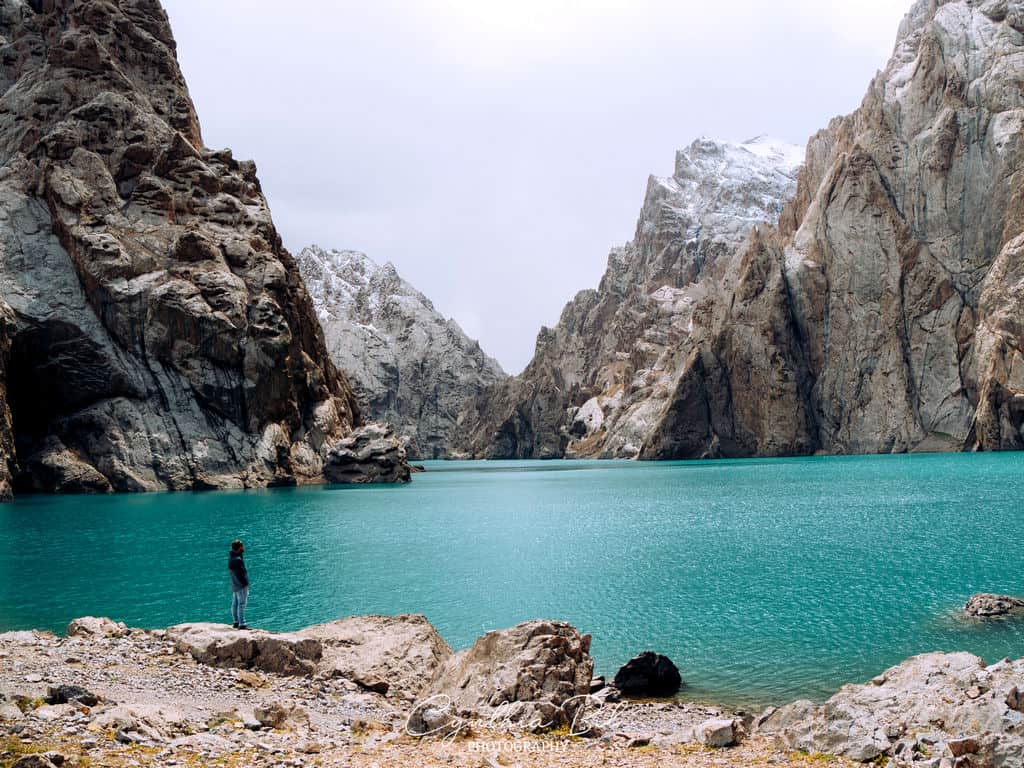
Kyrgyzstan is also a land of nomads who still strongly value their centuries-old nomadic traditions.
They are expert horsemen and national games in which they demonstrate their equestrian skills, such as Dead Goat Polo , which are an integral part of the Kyrgyz culture.

If you like being in the wilderness and you’re interested in learning more about the nomadic lifestyle in Central Asia, then you’ll absolutely love Kyrgyzstan! It’s one of the few off-the-beaten-path countries where you can still get a taste of the authentic nomadic culture.
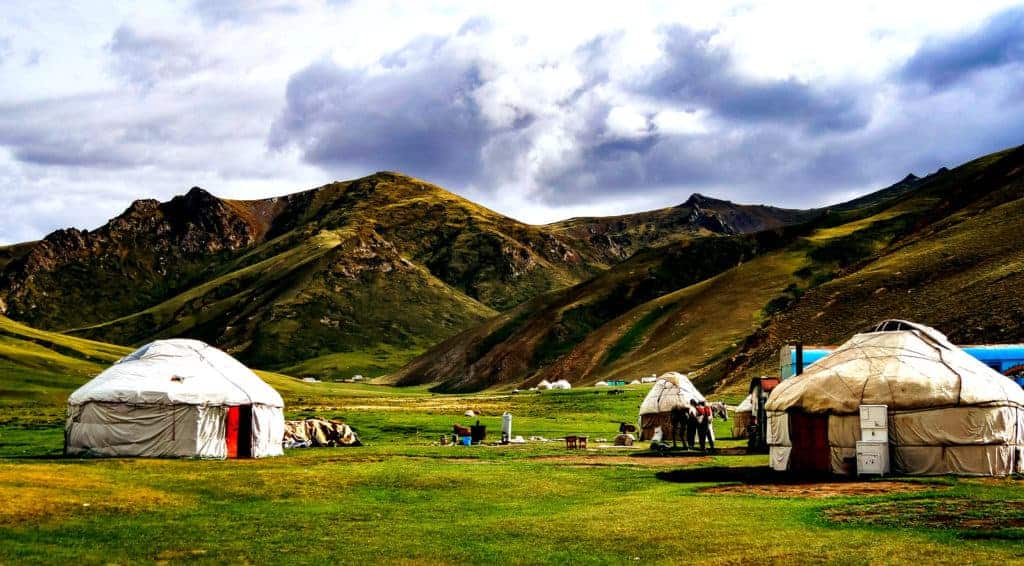
I lived and traveled in Kyrgyzstan for 11 months and keep returning yearly to organize adventure tours and explore new destinations in the country. I consider it as my second home.
At this point, I’d say I became an expert when it comes to Kyrgyzstan travel and like to share my love for it with you.
This Kyrgyzstan Travel Guide brings together all my knowledge and experience. I cover everything from visas, entry requirements and safety to transport, accommodation, food, useful apps and cultural etiquette to help you prepare your Kyrgyzstan trip to the fullest!
Are you looking for a customized guided tour in Kyrgyzstan and/or other countries in Central Asia ? Do you need help planning your itinerary ?
Have a look at my C e n t r a l A s i a tour and itinerary planning services !
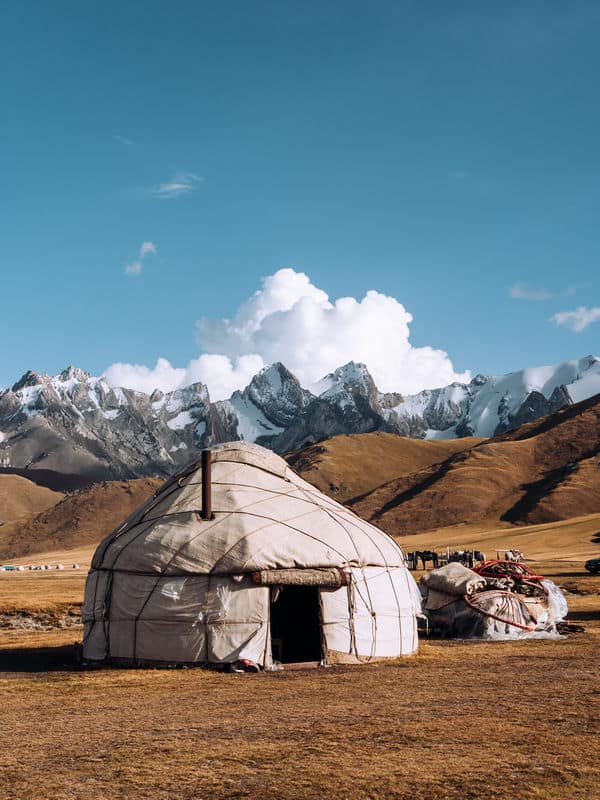
Disclaimer: This posts might contain affiliate links, meaning that if you make a purchase through these links, I may earn an affiliate commission. Thank you for helping to support this website!
Kyrgyzstan Travel Essentials
- 20 things you need to know before traveling to Kyrgyzstan
- The 25 best places to visit in Kyrgyzstan
- The top 28 things to do in Kyrgyzstan
- The 14 best hikes & treks in Kyrgyzstan
- The 9 best horse riding destinations in Kyrgyzstan
- Kyrgyzstan Budget Guide
- Kyrgyzstan Adventure Tours & Kyrgyzstan Tour Planning
- Visa: Required Kyrgyzstan travel documents
- Getting there: Search for flights to Bishkek or Osh
- Where to stay : Find a yurt camp,homestay, hotel, hostel or guesthouses
- Travel Insurance: Choose the best travel insurance for Kyrgyzstan
TABLE OF CONTENTS
1. Visiting Kyrgyzstan in 2024 – Kyrgyzstan Entry Requirements
1.1 kyrgyzstan covid requirements.
Travelers can now enter Kyrgyzstan without a negative PCR test of proof of vaccination. There are also no restrictions anymore within the country.
1.2 Kyrgyzstan Vaccination Requirements
You don’t need any mandatory vaccinations to travel to Kyrgyzstan.
Vaccinations for Hepatitis A and Typhoid are recommended, especially if you are visiting smaller cities or rural areas, or if you are an adventurous eater.
The government of Kyrgyzstan requires proof of yellow fever vaccination only if you’re arriving from a country with a risk of yellow fever.

2. Do I need a visa to travel to Kyrgyzstan?
Kyrgyzstan has the most liberal visa regime in Central Asia. Citizens from Europe, North America, Australia, New Zealand, Japan, South Korea, Singapore, Brunei, Qatar, Bahrain, Kuwait, UAE and Saudi Arabia can visit the country for up to 60 days within 120 days without a visa .
Citizens from Mongolia and Ukraine can stay up to 90 days within 180 days without a visa and citizens from Malaysia and Turkey are allowed to stay visa-free in Kyrgyzstan for up to 30 days .
Travelers from Armenia, Azerbaijan, Belarus, Cuba, Georgia, Japan, Kazakhstan, Moldova, North Korea, Russia, Tajikistan, and Vietnam can stay for an indefinite time !
All the other countries have to obtain a visa. Check this website to see what visa you’re eligible for.
Since 1 September 2017, the Ministry of Foreign Affairs of Kyrgyzstan has launched the e-Visa system , for which you can apply here . The e-visa for Kyrgyzstan costs US$61 and it takes about one week to get it.
However, sometimes these things take longer in Kyrgyzstan so apply at least one month ahead to be certain! Some nationalities will also need a Letter of Invitation (LOI) while applying for the visa.
You can check your visa requirements for Kyrgyzstan here:
Can I extend my Kyrgyzstan visa?
It used to be possible to renew the Kyrgyzstan visa by doing a visa run into one of Kyrgyzstan’s neighboring countries. However, the law changed in October 2023 and visa runs aren’t possible anymore.
If you want to stay longer than 60 days within 120 days or 90 days within 180 days, you’ll need to apply for an e-visa or visit a Kyrgyz Embassy outside of the country. Almaty in Kazakhstan is probably the best place to apply for a new visa.

How to renew your Kyrgyzstan visa
What happens if I overstay my Kyrgyzstan Visa?
If you’re overstaying , you need to pay a fine and get an exit visa at the Department of Registration located at 58 Kievskaya street in Bishkek. The total cost of overstaying is currently around $60 USD.
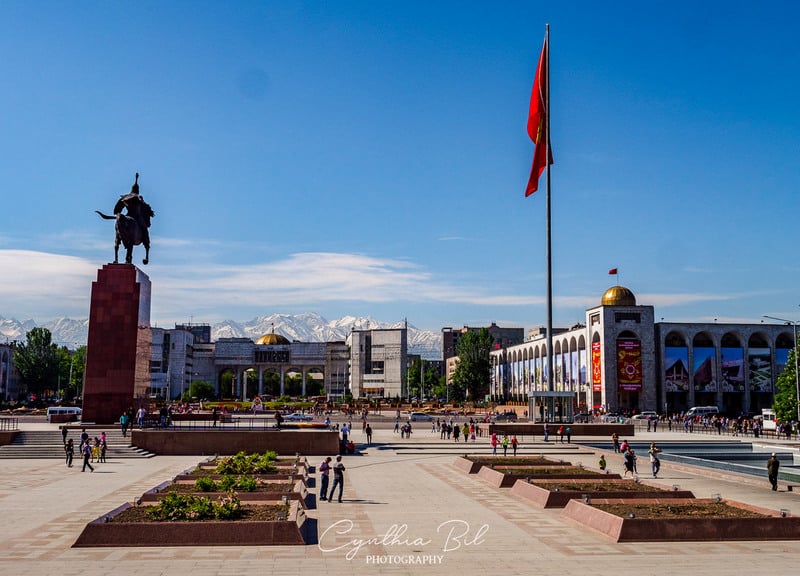
3. When is the best time to visit Kyrgyzstan?
The best time to visit Kyrgyzstan is from late spring (mid-June) to early autumn (end of September) if you want to do some hiking and horseback treks in the mountains and stay at the yurt camps of the Kyrgyz nomads.
However, you can visit Kyrgyzstan all year round, depending on what you want to see and do during your trip.
3.1 Why Is summer the best time to visit Kyrgyzstan?
Summer (July and August) is the high season in Kyrgyzstan.
This is the time when all the mountain passes are accessible so ideal if you want to go for day hikes or multiple day-treks, camping, mountain biking, or horse riding.
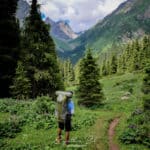
The Complete Trekking Guide to Kyrgyzstan with the best day hikes and treks

Summer is also the time of the year when the semi-nomads have their yurt camps set up in the jailoos (summer pastures) so their herds of sheep, goats, horses, and cows can graze freely in the wild. They often have an extra yurt available for travelers and tourists.
If you like to stay with a semi-nomadic shepherd family and learn more about their daily life in the mountains, then summer is the best time to visit Kyrgyzstan!

Many folkloric events and national festivals are being held during summer. The most popular ones are:
- The National Horse Festival in July during which skilled horsemen love competing in various horse games.
- The Birds of Prey Festival in August, during which Golden Eagle Hunters take part in contests. Horse games and folkloric shows are also part of the festival
- The Kyrgyz Kochu Festival, also an event celebrated in August, marks the annual migration of the nomadic shepherds and their flocks from the high summer pastures to the lowlands in winter. Horse games, national games and folk music are the highlights of this festival.
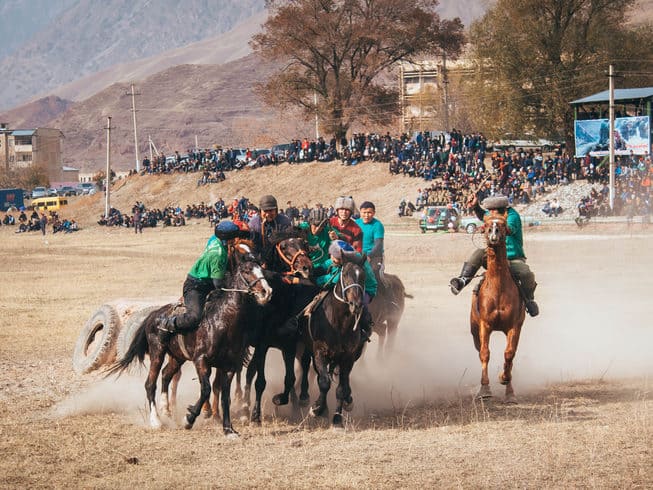
3.2 Are spring and autumn a good time to visit Kyrgyzstan?
Late spring (end of April – June) and early autumn (mid-September – October) are also still good times to visit Kyrgyzstan.
Not all mountain passes will be accessible and you won’t see many yurt camps (only yurt camps belonging to local tour companies stay from mid-May to end-September) but you can still visit some beautiful places and go hiking in the lower mountains.
Places in Kyrgyzstan that are worth visiting in spring and/or autumn:
- The stunning lakes at Sary Chelek National Park
- Hiking or horse riding in the Lower Alay Mountains
- Participating in the walnut harvest in Arslanbob in October
- Enjoying the first (or last) summer vibes at Lake Issyk Kul
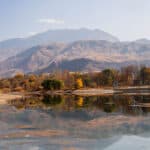
9 places to visit in Kyrgyzstan in spring and fall, including best hikes
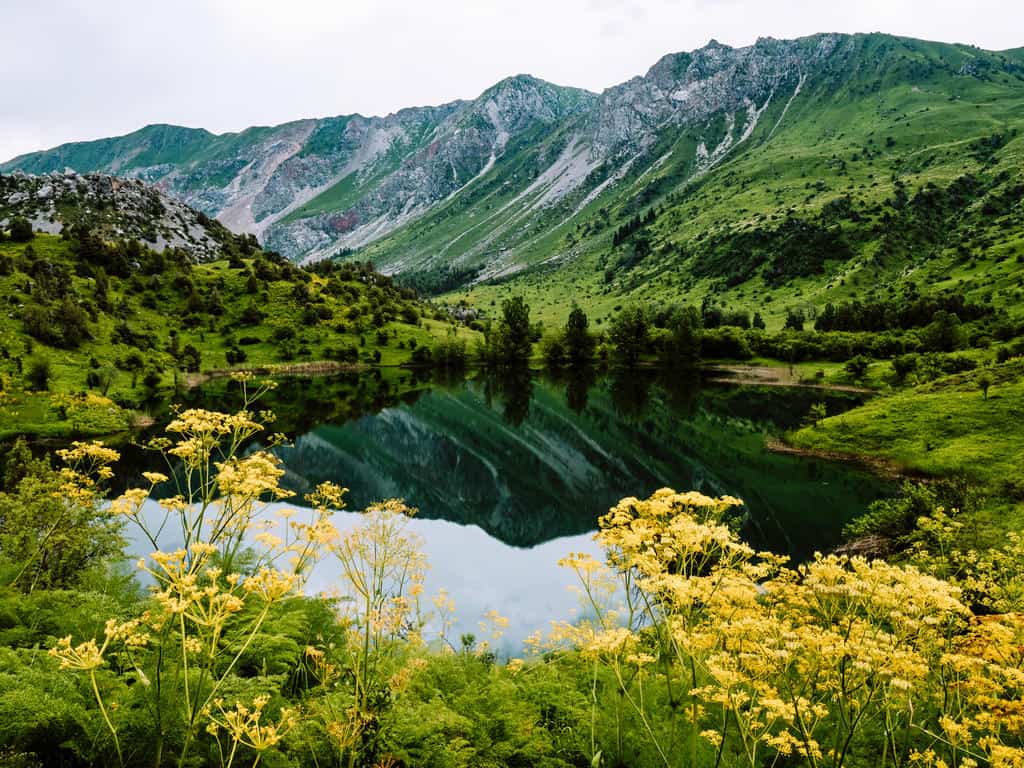
3.3 Should I visit Kyrgyzstan in winter?
Winter (November – March) in Kyrgyzstan is usually very cold (-25°C or lower in the mountains) and most mountainous places aren’t accessible.
But if you don’t mind cold and you love skiing and snowy landscapes, then traveling in Kyrgyzstan during the winter will be a unique and magical experience!
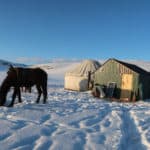
- 6 reasons why you should visit Kyrgyzstan in winter

One of the top things to do in Kyrgyzstan in winter is skiing!
There are about 20 ski resorts in Kyrgyzstan with Karakol being one of the best ski resorts in Central Asia. For more information, read The Complete Guide to Skiing in Kyrgyzstan.
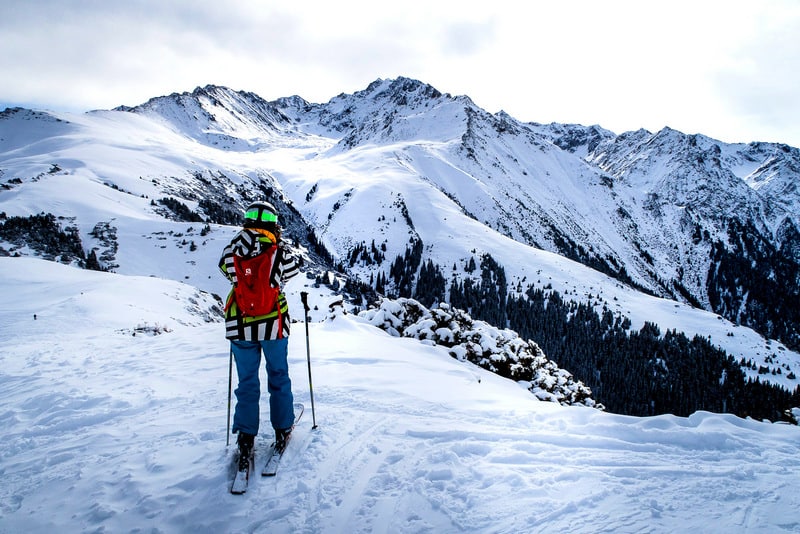
While some areas might be harder or impossible to access when it snows, it doesn’t mean that there’s nothing to do in Kyrgyzstan during the winter.
Here are some options:
- going on a horseback trek to Son Kul lake in winter
- bathing in the hot springs in Altyn Arashan
- witness the golden eagle hunters in full action as the hunting season starts in late October and lasts until the end of February
- go paragliding and cat skiing in Jyrgalan

1 0 – d a y I t i n e r a r y t o v i s i t K y r g y z s t a n i n w i n t e r

If you want my help with planning a customized itinerary and activities suitable for the season you’re traveling to Kyrgyzstan, don’t hesitate to contact me !
4. Where should you go in Kyrgyzstan?
There are so many beautiful places to visit in Kyrgyzstan that you could easily spend months in the country! It also depends on your interests and preferences.
Kyrgyzstan isn’t a destination for urban exploration like its neighbor Uzbekistan . With the exception of Bishkek , Osh and Arslanbob , most towns and cities aren’t really that interesting to visit. The most interesting places are found in the countryside and mountains.
If you’re interested in historical and world heritage sites, then you should definitely visit Burana Tower , Tash Rabat, and Sulaiman Too Sacred Mountain .

If you love nature, mountains, and alpine lakes, then you can’t miss out on the areas and lakes of Kel Suu , Son Kul , Ala Kul , Issyk Kul and Sary Chelek .
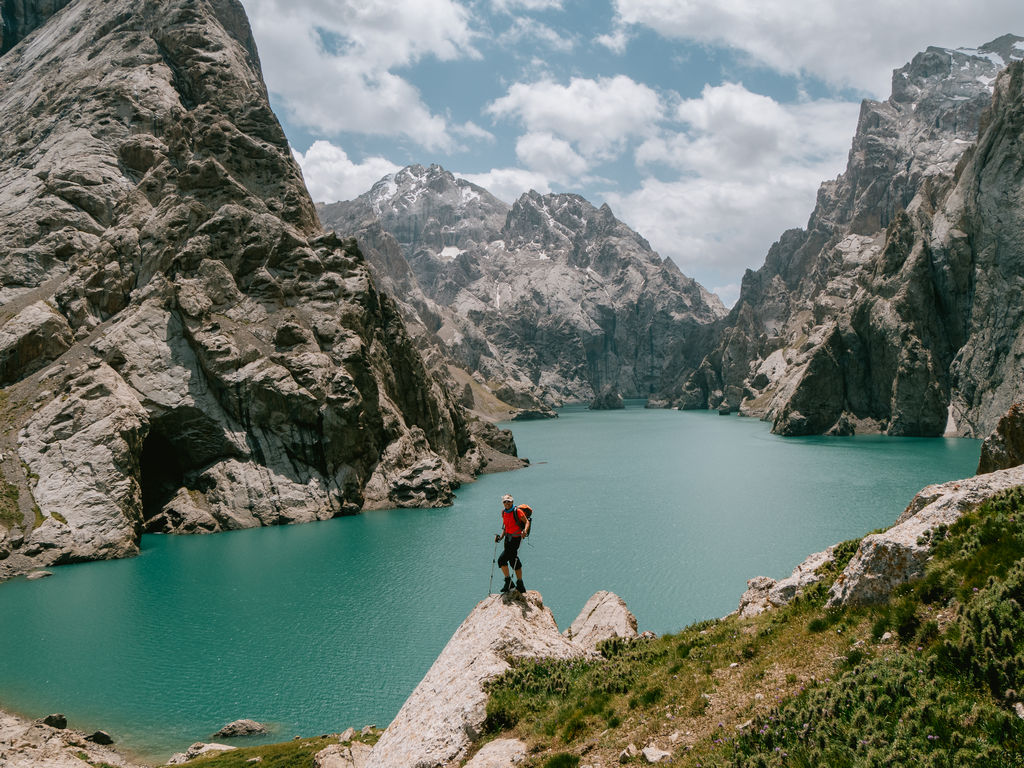
However, there are many more stunning places to visit in Kyrgyzstan than only the few I mentioned above.

The 25 most beautiful places to visit in Kyrgyzstan

5. What are some fun things to do in Kyrgyzstan?
Kyrgyzstan offers a wide variety of cultural and outdoor activities. Try to put at least one of the following in your itinerary to experience what Kyrgyzstan is all about:
- Go for a hike in the mountains . Kyrgyzstan is one of the top trekking destinations in the world! Even if you’re not super fit, there are still some beautiful day hikes you can do without breaking too much of a sweat.
- Go horse riding . Horses play a central part in the daily life of the Kyrgyz people and horse treks are one of the highlights when traveling in Kyrgyzstan.
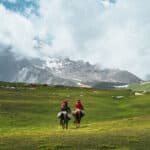
The Complete Guide to horse riding in Kyrgyzstan with the best horse riding destinations
- Sleep in a yurt camp. Experiencing the nomadic life in Kyrgyzstan will be another highlight of your visit to Kyrgyzstan. I’ll share more details about staying at a yurt camp below in the section Where to stay in Kyrgyzstan
- Attend a folkloric festival with national horse games . The nomadic games in Kyrgyzstan are a must-see! However, it’s not always clear when or where these festivals are going to happen. I got lucky to be a few times at the right place on the right moment. The best place where you might get to see a spontaneous game of Kok Boru would be at Son Kul lake.
- Participate in a cultural workshop to learn more about yurt building, felting or cooking a traditional meal. The best place for this is on the southern shore of lake Issyk Kul.
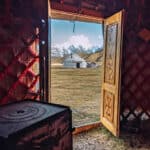
T h e 2 8 Top Things to do in Kyrgyzstan
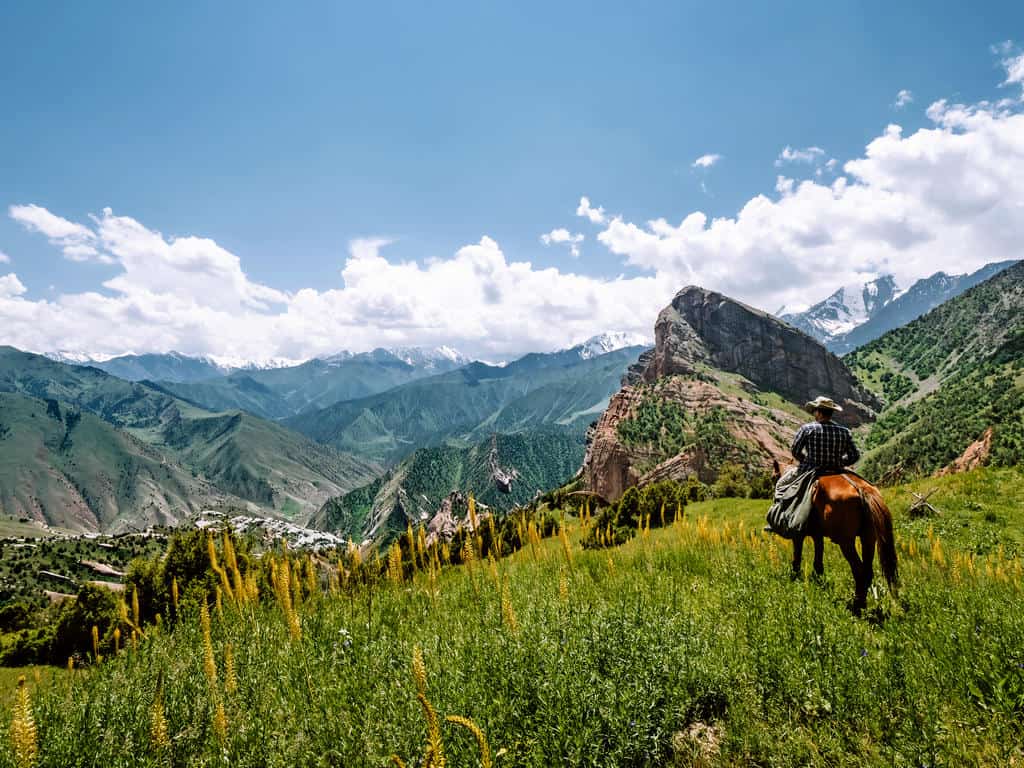
6. Kyrgyzstan Travel Insurance
It’s not mandatory to have travel insurance to travel to Kyrgyzstan but I highly recommend getting one if you’re planning on hiking , skiing or horseback riding in the mountains.
An accident can happen fast and it’s better to be fully insured to avoid expensive medical costs.
I highly recommend the backpacker insurance provided by HeyMondo as it covers adventurous activities such as horse riding, skiing and trekking at high altitude. Read here for all info and details.
Need Travel Insurance for Central Asia ? I use and highly recommend HeyMondo Travel Insurance . As a reader of Journal of Nomads, you get a 5% discount off your insurance plan!

The 3 best budget-friendly travel insurance companies
7. How to get to Kyrgyzstan
7.1 where do you fly into for kyrgyzstan.
Kyrgyzstan has two international airports.
Manas Airport (FRU) in Bishkek, the country’s capital city, is the largest international airport in Kyrgyzstan.
There are a number of airlines that fly into Bishkek. I recommend Turkish Airlines or Pegasus (via Istanbul ) or Fly Dubai (via Dubai), depending on where you’re flying from. Search for the best deals here .
Osh Airport is a small international airport in the southwest of the country with about 30 international flights per week, mainly to and from Tashkent (Uzbekistan) and Moskow (Russia).
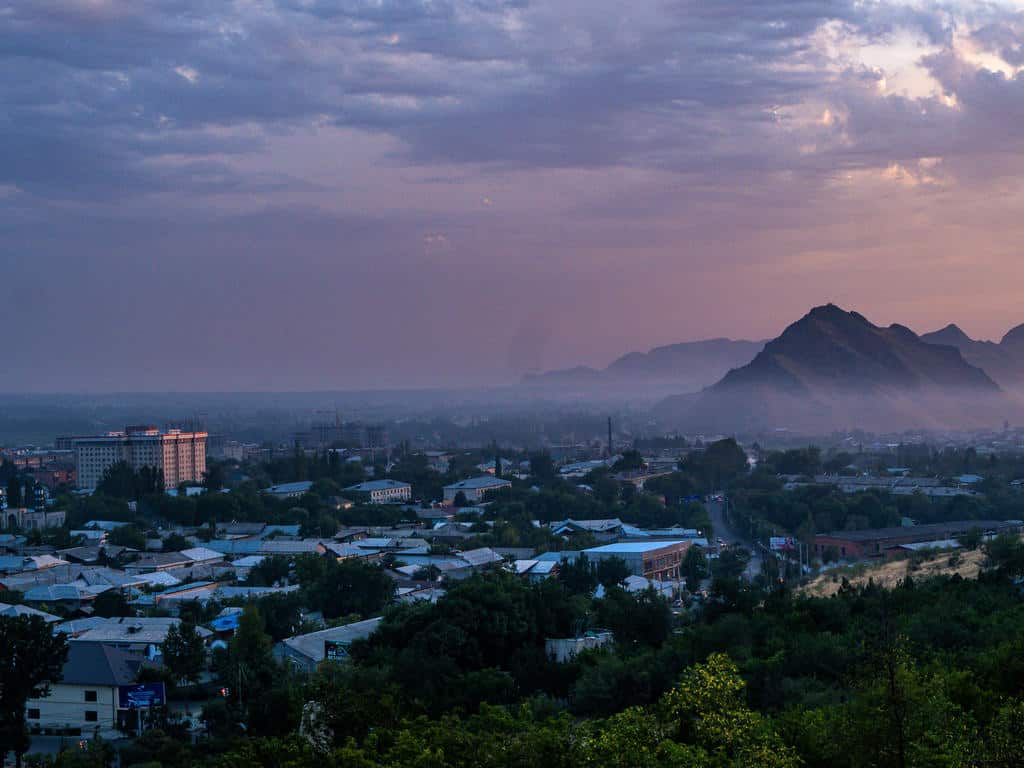
How to get from Bishkek Airport to the city
Bishkek airport is a 30-minute drive from the city center
The standard rate for a taxi from the airport to the center of Bishkek is between 600 and 800 Kyrgyz Som (KGS) – around $7 to $10 USD -, depending on the taxi company.
Most likely you’ll be welcomed by many taxi drivers who’ll be eager to give you a ride for double the standard rate. Insist on paying not more than 800 som. If they don’t accept, walk away and you’ll find a taxi driver who will drive you to the city center for the standard price.
You can also look for a taxi company named BTaxi right outside the airport exit or Manas Taxi on the 1st floor of the airport. Those are both trustworthy companies that work with a fixed rate of 600 som.
There are ATMs at the airport where you can withdraw the money needed for the taxi. You can withdraw more money or exchange currencies once you’re in Bishkek to avoid the expensive fees at the airport (see the section exchanging money in Kyrgyzstan).
You can also take marshrutka #153 or #380 (minibus) from the airport to Bishkek. They run daily from 6.30 am to 8 pm, the ride to the city center takes about 50 minutes and costs 40 KGS .
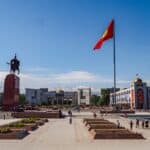
13 Top Things to do in Bishkek – Bishkek Travel Guide
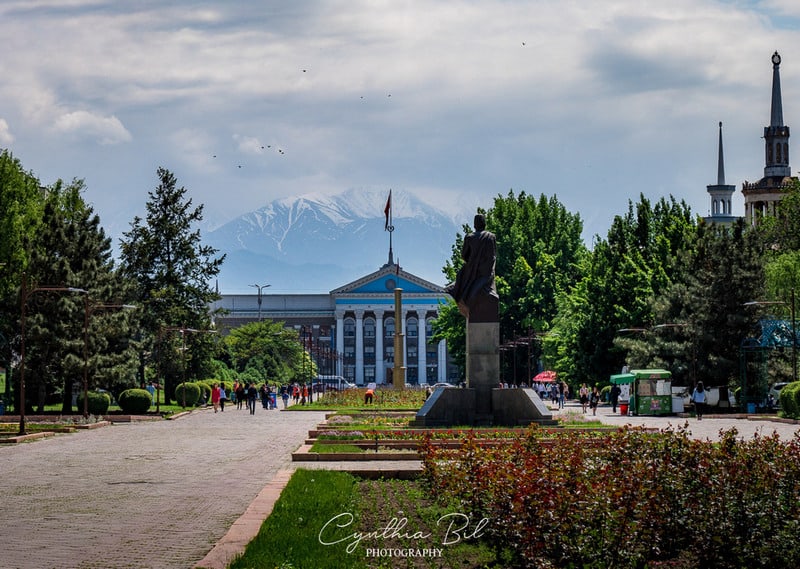
How to get from Osh Airport to the city
Osh airport is a 10-minute drive to the city center of Osh. A taxi from the airport costs 300 KGS .
You can also take marshrutka #107a and #142a , the minibus that goes daily from the airport to the city center. It costs 10 KGS .
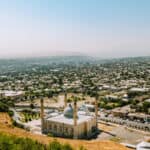
1 4 Top Things to do in Osh – Osh City Guide
7.2 How to travel to Kyrgyzstan by road
You can enter Kyrgyzstan overland from China, Kazakhstan , Uzbekistan and Tajikistan .
You can usually enter Kyrgyzstan overland by bus, mashrutka (minivan), shared or private taxi or self-driving.
If you’re driving with your own vehicle, you need vehicle insurance and sometimes a special permit to cross borders. You also need to pay an eco-tax if you arrive from Uzbekistan, Tajikistan or China but you don’t need to pay import tax or have a customs-cleared document.
- Kyrgyzstan’s land borders with China are currently still closed for tourists. The land borders with Kazakhstan, Tajikistan and Uzbekistan are open.
There are 2 open borders between Kyrgyzstan and China. The busiest and easiest border crossing is in Irkeshtam . Crossing at Torugart requires paying for an expensive, certified Chinese guide. This border is also often closed in winter.
From Tajikistan
There are 3 open borders between Kyrgyzstan and Tajikistan. The most popular one is in Kyzyl Art but you’ll need a GBAO permit to travel along the Pamir Highway. There are also borders in Kulundu and Isfara where you don’t need a permit.
From Uzbekistan
The easiest border to cross from Uzbekistan into Kyrgyzstan is at Dostyk , near the city of Osh. A mashrutka or taxi will drop you off at the border on the Uzbek side, you cross on foot and then you can take a taxi or mashrutka to Osh on the Kyrgyz side.
You can also travel directly from Tashkent (Uzbekistan) to Bishkek by bus or from Tashkent to Osh by train and bus .
From kazakhstan
There are 5 open borders between Kazakhstan and Kyrgyzstan. The easiest border to cross is at Kordai , near Bishkek. Here’s how to get from Almaty (Kazakhstan) to Bishkek by public transport .
There’s also a very small border at Karkyra near Karakol. This border is only open from May to October and most suitable if you’re self-driving.
There are no marshrutkas or shared taxis going to this border. Going there by private taxi easily costs $50 – $100 and you’ll be stuck at the Kazakh side unless you don’t mind hitchhiking.
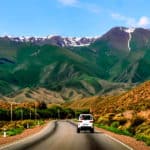
How to travel overland from Europe to Asia

8. Is Kyrgyzstan a safe country to visit?
Kyrgyzstan is absolutely a safe destination for tourists!
I dislike how most websites from the Departments of Foreign Affairs advise against traveling to Kyrgyzstan as it’s supposedly dangerous and how there’s a chance for terrorist attacks and kidnapping…
Terrorist attacks can happen everywhere, even in Europe! Remember what happened in Paris and in Brussels a few years ago…
And yes, the Kyrgyz people might kidnap you into their homes and force-feed you. But you’re free to leave whenever you’ve finished your plate.
I have never questioned my safety in Kyrgyzstan before, not even while I was traveling as a woman alone.
I went several times into the mountains with only male guides and companions. They cooked for me, helped me whenever I was struggling, they often checked if I was ok and some even called me “chef”. They cared for me like I was a princess.
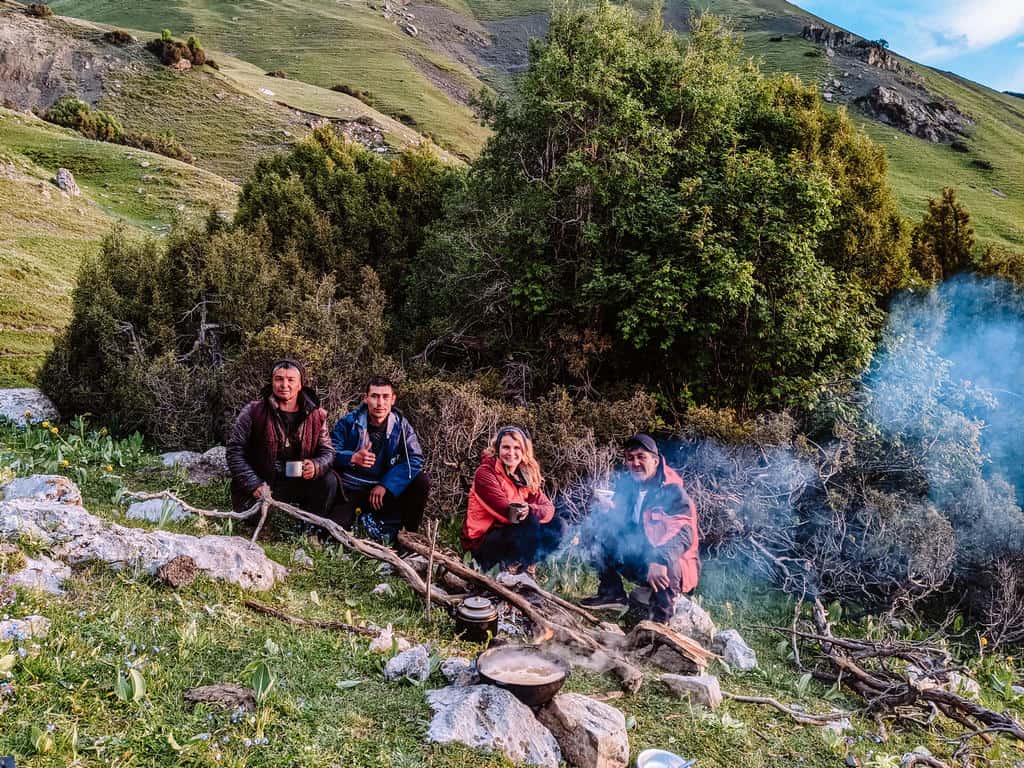
If you’re a woman traveling alone or with a girlfriend, you’ll get approached by men (and women) asking if you’re married. 9,8 times out of 10 they don’t ask this because they’re after you.
Marriage and having children are very important in the Kyrgyz culture so it’s a very commonly asked question. The same as when people would ask about your job in Western countries.
The men, and in general the people of Kyrgyzstan, are in my experience gentle, friendly, and kind. They also have big respect for women. There’s always an odd duck, but that is something you encounter in every destination.
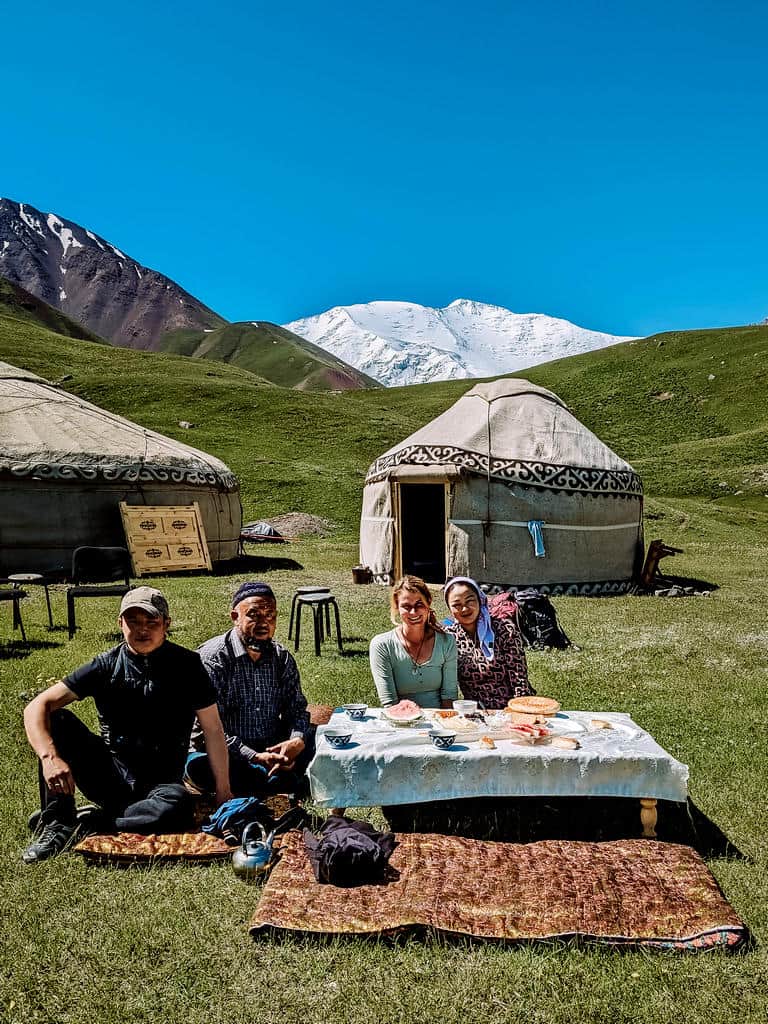
You also don’t have to worry about scams . Most markets and shops have standard prices so bargaining is also not really a thing in Kyrgyzstan (but you could always try).
You only have to watch out for taxi drivers. They tend to higher their prices when they see you’re a tourist. Inform yourself about taxi rates beforehand and don’t be afraid to bargain or walk away if you have the feeling they’re ripping you off.

Is Kyrgyzstan safe? 15 usefult things to know before you go
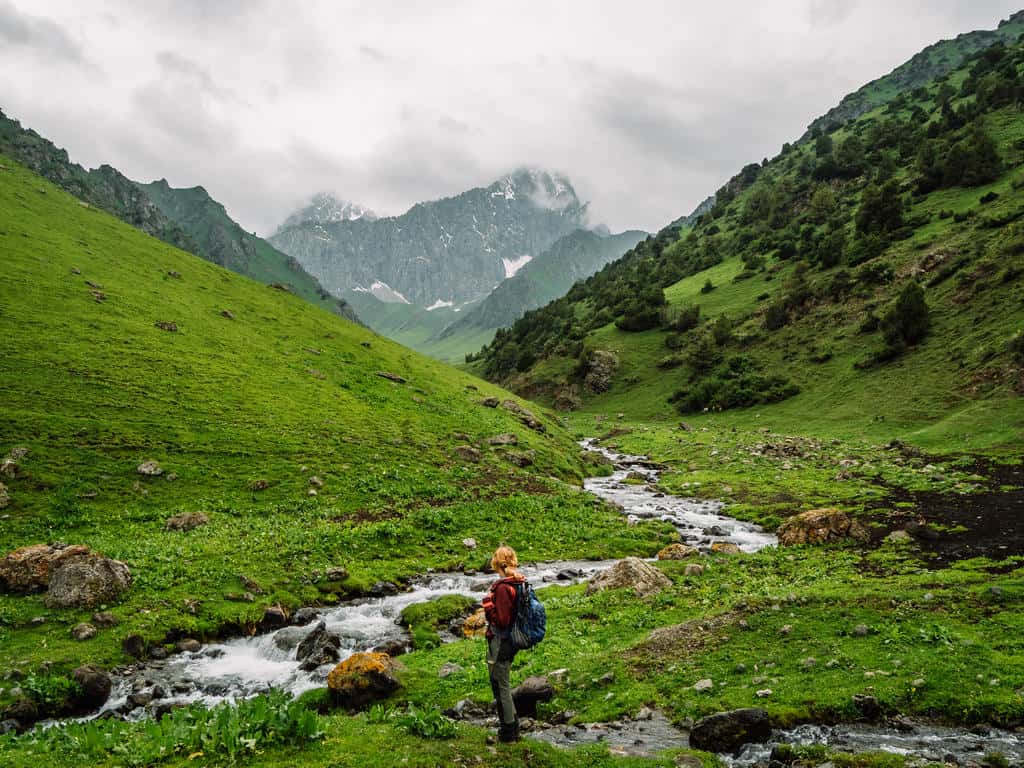
9.2 Which credit cards are accepted in Kyrgyzstan?
Visa is the most accepted credit card in Kyrgyzstan and you can use it in most restaurants, shops, and hotels in the larger cities in the country (Bishkek, Osh, Karakol, Jalal-Abad).
MasterCard and other credit cards are accepted in some places in Bishkek and Osh but you’re better off using Visa.
Cash is still king in Kyrgyzstan and you should definitely carry enough cash with you to cover your expenses when leaving the cities.
9.3 ATMs in Kyrgyzstan
You’ll find plenty of ATMs in the cities where you can withdraw KGS and in some cases USD. It’s not possible to withdraw other currencies. Most ATMs only accept Visa.
My go-to bank is Demir Bank as they accept both Visa and MasterCard and KICB .
Most ATMs have a withdrawal limit of 20.000 KGS or 200 USD. Fees may be added by your home bank.
9.4 Exchanging money in Kyrgyzstan
USD, EURO, and currencies from the neighboring countries like Uzbekistan and Kazakhstan are accepted everywhere, other currencies might be harder to exchange.
The best place to exchange currency in Kyrgyzstan is in Bishkek . There are many currency exchange offices in Bishkek but the ones with the best exchange rate are on Manas Avenue, between Sierra Coffee and Chuy Avenue. Those offices might look small and dodgy but they’re trustworthy.
You can also exchange currency in banks but they usually offer a lower rate and you’ll also need your passport as the banks ask for it.
You can also exchange currency in Osh. The best place in Osh to exchange currency is at one of the small exchange offices at the big market called Kelechek.
Tip: Use big 50 or 100 EURO or USD bills and make sure they are crisp and not damaged or wrinkled otherwise the offices will exchange at a lower rate.
9.5 How much money do you need in Kyrgyzstan?
Kyrgyzstan is a cheap country to travel and one of the cheapest in Central Asia.
If you’re backpacking on a tight budget, you can get by with a daily budget of 50 USD if you’re only taking public transport, staying in homestays, cheap hostels or camping, eating in local restaurants, or buying food at the markets and sticking to free activities.
If you’re a mid-range traveler, meaning you have a budget to cover additional activities and day tours such as horse riding and visiting historical sites and you want to combine public transport and private taxis, stay at guesthouses and yurt camps, and eat at budget and/or mid-range restaurants, you’ll get by with a weekly budget of 850 USD .
If you like to stay at a yurt camp, you’ll nowadays pay around 20 USD per person night, including breakfast and dinner.
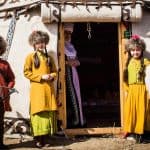
Kyrgyzstan Money Guide: How much does it cost to travel and live in Kyrgyzstan

9.6 Should you tip in Kyrgyzstan ?
Tipping is not part of the culture in Kyrgyzstan and is therefore not required.
Restaurants in the larger cities usually include a 10-15% service fee in the bill.
When you go on a tour, you’re also not expected to pay an extra tip to the guide, driver, horsemen, or porters afterward. However, they will appreciate it as wages are low in Kyrgyzstan.
If you’re happy with the services of your driver, guide,…, and you like to tip them after the trip, I’d use the 10-20% rule as a tipping guide.
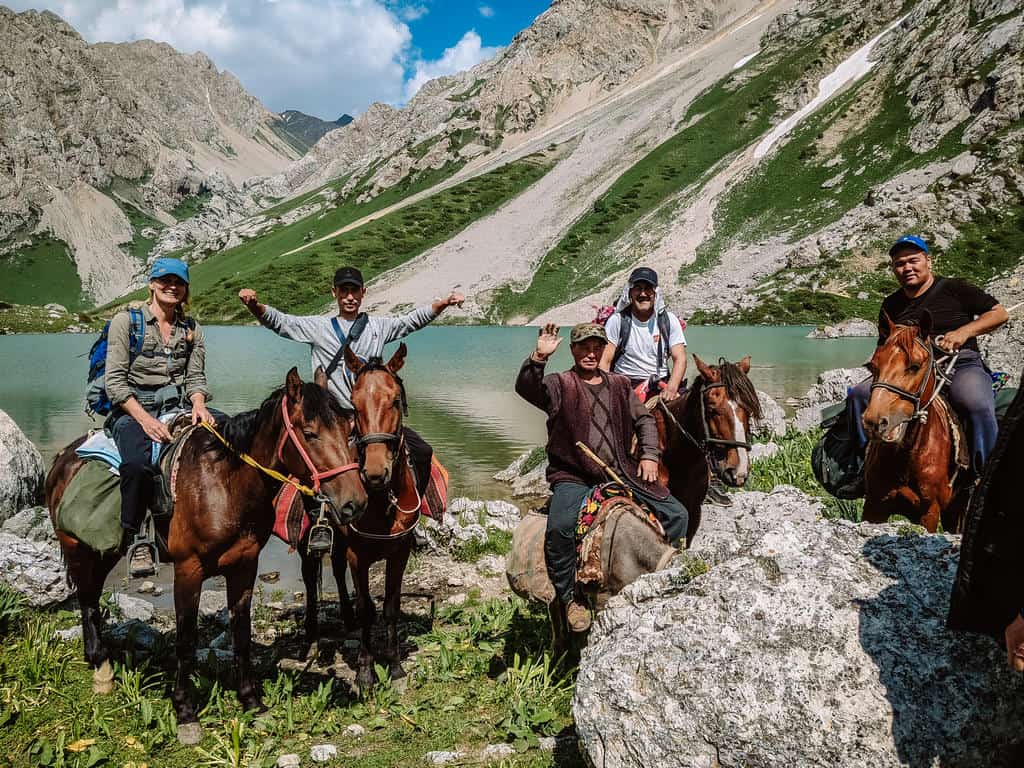
10. Transportation in Kyrgyzstan : How to get around in kyrgyzstan
You can get around in Kyrgyzstan by marshrutka (minibus), bus, (shared) taxi, train, and airplane.
10.1 Getting around Kyrgyzstan by minibus (marshrutka)
A marshrutka is a minibus that looks like a van and it’s the cheapest and most popular way for the locals to get around in Kyrgyzstan.
It’s very easy taking a marshrutka to get around in a city or town or to travel between two different towns. While it’s not the fastest way to get around as these minibusses stop everywhere, it’s definitely a cultural experience!
Taking a marshrutka within a city
Every marshrutka has a number. It’s sometimes a little confusing which one you have to take so ask at your hostel or hotel which one you need or use the apps Bus.kg and Maps.Me to find your way around.
Bus.kg tells you the route of each marshrutka. Maps.me is easier to use as you just type in the name of your location and destination and it shows you which marshrutkas are going there.
Marshrutkas don’t have a fixed time schedule but you’ll find them everywhere! Just stand on the side of the road and wave them down. The driver will stop for you.
You pay the driver as soon as you get in the van. The standard price for a ride within a city or town is 10KGS .
If you want to get off, move towards the front of the minibus (use your elbows if needed as it can get very crowded in there) and ask or sign the driver to stop.
Tip: When you see someone visibly older than you getting on the marshrutka, give up your seat voluntarily if you want to avoid a scene. Especially the old ladies can give you a lot of trouble if you don’t want to stand up for them. They might look old and sweet but they can be fierce!

The Kyrgyz women are the sweetest until you refuse to give up your seat for them…
Taking a marshrutka between towns and cities
If you want to travel between towns and cities, you can take a long-distance marshrutka. You can find them at the bus stations. Just go to the station and say where you want to go.
People will show you the ticket office where you have to pay for your ticket and they will also point you in the direction of the marshrutka you need.
The prices depend on how far you want to go and how popular the route is but the average price is around 300KGS for a 4-hour ride.
After paying for your ticket, you’ll receive a receipt that you have to show the driver before you get on the marshrutka. The minibus leaves when it’s full.

10.2 Getting around by shared taxi
Another common way to get around Kyrgyzstan is by shared taxi.
Sharing a taxi means that you share the car with other people and you split the costs so you pay per seat. It’s about twice or triple the price of a marshrutka but a faster way to get around.
Some taxi drivers like to double the rate for unwary tourists so if you don’t want to get ripped off, make sure that:
- you make it clear that you want to share the taxi (say ‘taxi sovmesti’) so you don’t pay the full price and
- ask your hostel/hotel about the rates or ask the other passengers how much they pay.
The standard price for a long-distance ride should be between 800KGS and 1200KGS per person.
The best way to get from Bishkek to Osh (or vice versa) is by shared taxi. For this 12-hour ride, you pay around 1500KGS per person.
If you want to take a taxi within Bishkek and you can’t be bothered by bargaining for the price, install the Yandex Go app on your phone ( only possible when you have a local SIM card) . This app works similar to Uber .
10.3 Getting around by train
There are very few trains in Kyrgyzstan due to the mountainous terrain of the country. There’s a railway route that goes from Bishkek to Balykchy (Issyk-Kul).
It’s a very scenic train ride that brings you to the western shore of Lake Issyk-Kul but it’s very slow (5-6 hours) and only runs during the summer.
For prices and timetables, check with the train station in Bishkek.

10.4 Domestic flights in Kyrgyzstan
If you’re in a hurry and you don’t want to make the long drive from Osh to Bishkek or vice versa, then there’s always the option of taking an airplane between both cities.
There are daily flights between Bishkek and Osh, the flight itself lasts 45 minutes and a one-way ticket costs around $50. You can book tickets on this website .

10.5 Hitchhiking in Kyrgyzstan
Hitchhiking in Kyrgyzstan is quite common among the locals.
You’ll see a lot of people standing on the side of the road, waving cars down as a sign that they want to get a lift but it’s standard to pay the driver to share the costs of the petrol for the journey (very similar to taking a shared taxi).
So it’s not really hard to hitchhike in Kyrgyzstan, the challenge is in finding a FREE ride.

The Pleasant and Unpleasant Surprises of Hitchhiking in Kyrgyzstan
10.6 Driving in Kyrgyzstan
Self-driving in Kyrgyzstan is definitely an option if you want to travel to remote places. It’s often difficult to reach certain mountainous areas and alpine lakes by public transport.
The state of the main roads is generally good but as soon as you’re heading into the mountains, the condition of the tracks is variable. The roads can be deteriorated by potholes, bumps, and debris so drive carefully!
I recommend renting a 4×4 if you’re planning on driving in the mountains. Iron Horse Nomads and Travel L and Kyrgyzstan are the best car rental service to contact.
Note: some rental companies won’t allow you to drive to certain regions like Kel Suu lake as the road is in a bad state.
Driving rules in Kyrgyzstan:
- You need an international driver’s license and vehicle insurance.
- Drive on the right side of the road.
- The speed limit in towns or cities is between 40 and 60 km/h. The limit outside the cities is generally 80km/h.
- It’s mandatory to keep your low-beam headlights on, even during the day.
- Watch your speed as animals roam freely on the streets.
- Some police officers are still corrupt. If they’d fine you for speeding or any other reason, ask for a receipt first. You can also try to negotiate the price of the fine down to 1/4 or 1/2 but you won’t receive a receipt as the officer will pocket the money.

11. Tours in Kyrgyzstan
As you could read above, it’s possible getting around Kyrgyzstan by public transport but most places of interest in Kyrgyzstan are remote and can’t be reached by minibus or shared taxi.
If you have an adventurous spirit, you can try to reach these places by hitchhiking. But you’ll need time and patience as most places are so remote that there’s little to no traffic going there.
You can also try and find a private taxi to drive you and negotiate prices. But some destinations, such as Kel Suu lake , Altyn Arashan and Sary Jaz Valley simply can’t be reached without a 4×4. Even reaching the popular Son Kul lake requires arranging private transport.

Your best option is to arrange a private tour to get there.
Kyrgyzstan has a great Community-Based Tourism network, referred to as CBT, throughout the country. You’ll find a CBT office in nearly every major town that will connect you with local guides, drivers, homestays and yurt camps. The majority of their profit goes to the local communities.
While some CBT offices are great and professional, like the CBT in Osh and Arslanbob, others still require improvement when it comes to organization, availability and liability.
Some guesthouses also offer their own tours and guided (horse) treks so if you’re traveling independently and are interested in going on a small guided trip in the region, it’s worth consulting them as well.
There are also many independent tour guides and small local travel companies throughout the country that offer a wide variety of tours, from small trips to a certain area to fully-guided tours around the country.
If you don’t really know which one to contact, get in touch with me . Throughout my time in Kyrgyzstan, I worked with various small local travel companies and tour guides that were very professional and liable and I can connect you with the ones meeting your interests and needs.
And of course, I’m now briefly going to promote my own group tours in Kyrgyzstan .
Every summer, I organize a wide variety of tours, from Overland Road Trips and Adventure Tours to Trekking Adventures , Horse Riding Trips and Highlights of Kyrgyzstan Adventures , some of these tours guided by yours truly.
Would you love to go on an epic adventure on foot, on horseback or by 4×4 to the most beautiful places in Kyrgyzstan with a small group of adventurous travelers?
Check out my 6 Fantastic Kyrgyzstan Adventure Tours!
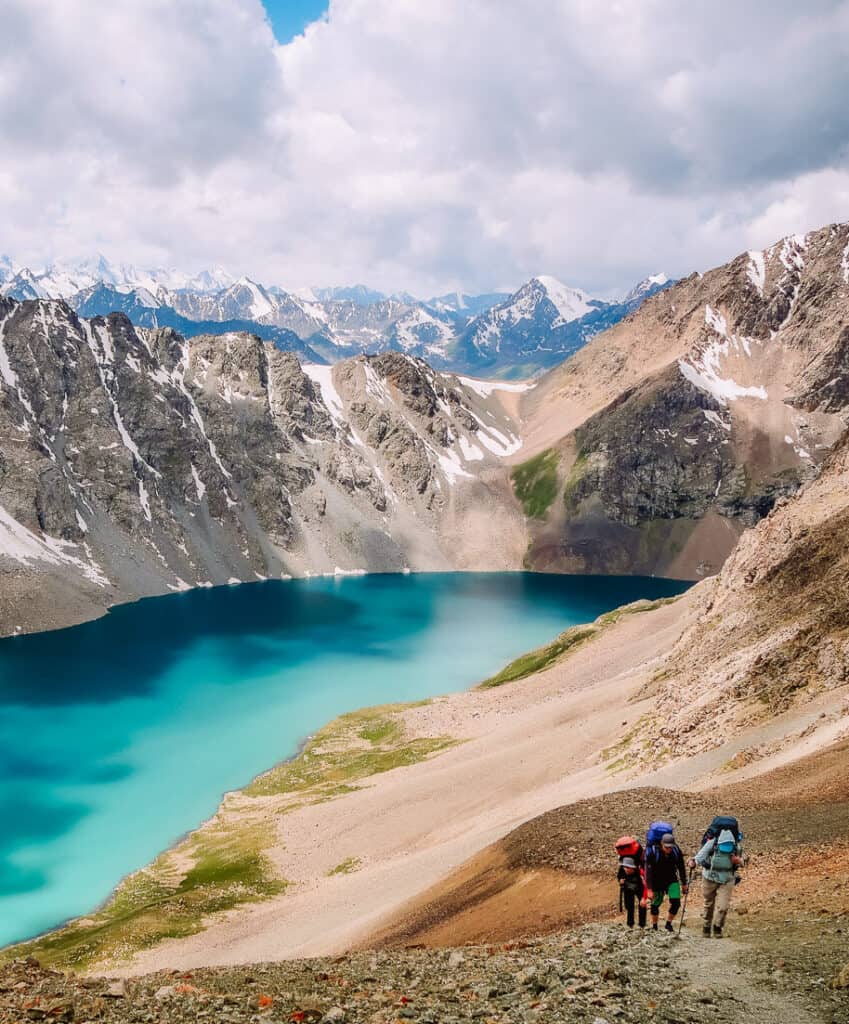
If group tours aren’t really your thing and/or you’d like to have a similar guided trip with your partner, friends, family or organization, I also offer tour planning services in Kyrgyzstan and/or can connect you to a suitable tour guide or local travel company.
12. Where to stay in Kyrgyzstan – Accommodation in Kyrgyzstan
12.1 hostels, hotels and guesthouses in kyrgyzstan.
There are plenty of hostels, hotels, and guesthouses in the big cities and major towns in Kyrgyzstan.
Hostels are the cheapest option, starting from $8 per night for a bed in a dorm . You can also find a nice private room, starting from 12 USD per night .
There are also some really nice hotels and guesthouses in Bishkek, Osh and other major towns, from mid-range to luxury. The average price for a room in a mid-range hotel usually costs around $30 per night.
I always use booking.com to find the best hostel and hotel deals.
12.2 Homestays in Kyrgyzstan
Staying with a local family in a homestay is a great opportunity to learn more about Kyrgyz daily life!
Kyrgyz families open their homes to foreigners who can stay for a night or more in one of the shared rooms in exchange for a fee, which varies from 500 to 1000 KGS per person per one night .
Don’t expect too much luxury, it’s after all a family home so it’s very likely that you’ll sleep on thick comfortable blankets on the floor like the Kyrgyz people do.
How to find these homestays?
Most homestays can be found through the CBT offices in the area. You can also just ask around in a town or village for a homestay (prozhivaniye v sem’ye) and the locals will bring you to one.
Nowadays, you can already book some of these homestays directly online: check out the homestays in Kyrgyzstan here .
Just remember that, even if someone invites you spontaneously to stay at their home, they will expect some kind of payment, whether it’s money or a gift.

12.3 Staying in a yurt in Kyrgyzstan
Yurts are one of the most essential parts of the Kyrgyz culture.
A yurt is a round tent, usually covered with felt or wool which are water repellent and warm and can be easily patched if needed. The top of the yurt is a wooden circle, called a tunduk, which forms one of the most essential symbols of family and the universe. The tunduk is also represented on the Kyrgyz flag.

While most of the Kyrgyz people nowadays live in houses or apartments, semi-nomadic shepherd families still move to the summer pastures during the warmer months where they live in yurt camps and tend to their herds.

During summer you’ll find many yurt camps across the Kyrgyz countryside. Staying in one of these yurt camps is definitely a must-try experience when traveling to Kyrgyzstan!
Many yurt camps in popular places like Issyk Kul and Son Kul are nowadays specially made to accommodate travelers.
The small yurt camps are family-owned, serving as an extra way of making an income for the shepherd families and still offer a one-of-a-kind experience. Others have been created by small travel companies and offer a more “luxurious stay” (you’ll still have to poo in a hole tho…).
You don’t necessarily have to book your stay in advance. You can just arrive and ask if they have a yurt available.
Here are some yurt camps you can also find online:
- Feel Nomad Yurt Camp at Lake Issyk-Kul.
- Yurt Camp Ali-Nur at Lake Song Kul
- Jeti Oguz Winter Yurt Camp near Karakol
- Yurt Camp Lenin Peak near the Pamirsky National Camp

If you’re seeking a more “authentic” yurt stay experience and want to participate in the daily life of a Kyrgyz shepherd family, you’ll have to travel to less touristic places such as the Alay Mountains .
Just remember that, even if the family invited you over to stay at their yurt, you’re still expected to give some form of payment (money or useful gifts such as food) as a sign of respect.

12.4 Camping in Kyrgyzstan
Wild camping is allowed in Kyrgyzstan as the camping spirit in the country is omnipresent, it’s the Land of Nomads after all.
You can set up your tent nearly everywhere and nobody will bother you. You also shouldn’t worry about any wild animals such as wolves, bears, or snow leopards unless you’re planning to go deep into the mountains. Just check with the local CBT to make sure…

In certain areas, such as in Arslanbob and Sary Chelek , you need to register at one of the local CBT (Community Based Tourism) offices and pay a small fee if you want to camp there.
However, don’t worry too much about this, just set up your tent and if you’re supposed to pay, someone will come and tell you.

13. Kyrgyzstan Food and drinks
Kyrgyzstan isn’t exactly a culinary destination like f.eg. Georgia . The food in Kyrgyzstan wasn’t love at first bite for me.
It’s not that it’s bad but I find often it a bit bland. Some dishes would be delicious with the use of extra spices.
However, you must know that the traditional dishes originate from the nomadic times and people had to manage with what was available, which was mostly meat and dairy products.
Nowadays, Kyrgyz food is a lot more varied, with lots of influences from China, Russia, Turkey, Tajikistan and Uzbekistan. Most meals consist of mutton, beef and chicken meat served in dumplings, noodles, rice, or alongside potatoes.
There are plenty of western and traditional restaurants in the major cities and local eateries in every town and village throughout the country. The food is mainly served with water or soft drinks. Soft drinks are served by the bottle, not by the glass.
Tea is available everywhere but if you’re a coffee-lover, you’ll have to be satisfied with instant coffee. You can find some good coffee bars in Bishkek, Osh and Karakol but expect to pay more when you order a proper espresso or cappuccino.
The best place to try Kyrgyz food is at a homestay where the family uses fresh ingredients and their own traditional family recipes.
At nearly every homestay or yurt camp, you’ll find small bowls with sweets, biscuits, bread and dried fruits on the table. You should definitely try the homemade butter, jam and clotted cream when available!

If you’re traveling during summer, you’ll find your dose of vitamins in the wide variety of yummy fruits and vegetables on the markets and small stalls at the side of the road.
In wintertime, there’s less choice but you’ll still be able to find tomatoes, carrots, cucumbers, apples, pears, etc.
13.1 5 Kyrgyz Dishes you have to try
Beshbarmak is the national food of both Kyrgyzstan and Kazakhstan as it originates from their shared nomadic past. The name means ‘five fingers’ because nomads traditionally eat this dish with their hands.
Beshbarmak is usually made from chopped boiled meat (beef or mutton) mixed with noodles and chyk , an onion broth. Traditional beshbarmak is made from horse meat.
Laghman is an Uyghur dish made from meat, vegetables and noodles. Bozo laghman comes with fried noodles and gyozo laghman with boiled noodles and broth.
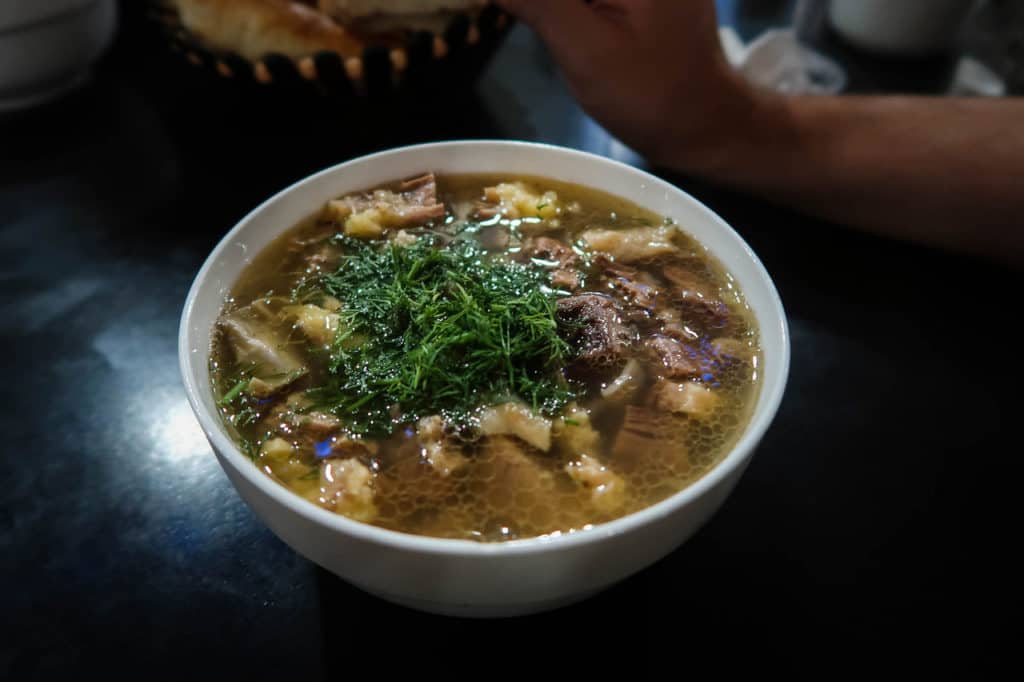
Plov is the most popular dish in Central Asia. While it’s considered to be Uzbekistan’s national dish, you’ll also find it everywhere in Kyrgyzstan.
Plov is made from rice, onions, carrots, spices and meat. You can also ask for the vegetarian option where the meat is replaced by dried raisins.

Manti is another popular dish in Central Asia. Each region has its own version.
Manti are dumplings filled with ground lamb meat but in Kyrgyzstan, they also fill them with beef, cabbage, potato or pumpkin.
Shashlik is grilled beef, mutton or chicken meat on a skewer. It’s a simple dish and you’ll find it everywhere in Kyrgyzstan.
13.2 Is vegetarian food available in Kyrgyzstan ?
It’s nowadays not so hard anymore to find vegetarian food in Kyrgyzstan. You can eat almost all the traditional dishes. Just say “bez myasa” (without meat) when ordering.
Vegans, on the other hand, will have a harder time as nearly all the dishes contain animal products. My suggestion would be to stock up on fruits and vegetables at local markets and cook your own meals.
13.3 What is the national drink of Kyrgyzstan?
Don’t leave Kyrgyzstan without trying some kymys . It’s a very popular drink among the nomads and it’s made of fermented horse milk. It tastes very sour and it contains some alcohol.
Despite being a Muslim country, alcohol is omnipresent in Kyrgyzstan and especially vodka is also a very popular drink (Kyrgyzstan used to be part of the Soviet Union). It’s so cheap here that people even use it to defrost the windshield of their cars in winter…

14. Packing list for Kyrgyzstan
14.1 what should i wear in kyrgyzstan.
Kyrgyzstan has a continental climate with hot summers and cold winters but because it’s a mountainous country, the weather varies a lot depending on where you are.
It can be very hot in the summer (35°C) in the lower areas such as the capital Bishkek , but as soon as you go into the mountains, the temperature can go down to 10°C. If you’re at a high altitude, you might still get snow.

In the same way, winters at lower elevations are much milder (-5 to 0°C) while the temperature can get as low as or lower than -30°C in the mountains.
Pack appropriate clothes for the period in which you’re traveling.
In winter you should always bring warm clothes, a down jacket, a hat, a scarf, thermal underwear, warm boots and maybe a few lighter clothes for the mild days in Bishkek.
The summer in Bishkek and other cities located under 1000 meters can be very hot so bring light clothes.
If you’re planning on hiking and camping in the mountains during the summer, you should also bring warm clothing as the temperature at night can drop to 0°C!

Women shouldn’t wear miniskirts, short shorts, and revealing tops.
With the exception of the capital city where young people follow the latest Western fashion, most people are still very traditional and will take offense if you show a lot of skin.
T-shirts with short sleeves and knee-length skirts, dresses, and shorts are okay, except for when you visit religious buildings and sites. There you should cover your arms and wear a long skirt or trousers.
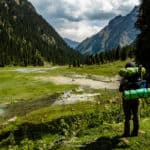
The Complete Packing List for Kyrgyzstan
14.2 Travel essentials for Kyrgyzstan
The packing list that I mentioned above includes everything you need for traveling and trekking in Kyrgyzstan but here’s a brief overview of all the essentials:
- Water Filter Bottle : I highly recommend bringing a reusable bottle with a microfiltration decive. It allows you to safely drink the tap water and fresh mountain water from rivers and streams without becoming sick. When you drink water using a bottle like this, any dirt, bacteria or parasites will be trapped in the fibers of the filter, while the clean water passes through. I use and highly recommend the Lifestraw Water Filter Bottle . Another way to filter water is by using a steripen .
- Power bank : you won’t always have electricity available to charge your electronic devices, especially not when you’re planning on spending time in the mountains and staying in yurt camps. I use and recommend Anker Power Bank as it has a 20,000mAh cell capacity providing at least 5 full charges for my phone. I can even charge my camera batteries with it!
- International travel adaptor : the power sockets in Kyrgyzstan are of type C and F (the same as in Europe). The standard voltage is 220 V and the standard frequency is 50 Hz. In case you need an adaptor, I use and recommend this all-in-one Universal Travel Adaptor as you can use it worldwide.
- Biodegradable toilet paper : you’ll have to be comfortable using a squat toilet in Kyrgyzstan. With the exception of the guesthouses where you’ll have a western-style toilet, most toilets will be outside in the form of a separate small building with a hole in the ground. Sometimes there’s toilet paper but you should definitely bring biodegradable toilet paper with you. I mention biodegradable as the toilet paper disappears in the ground so we can keep it environment-friendly!
- Same goes for biodegradable wet wipes . Most yurt camps and some homestays don’t have showers so wet wipes are very handy if you want to refresh.
- Immodium (or any other anti-diarrhea medicine): a lot of the travelers eventually suffer from diarrhea at one point or another throughout their first trip to Kyrgyzstan. As prevention, I use activated charcoal (it helps your body get rid of toxins and unwanted substances, ask about it in your local pharmacy).
- Paracetamol: You’ll often be at altitudes of 3000 meters and above. You might feel slightly light-headed and have a little headache during the first day and evening if you’re not used to high altitudes. That’s why paracetamol (or other painkillers for headaches) can be useful. After that first day, you should be fine!
Read The Complete Packing List for Kyrgyzstan to know exactly what to pack!
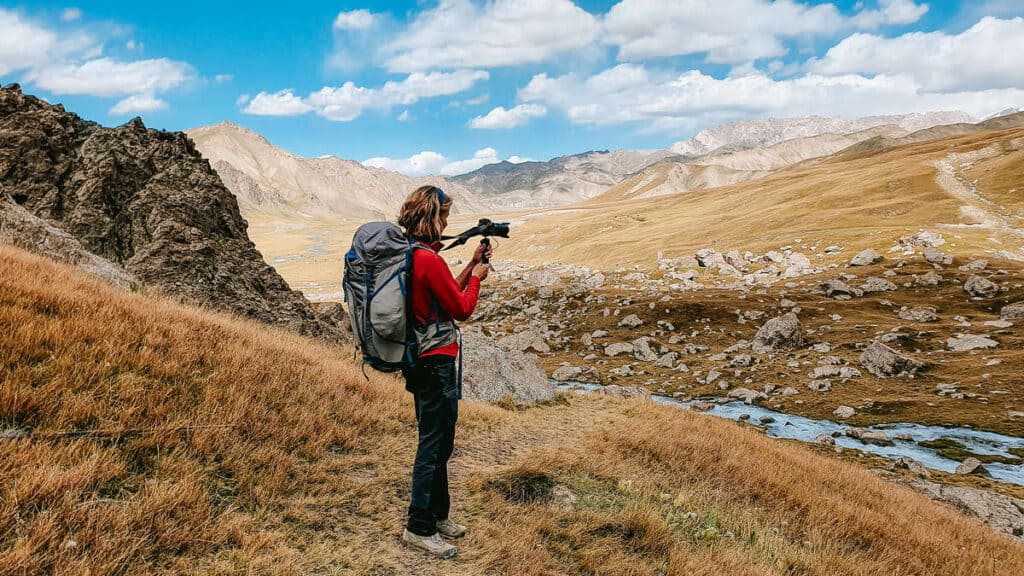
15. Are drones allowed in Kyrgyzstan?
Yes, drones are allowed in Kyrgyzstan!
There is some misinformation on the internet stating that your drone will be confiscated upon entry into the country. This is only the case in Uzbekistan .
I’ve been traveling to and around Kyrgyzstan with my drone since 2017 and I’ve never had any problems.
You can fly your drone everywhere in Kyrgyzstan, except near airports, border areas, military, and governmental buildings, and urban centers.

What’s in my camera bag – My photography essentials and cameras
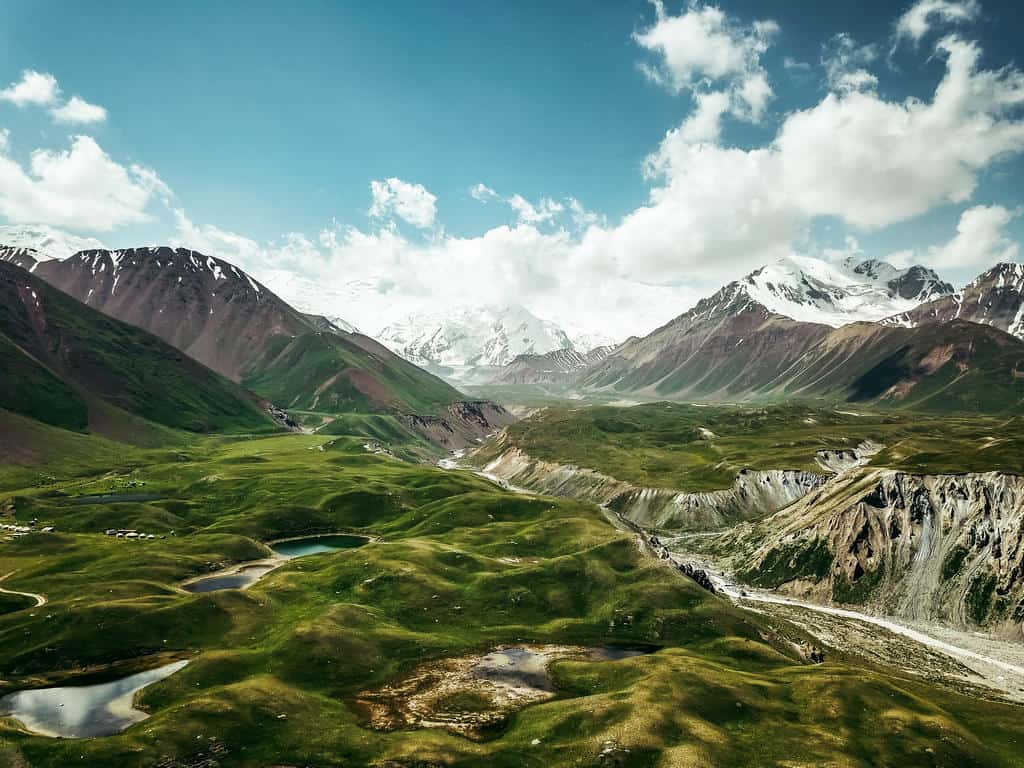
16. How is the internet in Kyrgyzstan?
High-speed wi-fi is available in all the big cities in Kyrgyzstan. If you’re a digital nomad like me and you need to work online, you can count on the internet in Bishkek, Osh, and Karakol.
All restaurants, cafes, hotels etc. offer a free connection for guests. If you rent an Airbnb or apartment, internet will be included. It might be a bit slower in some hostels but in general, it’s reliable and fast.
However, power cuts aren’t unusual in Kyrgyzstan, even in the capital city so I highly recommend buying a sim card to hotspot your phone if the power goes out.
Just keep in mind that only 25% of the country has mobile coverage (although, with Elon Musk’s Starlink this might change quickly). You won’t find much coverage in rural areas and none in the mountains.
If you’re planning on doing some treks, you should install a navigation app that can be used offline (see Recommended apps in Kyrgyzstan below).
16.1 Which is the best sim card in Kyrgyzstan and how to get one?
If you’re planning on traveling in the northern part of the country ( in the regions of Chuy, Issyk Kul, Naryn and Talas ), Beeline KG will provide the best coverage.
If you’re planning on traveling to southern Kyrgyzstan ( in the regions of Jalal-Abad, Osh and Batken ), then Megacom will be your best provider.
You’ll find a Beeline and Megacom booth at the airport or at any of the shopping malls in Bishkek or Osh where you can buy a prepaid data SIM card. You’ll have to show your passport to register and pay a small signup fee (max 200 som).
They both offer weekly or monthly data plans and you can easily recharge your phone credit online. Check out the info and data plans for Beeline KG and Megacom and how to recharge online.
You can also recharge your credit by using a self-service terminal in a supermarket. You have to enter your mobile number and feed the booth with coins and notes. The language is mainly in Russian but it’s quite easy to figure out what you have to do with the help of the graphical elements on the screen.
16.2 Recommended apps for Kyrgyzstan
- M aps.Me : This is one of the most practical apps you could use to navigate in Kyrgyzstan. You download the map of the country so you can use it offline. It gives you very accurate directions (Google maps gets lost in Kyrgyzstan…) and shows you where you can find the nearest restaurants, bus stations, ATM, hotels, places with wi-fi, points of interest, etc. This is also a great app to use while hiking as it shows most of the trails.
- 2GIS : This is very similar to Maps.Me but only works for big cities such as Bishkek and Osh. You can download the map of the city for offline use. This app only works in Russian but it’s the most popular and accurate navigation app in Central Asia.
- Booking.com : You’ll need internet to use this app but it’s a great tool to find (last-minute) accommodation in the country.
- Bus.kg : Useful app to find out the routes of the city marshrutkas and where to catch these minivans
- Go.Yandex: Great app to use if you want to take a taxi in Bishkek or to and from the airport. It works very similar to Uber. Just enter your location and a taxi will arrive within 10 minutes. It also shows you how much the ride will cost.
- Google Translate: Translates written and spoken Russian or Kyrgyz. Only Russian is available to download for offline usage.
- Xe currency: very handy to check exchange rates, also works offline.

17. Culture and etiquette in Kyrgyzstan
The Kyrgyz people are descendants of ancient Turkic tribes and have been nomadic cattle breeders for centuries.
Nowadays, a large part of the population remains semi-nomadic, which means that they live in yurts during the summer months and return to their houses in the towns and cities during winter time.

The Kyrgyz people are in general very hospitable people, especially in small villages where they aren’t used to seeing foreigners.
They will most likely invite you for a tea or a meal (bread and homemade jam are very popular) in their home and take plenty of selfies with you.
If you can, bring a small gift (sweets are always appreciated) and take off your shoes at the door. Eating and drinking are taken seriously and you’ll be overwhelmed with food.

However, in more touristic destinations the people are used to being hospitable in exchange for money. They will welcome you in their home to spend the night but will expect payment in exchange.
Don’t feel offended or abused when this happens, see it as a way of helping out the locals.
The common greeting is a handshake but is used by men mostly. Men shake hands to greet and congratulate each other and also to say goodbye. Typically men do not shake hands with women.
If a man extends his hand first to a woman, a woman is supposed to shake it. If a woman extends her hand first to a man, the man will shake it but this is not a very common thing.
So if you’re a woman, just wait until a man initiates it, and don’t be offended if he doesn’t. It’s after all part of the culture.
Some more useful things to know:
- Always show respect towards older people by shaking their hand or offering your seat.
- Say thank you in the gesture of a silent bow: place your right hand on your heart and incline your head slightly
- After sharing a meal together, the Kyrgyz people give thanks by sharing some words of gratitude while having their hands open and then make a washing gesture by waving their hands over their faces.
- People don’t know how to queue in Kyrgyzstan. Don’t be surprised when someone jumps in front of you in a waiting line so dare to be assertive or you’ll never make your way to the cash register…
- You won’t find any knives on dining tables, only forks and spoons.
- Give or receive something by using your right hand. The left hand is considered “dirty” as it’s the one used in the bathroom
- Blowing your nose in public is considered to be rude but spitting on the floor is absolutely fine, except in ones house of course…
- If you need to go to the bathroom and there aren’t any toilets available such as when hiking in the mountains, hide yourself well (even guys!). If a local would see you squatting, he/she will be very offended by it!
18. What is the Religion in Kyrgyzstan
Kyrgyzstan is a multicultural and multi religious country. The vast majority of the Kyrgyz people are nowadays Sunni Muslims as Islam became the dominant religion in Kyrgyzstan in the 19th century.
The Islam practiced in Kyrgyzstan is often infused with the elements of the pre-Islamic traditions and tribal customs of the ethnic Kyrgyz people.
The people in the southern part of Kyrgyzstan are more conservative and traditional. They practice their religion more strictly, meaning you’ll see or hear them praying 5 times a day, alcohol is mostly a no-go (except when drinking kymys) and while women usually don’t wear a hijab (with the exception of Arslanbob ), they always cover their heads.
The northern part of the country is less conservative and has more Russian and Western influences. You’ll see both Russian Orthodox churches as mosques and the people, even if they practice Islam, usually won’t say no to good shot of vodka.
19. Do people in Kyrgyzstan speak English?
Russian and Kyrgyz are the two official languages of Kyrgyzstan. It’s one of the two former Soviet republics in Central Asia that continued using Russian as the official language.
After the independence of the country in 1991, Kyrgyz was designated as the second official language and is now the most widely spoken language in the country. It’s a Turkic language and has a lot of similarities with Kazakh and Turkish.
English is spoken, but mainly by tour guides and the younger people who study in the cities. If you want to be able to communicate with the locals, I’d suggest you learn some Kyrgyz or Russian .
l study Russian by using the audio classes of Pimsleur . This is a great learning method to study a new language.

11 Tips on how to learn Russian efficiently
A phrasebook will definitely be useful. I recommend both the Lonely Planet Central Asia Phrasebook and the Lonely Planet Russian Phrasebook & Dictionary . I also recommend installing the Google Translate app and download the Russian language pack for offline use.

20. Recommend books about Kyrgyzstan
When traveling in Kyrgyzstan, I would recommend bringing a small pocket phrasebook like the Lonely Planet Central Asia Phrasebook & Dictionary as it contains some useful phrases.
I would also recommend reading one or more of the following books.

Kyrgyzstan Bradt Travel Guide one of the most comprehensive travel guides about Kyrgyzstan

Lonely Planet Central Asia , is ideal if you’re also planning on visiting other destinations in Central Asia

Kyrgyzstan : a beautiful photography book that focuses on the costume and dress of Kyrgyz people, with stunning photos of Kyrgyz people in traditional settings.

Tales of Manas : read all the tales about Kyrgyzstan’s most epic and legendary hero.

The Silk Roads: A New History of the World : a journey through time, a revelatory new history of the world, connecting all the vast webs of roads to gain a greater understanding of modern history.

I hope you found all the info you were looking for to prepare your Kyrgyzstan trip and I’m wishing you a fantastic time in one of my favourite countries in the world!
If you still have questions about your upcoming journey, let me know in the comments below or send me an email .
Related Posts
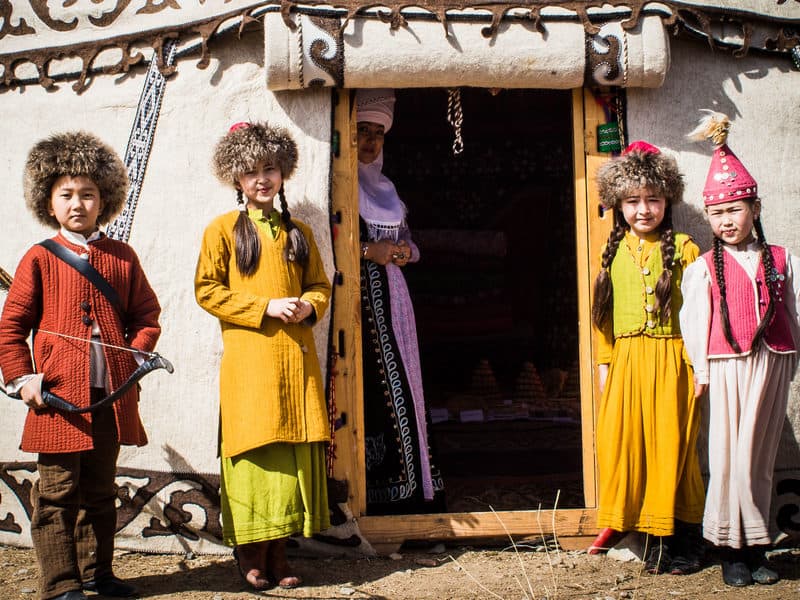
Kyrgyzstan Money Guide: Costs of Living and traveling in Kyrgyzstan in 2024
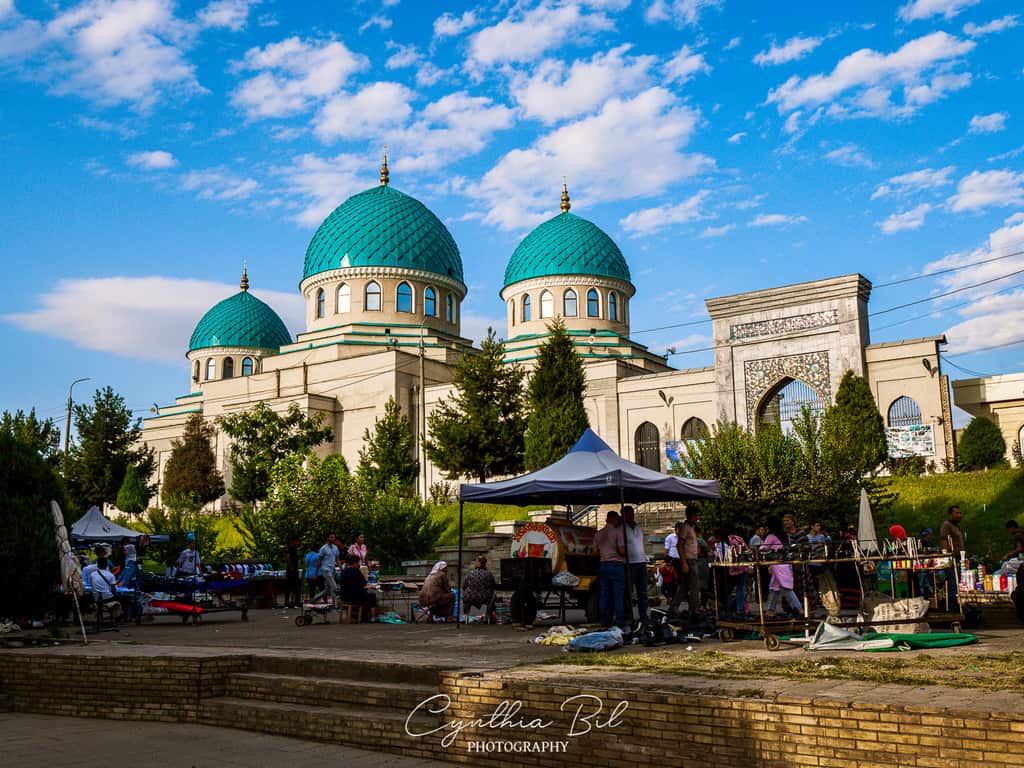
The best way to get from Tashkent to Osh and from Osh to Tashkent, crossing the Dostyk border (Kyrgyzstan – Uzbekistan)

Best Tips and complete Packing List for Traveling in Central Asia in 2024 – When to go and what to wear when visiting Central Asia

- 8 beautiful lakes in Kyrgyzstan

9 places to visit in Kyrgyzstan in spring and autumn, including best hikes

Hiking in Kyrgyzstan: The 21 best Jyrgalan and Karakol Trekking Trails
More kyrgyzstan travel resources.
- The Complete Travel Guide to Kyrgyzstan
- The 14 best hikes in Kyrgyzstan
- The 25 most beautiful places in Kyrgyzstan
- 15 useful safety tips for Kyrgyzstan
- The complete packing list for Kyrgyzstan
- 28 Things to do in Kyrgyzstan
- 13 Top Things to do in Bishkek – City Guide
- How to visit the Osh Bazaar in Bishkek
- 14 Top Things to do in Osh – City Guide
- 15 Best Things to do in Karakol – City Guide
- The 21 best hikes in Karakol and Jyrgalan
- Tash Rabat Travel Guide
- The complete travel guide to Kel Suu Lake
- The complete travel guide to Arslanbob
- How to visit Sary Chelek Lake and Nature Reserve
- Top things to do around Issyk Kul Lake, a one week itinerary
- Facts and legends of the Burana Tower
- Everything you need to know about horse riding to Song Kul lake
- A comprehensive guide to skiing in Kyrgyzstan
- Visit Kyrgyzstan in winter by using this 10-day Kyrgyzstan winter itinerary
- Here are the 7 best hikes in the Alay Mountains near Osh
- Use this day-by-day itinerary to hike independently to Ala Kul lake
- Hike independently to Son Kul lake by using these 2 itineraries
- 8 great day trips and hikes near Bishkek
- Ready steady goat! An insight into Kok Boru, Kyrgyzstan’s unusual national sport
- Meet the Golden Eagle Hunters of Kyrgyzstan
16 thoughts on “Kyrgyzstan Travel Guide: 20 Useful Things you should know to visit Kyrgyzstan in 2024”
Hi! Do you have any recommendation on what sim card data plan to get for travellers? I read that the data plans are rather complicated (or different) in Kyrgyzstan. Is there a fixed plan for a fixed amount of data for a fixed period? Or it goes by top up? And I suppose it is easy to get them at the airport upon arrival?
Hi Dianshan, the data plans go by a fixed amount per month but you can always top up if needed. You can get them upon airport arrival or in Bishkek in any shopping mall.
Wonderful, just what we needed. My wife and I are going to trek for two weeks this summer i Kyrgyzstan. Your information and beautiful pictures make us look even more forward to visit the country.
All the very best Johnny
Hi Johnny, thank you so much for your kind words! Wishing you a fantastic trip in Kyrgyzstan! Warm wishes, Cynthia
What a great article! We’re currently dreaming of going to Kyrgyzstan again – we’ve been there before and we love, love love it! Here’s to a year with loads of travel plans and new experiences!
– Veronika
Thank you Veronika! Are you planning on returning in 2023?
Thanks a lot Cynthia, it is really helpful and comprehensive, i am planning to go to Bishekek this weekend, and hopefully i enjoy it, I will definitly keep a print of this complete guide, my concern are villages and how to reach there and enjoy the nature.
Thanks again. Amir Manama – Bahrain
You might not be able to reach certain places at this time of the year due to snowfall. You might need the help of tour companies to get to certain areas. Please see my Kyrgyzstan winter itinerary as that one might help! If you can’t get to a place or village by public transport, you can always look for a taxi as well. Enjoy your time in Kyrgyzstan!
Hi Cynthia,
thanks for sharing your experience. It is very helpful and interesting for all of us that fancy going to this beautiful country.
I am planning to visit Kyrgyzstan next summer and it is not easy to see everything within 8-9 days. My main concern is about how to get around: do you recommend hiring a car (I have seen it is very expensive with a low standard, around 60-80usd/day)? or do you suggest using local means of transport (my concern is, if I want to go from a town to a village, then do some hiking there, how can I get another transport from this remote area to the next place? ).
Hope you can help
Hi Gianguido, It really depends on which places you like to visit in Kyrgyzstan. If you’re planning on going to Issyk Kul and Son Kul, you’ll be able to get there by public transportation or by (shared) taxi. If you’re interested in hiking to Ala Kul, you can get a minibus to Karakol and a taxi to drop you off at Karakol Valley from where you can start the hike. If you want to visit regions like Kel Suu, you won’t be able to get there by public transportation. If you have a look at our posts like “Best places to visit in Kyrgyzstan” or “one week itinerary Issyk Kul”, we give information on whether or not it’s possible to get to these places by local transport. Hope this helps!
This is a great post, an enjoyable and informative read. I’m travelling solo to Kyrgyzstan for a month this summer so it’s nice to have so many tips about one of the more undiscovered parts of Asia. Thanks so much!
Hi John, I’m glad to hear you enjoyed reading this post. You’ll have a fantastic time this summer in Kyrgyzstan! We might cross paths as we’ll be there as well 🙂 Any particular places you already know you want to visit?
Very comprehensive, ultimate travel guide indeed, thanks for sharing Cynthia!
Sad to hear about the “corruption” with the traffic police, if we may add, also look out for fake police and pickpockets – reportedly common at the Osh Bazaar.
Wishing everyone a safe and fun trip in Kyrgyztan 🙂
Thank you David, glad to hear! I haven’t heard or didn’t come across the fake police but yes, people have to watch out for pickpockets at the Osh Bazaar.
Thanks Jack! 🙂 Are you planning on traveling to Kyrgyzstan any time soon?
Leave a Comment Cancel Reply
Your email address will not be published. Required fields are marked *
Save my name, email, and website in this browser for the next time I comment.

TRAVEL to KYRGYZSTAN – Tips and Information Guide [2024]
Everything you need to know to travel to Kyrgyzstan, from the best things to do, places to visit, budgeting, travel itineraries and plenty more!
This beautiful landlocked country, formerly part of the Soviet Union is probably most popular travel destination in Central Asia. Kyrgyzstan tourism is growing year on year, so take the chance to visit one of the worlds most spectacular countries.
Travels to Kyrgyzstan has increased dramatically in recent years as travellers come to hike, camp and horse trek through Kyrgyzstan’s stunning scenery.
As first of the Central Asian nations to relax their visa policies, (it’s visa-free for most western and developed nations) a strong tourism network has developed.
From Community Based Tourism (CBT) operating all over the country to guesthouses and independent guides there are plenty of ways to access the stunning scenery for which this country is famed.
Hikers marvel at stunning treks from Karakol, Kochor, Arslanbob and even the countries capital Bishkek. Since hiking makes a huge part of travelling here it should be assumed that you will need a reasonable level of fitness to access them.
Whilst some are naturally easier than others, it’s safe to assume you will be dealing with something more than a Sunday afternoon stroll. The vast majority of treks are between 1 and 5 days, however, there are some that are longer.
If you fancy saving your legs then jump on the back of a horse and take on the countries most spectacular horse trek to Song Kol. You could spend a few days relaxing and swimming at Issyk Kul.
With plenty of off-the-beaten-path destinations, treks and trails the opportunities to explore are limitless.
For more specific information on what to see and do, how to get there and around and other Kyrgyzstan travel tips be sure to read through our Kyrgyzstan travel guide.
Kyrgyzstan Travel Guide
If you’re planning to travel to Kyrgyzstan make sure to read this guide to prepare you for visiting one of the world’s stunning countries.
General Info
- Capital: Bishkek
- Other Main Cities/Towns: Osh, Karakol and Jalalabad
- Currency: Kyrgyz Som
- Language: Kyrgyz and Russian
- Population: 5,849,296
- Area: 199,951 sq km
- Electricity Voltage: The standard voltage is 220V at 50 Hz frequency
- Electricity Sockets: Type C and F
Looking for an adventure? Check out our incredible small group Kyrgyzstan tours !
How to Travel to Kyrgyzstan
Kyrgyzstan is serviced by two main airports; Bishkek and Osh. The vast majority of international flight will land in Bishkek.
If you’re looking at flying into Osh from overseas then you will either have to transfer in Bishkek or the regional hubs of Almaty in Kazakhstan or Tashkent in Uzbekistan.
Flights to Kyrgyzstan can be pricey depending on where you’re flying from. I would recommend researching across a number of platforms and book your flights as early as possible.
Although Kyrgyzstan is well connected to its neighbours, if you’re flying from outside of the region it’s very likely you will need to transfer.
If flying from Asia, Chinese Airlines may be among the cheapest, however, you will have to transfer in China. Flying from the west the choices are far more varied.
As the majority of international flights require a layover, it’s wise to check if there are any visa requirements in the country you are transferring in.
It is also a good idea to browse for flights in incognito mode, or alternatively you can clear the cache in your browser periodically.
Many travel sites will charge higher fares if they know you are visiting their sites frequently to search for flights.
Google Flights also offers some of the best initial research for fares from your destination, from there it’s worth doing more detailed research.
However, be sure to check fares directly with the airline as there may be unspecified fees and regulations not listed in the Google Flights results.
If you find a flight on a site like Skyscanner or Kayak check the cost of booking the flight directly with the airline. It’s not uncommon for the flight to be much cheaper when booking directly through the airline.
5 Interesting Facts About Kyrgyzstan
- The hero at the centre of the “Epic of Manus”, an epic 500,000 line poem, is celebrated all over the country with statues, airports, roads universities and even a planet.
- 40 is a lucky number. It’s a reference to the 40 clans of the great Manas. The country’s flag features a sun with 40 rays as nod to the country’s luckiest number.
- Only 36% of the country’s residents live in an urban location. Yurts and a nomadic lifestyle are still central to Kyrgyz culture.
- Mountains cover 80% of the country – Get ready hiking, camping and breath taking scenery.
- Horse milk, “kumyz,” is the national drink. It’s certainly an acquired taste.
Best Time to Visit Kyrgyzstan
Travelling to Kyrgyzstan is limited to the warmer months if trekking is your goal. The ideal time is June to early September. However, even in June, you may find some routes and passes are closed especially if the preceding winter was a long and harsh one.
Do be aware that July and August are peak months to travel to Kyrgyzstan so whilst it may be slightly riskier weather-wise to visit in June or early September you can expect to see fewer travellers and enjoy cheaper accommodation.
If skiing is your game , February and March are particularly good months to travel to Kyrgyzstan.
The best places to carve the slopes are at Karakol Ski Resort, and in the backcountry of Jyrgalan, Boz Uchuk and Jalpak Tash. There are also some mellow ski resorts close to Bishkek.
Those planning longer trips to Central Asia may want to spend the hotter summer months travelling in Kyrgyzstan and its mountainous neighbour, Tajikistan and spring or autumn in Kazakhstan, Turkmenistan or Uzbekistan.
This allows you to access to the best weather in each country. You do not want to find yourself in Turkmenistan or Uzbekistan in the middle of the summer!
Travel Itinerary Suggestions
- Bishkek 1-2 Days: A great place to start or end your Kyrgyz adventure. With plenty of Soviet Architecture and parks to explore it’s certainly a great place for some downtime. There are some hiking trips into the nearby mountains; Ala-Archa being particularly stunning. Here’s our Bishkek article to help you plan your trip.
- Karakol 4-5 Days: There is ample hiking here, whether it’s hiking to Altyn Arashan , Jeti Oguz or the Jyrgalan Valley there are oodles of treks of varying difficulty and length. Jeti Oguz is probably the most stunning single day trek in the area. However, head to Altyn Arashan or the Jyrgalan Valley for some awesome multi-day treks.
- Kochkor 5-7 Days: Kochkor itself is a pretty nondescript town consisting of one main high street, a market and plenty of taxi drivers. However, it’s what can be accessed from here that draws people. Firstly there is the stunning Song Kul, possibly one of Kyrgyzstan’s top horse treks. In addition, there are stunning hikes to Kol Ukok and beyond.
- Naryn 2 Days: This is the starting point for a road trip to Kyrgyzstan’s stunning south-east, culminating in a hike to Kol Su.
- Osh 1 Day: Kyrgyzstan’s second city is home to a famous bazaar and the rather stunning Suleiman Too. You may stay longer if venturing out to some of the area’s hiking trails.
- Arslanbob 2-3 Days: Home to stunning treks through the world’s largest walnut forest, Arslanbob is justifiably popular thanks to excellent home-stays and spectacular scenery.
Budget for Travelling in Kyrgyzstan
Travelling in Kyrgyzstan is reasonably easy on your wallet, however doing horse treks, rafting and 4×4 trips out into the wilderness can rack up the costs quicker than you may imagine. However, there are a few little tips to help you save a few pennies here and there.
Accommodation: Guesthouses and Yurts are the name of the game in Kyrgyzstan. A private room in a guesthouse is usually between $19-25 which usually includes breakfast. Prices for accommodation in Bishkek is usually more expensive than other parts of the country.
Yurt stays vary depending on how many meals you are getting, but it’s fair to budget between $10 and $15 dollars per person including breakfast and dinner. These rates may go up in depending on location and time of year.
Food: Cheap and cheerful. You won’t spend more than a few dollars for local classics like manti, shashlik and Lagman. However, outside of the Central Asian staples it’s more pricey.
Alcohol: Cheap, but stick to beer as spirits can sometimes contain fake alcohol and there have even been stories of anti-freeze being used in some vodkas (not too dissimilar to parts of Russia).
Tours: For any hike check if you need a guide. For many you DON’T but check online otherwise some tour agents will encourage you to book a guide that you don’t need. Politely inform them if you don’t need one. However, there are some routes where a guide is a must. Tour operators of your guest house are usually the best places to book yurts for multi-day hikes.
For horse treks and 4WD trips expect to spend between $40-70 per person, per day. This price includes yurt accommodation options and is based on 4 people. Naturally the fewer the people, the more expensive it will be.
Kyrgyzstan tourism is very well suited for backpackers. Staying in family-run guesthouses, your own tent or yurts will certainly save you plenty of money. Limiting how much you eat out and how much you drink are always solid options for saving a few pennies when travelling.
For hikes and treks, not using a guide and staying in your own tent are great ways to save money. However, you should only avoid using a guide if you are sure the trails are clearly marked and you are a confident hiker.
In addition, utilising marshrutkas (shared minivans) as opposed to private taxis can lead to some substantial savings on the transport front.
To account for everything a healthy budget is $30-$50 per person for a single traveller and $40-$80 per couple per day. Remember it is always better to budget slightly more than you need to cover for accidents and emergencies, so I would recommend budgeting for slightly more than this.
If you are looking to take some of the tours mentioned above then you will need budget a little more than I’ve suggested here.
Naturally staying in a tent, cheap guesthouses and taking advantage of hiking trails where guides are not necessary will naturally lead to a lower budget.
Flashpacker
Staying in boutique guesthouses and taking private taxi’s for the majority of your trip will be a 20-50% increase on a backpacker budget. Instead of eating at local restaurants you occasionally opt for a taste of home and a couple of cheeky beers.
This can be as expensive as you want it to be. Maybe you want a guide for your entire time, or want to horse trek across the country. Although the latter is not luxury, the price will certainly be.
Outside of Bishkek 5 star hotels are certainly not common, however hiring private guides and transportation will certainly add to your bill.
It is just about impossible to have a purely luxury holiday in Kyrgyzstan, as the infrastructure just isn’t there for it. That’s not to say you can’t have a very comfortable time, just don’t expect to be staying in world-class resorts.
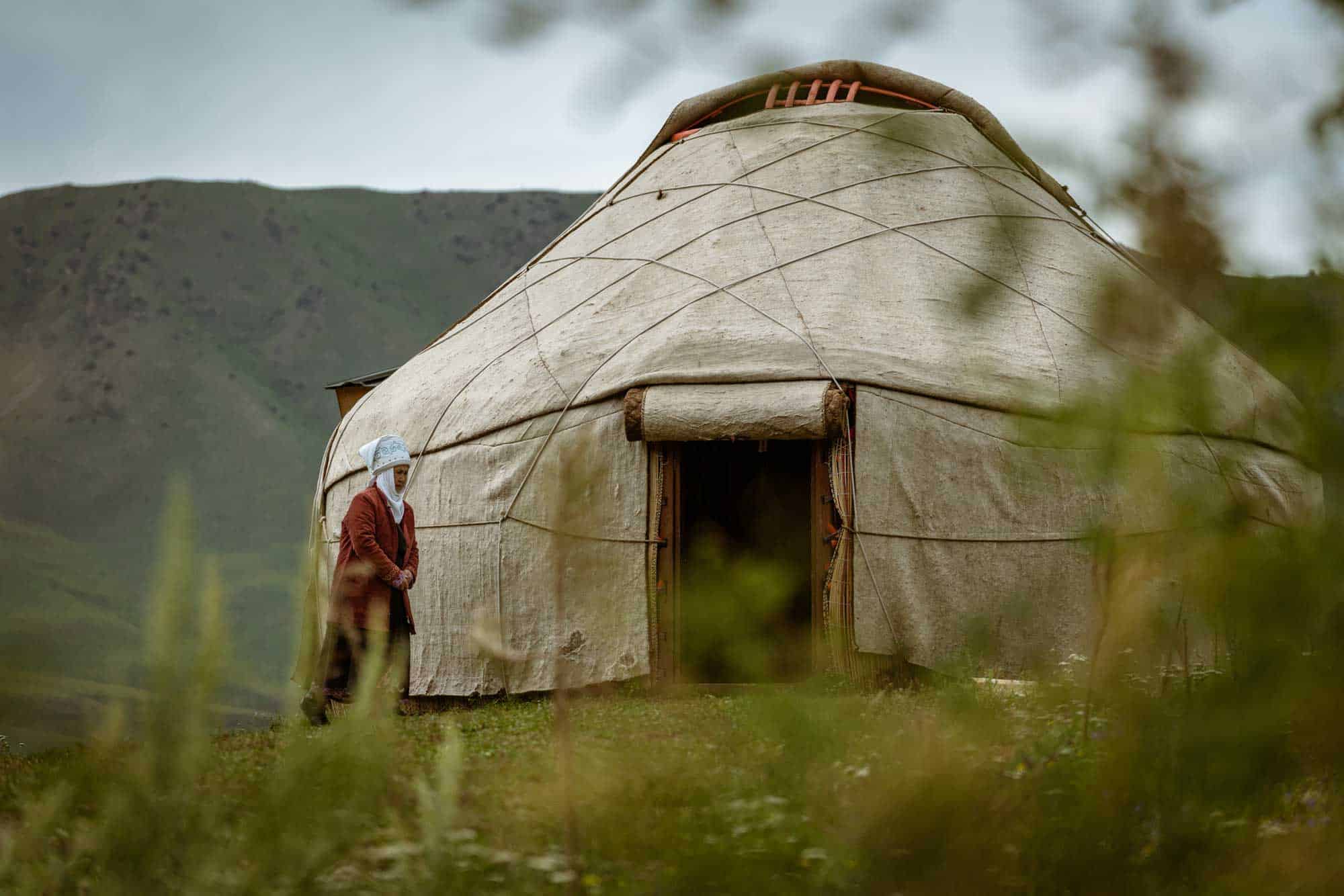
Top 5 Places to Visit in Kyrgyzstan
Every traveller who has been to Kyrgyzstan will have their own favourite place. Usually a particular spot, on a particular hike where a combination of exhaustion and snow-capped mountains combine to leave you in awe.
Here are my top 5 places to visit in Kyrgyzstan
Jyrgalan: After 7 visits to Kyrgyzstan and now running adventure tours in the country, the owners of this website, Alesha and Jarryd, can honestly say that Jyrgalan is the best place to visit in Kyrgyzstan. This little village just outside of Karakol is a trekker’s paradise, and is worth spending a few days in town anyway. Click here to see why they love it so much .
Song-Kul: One of the countries most popular destinations, Song Kul is truly spectacular. Whether you’re hiking or on the back of a horse it’s hard not to be completely overwhelmed, especially as you cross the pass down to towards Song-Kul. Here it’s as much about the journey as it is the destination.
Kol-Ukok: This awesome two-day hike from Kochkor offers spectacular views, but you certainly have work for it. Once you have your eyes on the prize, stunning mountain scenery will unravel in front of you.
Ala-Archa: For those that don’t have a lot of time in Kyrgyzstan, but still want to experience its epic mountain scenery Ala-Archa is an awesome option. Only an hour from Bishkek it is an easy escape.
Sary Mogol: If you head to the southern part of the country past Osh you’ll enter the Alay Mountains, which are some of the wildest, most untouched peaks in the entire country. The little dusty village of Sary Mogol is right near the base of Peak Lenin, a 7134m high mountain which can be climbed as part of an expedition and is an excellent launch point for trips along the Pamir Highway . It’s a lovely town.
Top 5 Travel Experiences in Kyrgyzstan
Hiking – Naturally this is one of the top travel experiences in Kyrgyzstan. With awesome hiking trails all over the country , you are spoilt for choice. With everything from day hikes to multi-day treks available, there is something for every hiker.
Sleeping in a yurt – A quintessentially Kyrgyz experience and unless you have your own tent, it’s an essential one when undertaking a multi-day hike. As the temperature drops at night yurt’s remain warm and comfortable. We highly recommend checking out Feel Nomad Yurt Camp on the south shore of Issyk Kul.
Swimming in lake Issyk Kul – Swimming in one of the world’s highest alpine lakes is an awesome thing to tick off your bucket list. Taking a dip surrounded by stunning mountain vistas is fantastic, if a very chilly, experience. Check out our guide for things to do in Issyk Kul .
Taking a Horse Trek – Horse treks are a highlight when travelling Kyrgyzstan. Whilst your legs get a break, your backside will certainly feel the pain. However, hanging on for dear life as your horse goes galloping across mountain pastures is a once in a lifetime experience that certainly makes up for the aches and pains.
Sunsets and Star Gazing – After a long day of hiking and a home-cooked meal, watching the sunset set followed by a spot of stargazing is a great way to round off the day.
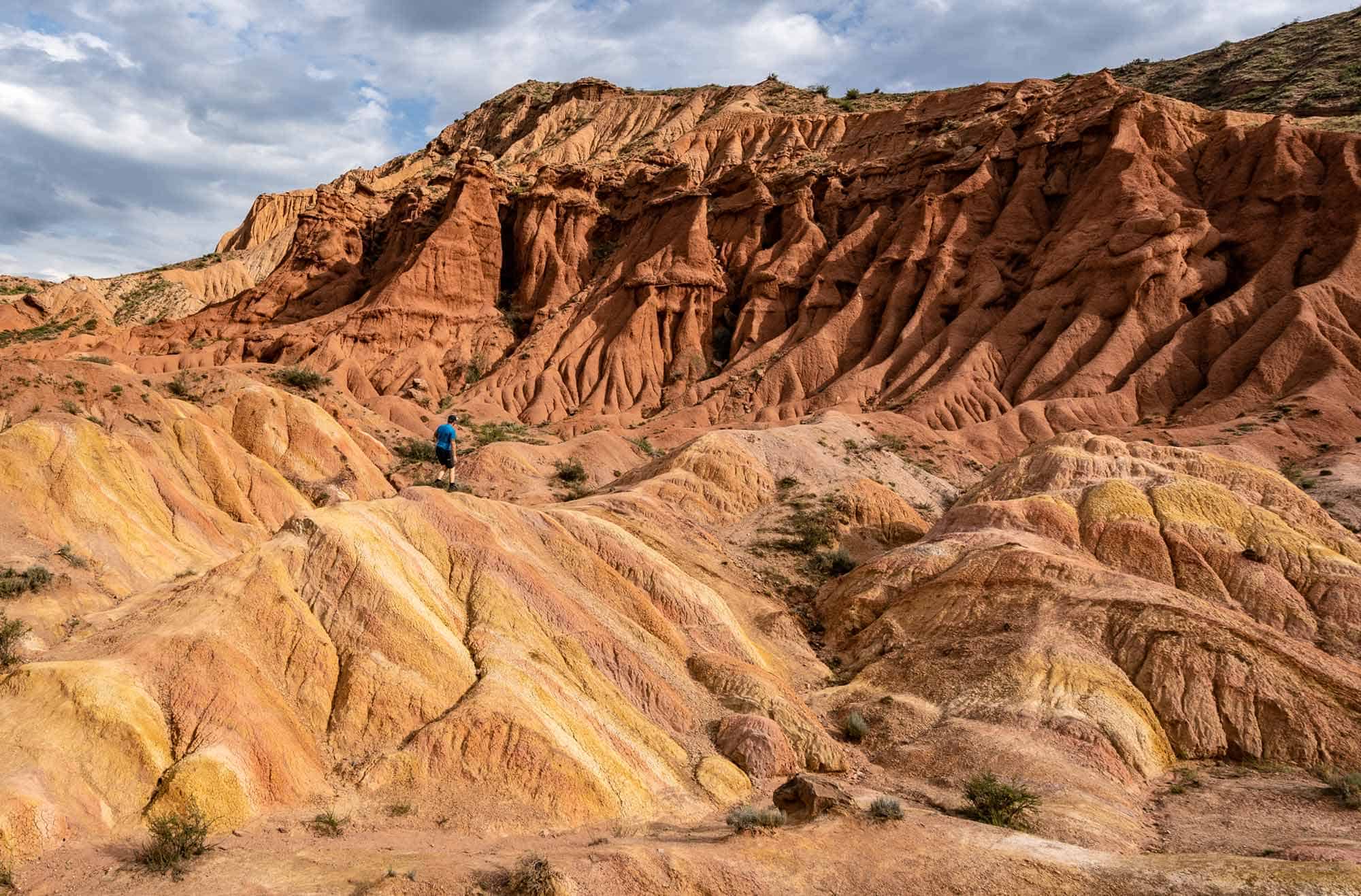
Kyrgyzstan Travel Tips
Travelling in Kyrgyzstan is getting easier every year, but it still requires an adventurous spirit and a bit of patience due to the lack of infrastructure outside of Bishkek.
To help you make the most of your trip, I’m going to share with you some of my best Kyrgyzstan travel tips.
What is Community Based Tourism?
One of the reasons that travel to Kyrgyzstan has developed so quickly is because of the community-based tourism network in existence throughout the country.
In effect, this allows the money that comes from tourism to reach more of the population. It connects herders, guides and drivers with tourists and helps them to receive the benefits of hosting, guiding and driving tourists.
The main hub for this network is the CBT office that exists in almost every major town in the country. However, this is not the only agency doing such work.
There are a number of smaller independent agencies offering community-based tourism through a different name.
In addition, there are a number of guesthouses that have connections with local guides, herders and yurt camps and can also arrange everything for you.
There are also a number of former guides that are starting up their own tourism companies utilising their own network and knowledge.
Do your research and find out which organisation offers what you are looking for. Here’s the main website .
Language Issues
Travelling in Kyrgyzstan does not have the same language challenges as travelling in China for example. However, it is important to remember that English is not widely spoken, save for tour agents and some guesthouse staff (certainly not all).
Outside of this it can be very hit and miss, and in truth, it’s usually more of a miss. Knowing a small amount of Russian is extremely useful for guesthouses, transport and general communication.
Money Changing
You will be able to access ATMs that accept foreign cards in Bishkek however it can be hit and miss outside of the capital, Karakol and Osh. It’s best to bring some additional US dollars in cash just in case.
These can be converted to Kyrgyz Som at any bank in the country, however, do be aware that the dollars have to be in excellent condition.
Transportation In and Around Kyrgyzstan
The best way to get around Kyrgyzstan is by marshrutka or private taxi. Internal flights are most reliable between Bishkek and Osh and there is a limited train service but it’s unreliable and inconvenient and in truth is best avoided.
Kyrgyzstan’s Geography
Before going into detail about the transport options in an around Kyrgyzstan it’s important to understand a little about the countries geography.
With 80% of the country covered by mountains and some roads in a poor state of repair, some journeys will take much longer than you would think. For example, expect it to take between 6 and 8 hours to get from Bishkek to Karakul by marshrutka.
Another thing to bear and in mind is the challenges of travelling across the centre of the country, for example from Kochkor to Osh, can be unreliable.
The main reason for this is the stretch of road that goes from Naryn to Jalal-Abad. This is a 4WD road that is closed in winter, however, do not be surprised to see some old Ladas taking on the terrain.
The road is in poor shape and it is closed in winter. Mudslides are a risk, but not as much as in Tajikistan. In addition, you may have to take two taxis to get all the way along this stretch of road.
Speak with your accommodations staff, the local CBT (who can also help to arranged a private taxi) and check online to keep up to date.
A convenient and affordable way of travelling between Bishkek and Osh, but outside of the two main cities, it’s not really a viable option.
By far the most convenient way to travel in Kyrgyzstan and indeed Central Asia and the Caucasus. These converted transits ferry people all over the country.
If you’re stopping off at a smaller destination, then take a marshrutka that passes it and let the driver know where you want to get off. However, do be aware that you are likely to be charged the full fare.
One of the best things about marshrutkas is that they are cheap, sometimes a tenth of the price of a private taxi. In major towns, prices are usually clearly printed on a sign and the money will be collected by a driver or there will be a ticket office with a price list.
Knowing a little bit of Russian is extremely useful as it is very unlikely anyone will speak English.
Often marshrutka stations are a bit of a free for all, there seems to be no clear order or logic as to where they park.
There will be a card behind the windscreen with the final destination, which more often than not will be written using the Cyrillic alphabet (the alphabet used to write both Kyrgyz and Russian).
If you can’t read Cyrillic’s then you will need to go and ask someone. Even if they cannot understand you people are extremely accommodating and will often go out of their way to help you.
It can be a squeeze inside and some will only leave when full. I would recommend getting to the station a bit earlier to make sure you can get a seat. There were plenty of times when I visited that our marshrutka left full to bursting leaving a large crowd behind.
If you have large luggage that cannot be stored in the back you may be charged extra as they may need to put your luggage on the seat. Another reason to get there early.
Private Taxi
More expensive than a marshrutka and generally more reliable, private taxi’s are a good option. Sometimes they may be the only option you have. The route across the centre of country springs to mind.
The cost they give is usually per seat and they won’t leave until their car is full. This means you may be waiting a while for them to fill up the remaining seats.
However if you pay for these empty seats they will be on their way, however, they may stop and pick up people on the route, and still charge them full price, without giving you any money back.
Rental Vehicles
This is a very new market, so you will need to do some very detailed research. Be warned, it is very expensive.
Accommodation in Kyrgyzstan
Whilst there is a lot of accommodation in Kyrgyzstan there is not a huge variety. The vast majority are family-run BnB’s and guesthouses. These are often excellent value for money and give you the opportunity to build up a great relationship with the owner.
Generally, luxury accommodation is limited to Bishkek or the northern shore of Issyk Kul for the Russian tourists the descend in the summer months
Hostels are mainly clustered around Bishkek and Osh. These are a great place to connect with other travellers and get travel tips from the staff and other guests. These are generally rarer outside of the countries two main cities, but they can be found.
Guesthouses and BnB’s
This is probably the main accommodation option in Bishkek. Many families have taken advantage of the increased tourism to Kyrgyzstan by renting rooms in their homes to weary travellers.
The vast majority will include breakfast and in some more rural areas, they will also offer dinner, however, do be aware that this is usually an additional charge. Expect an extremely warm welcome and lots of conversations through google translate and hand signals.
Staying in these family-run BnB’s will leave you with some wonderful memories.
Unless you have a tent this will be your only option for multi-day treks. Very often you will book through your guesthouse or CBT and then pay upon arrival. More often than not the price includes dinner and breakfast the next morning.
Shared Apartments and Houses
There are a few of these floating around on booking sites in Bishkek and they are an excellent option. However, do be aware that it is likely you will need to register with the police if you entered the country on an E-visa.
For the majority of people who do not need an e-visa though, then Airbnbs are cheap and plentiful in Bishkek. Sign up using this link to get USD$35 off your first stay on Airbnb.
Western-style hotels are rare outside of Bishkek and Osh and more often than not are probably not worth the extra costs. However Soviet-era hotels are not uncommon, but may not be what you’re looking for.
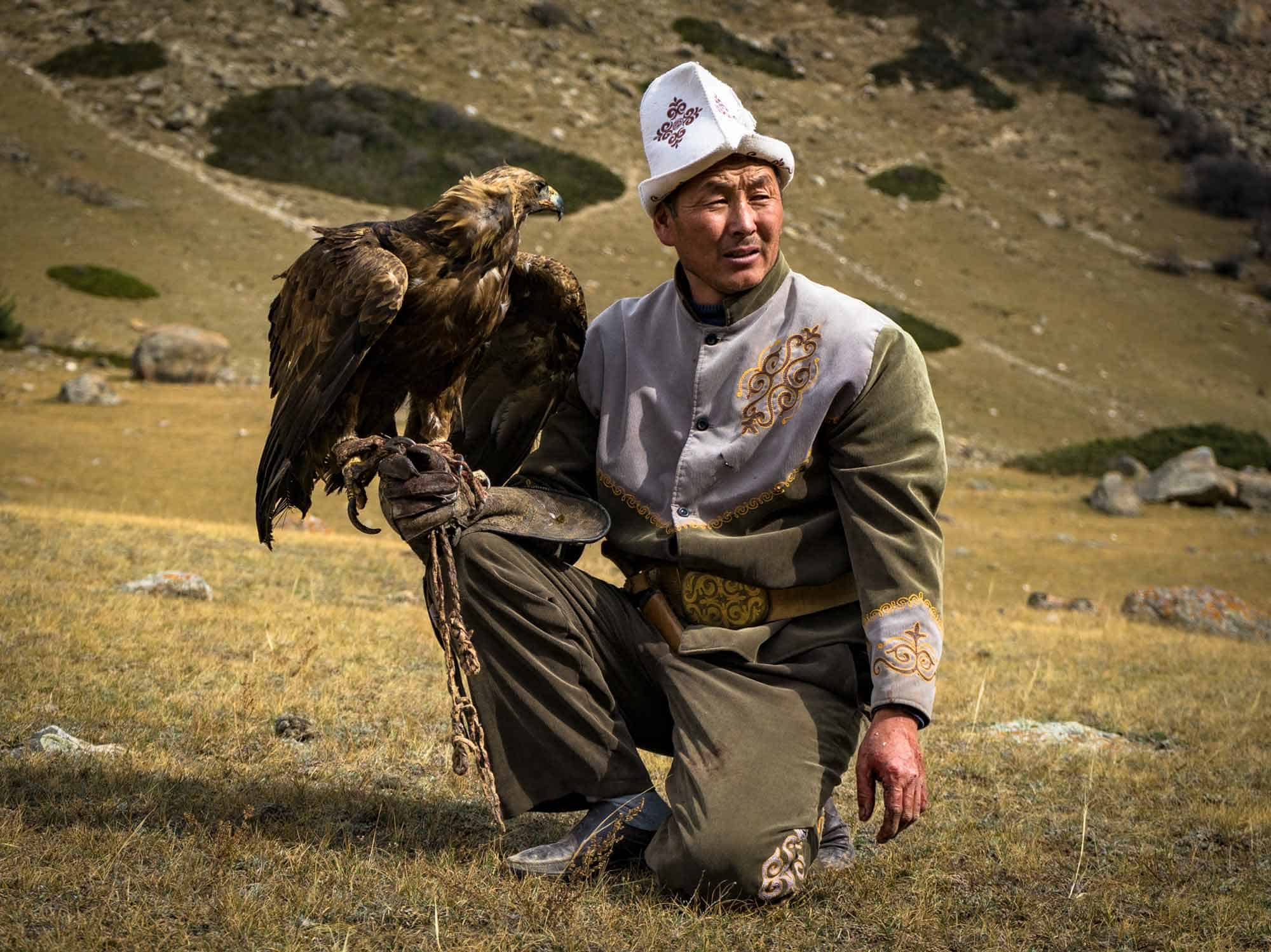
Food in Kyrgyzstan
The Central Asian staples can be found all over Kyrgyzstan and as good as some of it is you may crave something else after a while.
Bishkek has a wide variety of restaurants serving everything from western fast food to Italian, Chinese and Japanese cuisine. So if you want a break from the local delicacies then this will be the place to get your fill.
Shashlyk – One of the meals that define the region – grilled meat kebabs. Usually lamb, although chicken and beef can also be found here and there. Usually served with a scattering of red onions on a huge skewer.
Manti – These steamed dumplings come in a variety of styles with fillings both meat and vegetarian options available.
Samsa – More often than not they are wrapped in crispy, flaky pastry and have a taste similar to that of a cornish pasty (for those that know this delicious English snack). These can be found in restaurants, bazaars and from carts on the street. Like manti, they come in both meat and vegetarian varieties.
Lagman – A thick noodle dish covered in vegetables and meat in a spicy, vinegary sauce.
Beshbarmak – This literally translates as 5 fingers, since that’s what you eat it with. It consists of horse meat (occasionally beef or lamb) boiled it’s own broth and served over boiled noodles.
Safety in Kyrgyzstan
Generally speaking, Kyrgyzstan is quite safe, however, normal precautions should be taken. Avoid unlit streets and parks at night if possible. Also, keep your valuables safe and locked away especially if staying in a dorm.
In the past plain-clothed “policeman,” looking to shake down tourists were a big problem. They would ask to check your passport and occasionally would rifle through your possessions and wallet.
Strangely enough, this would usually end with some of your money disappearing or maybe even a fine for some unknown reason.
However this has dropped off in recent years, but it’s still a problem, especially around Osh Bazaar in Bishkek. If this happens to you try and offer them a copy of your passport and do not sign anything that you do not understand.
Drink driving in Kyrgyzstan is a problem, particularly at night. If taking a taxi, be sure that the person driving is not drunk.
All of this aside, Kyrgyzstan is generally safe and it’s very unlikely you would come across this.
Packing list for Kyrgyzstan (Men and Women)
- Travel towel
- Hiking boots
- Waterproof jacket
- Hiking trousers x2
- Thick socks
- Shorts/Leggings x2
- Trainers/Casual Shoes
- T-Shirts x4
- Fleece/Hoody x2
Miscellaneous items
- Sleeping bag
- Mosquito repellent
- An unlocked smartphone so you can place a Kyrgyz SIM card in it
- Sanitary products (it may be hard to find them outside of Bishkek)
- Plasters and cream for blisters
Final Tips for Travel in Kyrgyzstan
Learn a little bit of Russian – It will make your life a lot easier. Phrases around transport and money are most useful and for such basic phrases google translate is usually pretty accurate.
Get a local SIM card – This will make it easier to contact drivers and guesthouses in advance. Everyone there has WhatsApp and often this is how they prefer to communicate. Megafon, Beeline and O! are the main companies. We use Megafon on our own trips there, as they have the best coverage.
Compare CBT with other options – The CBT network is awesome for sure but sometimes other companies may have something available that is more in line with your interests. Sometimes guesthouses may offer their own tours and guided horse treks so they are definitely worth consulting as well.
Don’t expect a horse trek to be pain-free – If you have ridden a lot before then you’ll know what to expect. However if not, be prepared for horse treks to leave you backside and thighs in agony. They are definitely worth the pain though!
Travel Time and Distance – Very often journeys take longer than advertised, plan this into your itinerary. A safe bet is to budget a journey from one town to another to be an all-day affair.
Seasons – Even in early summer, some hiking trails may still be closed if the winter was a particularly long one. If you do end up going in June do be aware that there is a good chance that some trails will still be closed.
Read Our Kyrgyzstan Blog Posts
The 23 best things to do in kyrgyzstan, 14 awesome things to do in issyk kul, kyrgyzstan [2024], the 23 best things to do in bishkek, kyrgyzstan (2024 guide), 24 incredible places to visit in kyrgyzstan (2024 edition), 23 awesome things to do in osh, kyrgyzstan (2024 guide), the ultimate guide to the bulak-ashuu lakes trek in kyrgyzstan, should you travel to kyrgyzstan in winter (2024 guide), the ultimate guide to mountain biking in jyrgalan, kyrgyzstan (2024 guide), peak lenin base camp trek – kyrgyzstan hiking guide [2024], the ultimate travel guide to sary mogol, kyrgyzstan (2024), the ultimate guide to skiing in kyrgyzstan (2024 edition), the ultimate guide to the truly nomadic land trek in kyrgyzstan.
You are using an outdated browser. Upgrade your browser today or install Google Chrome Frame to better experience this site.
Kyrgyzstan Traveler View
Travel health notices, vaccines and medicines, non-vaccine-preventable diseases, stay healthy and safe.
- Packing List
After Your Trip
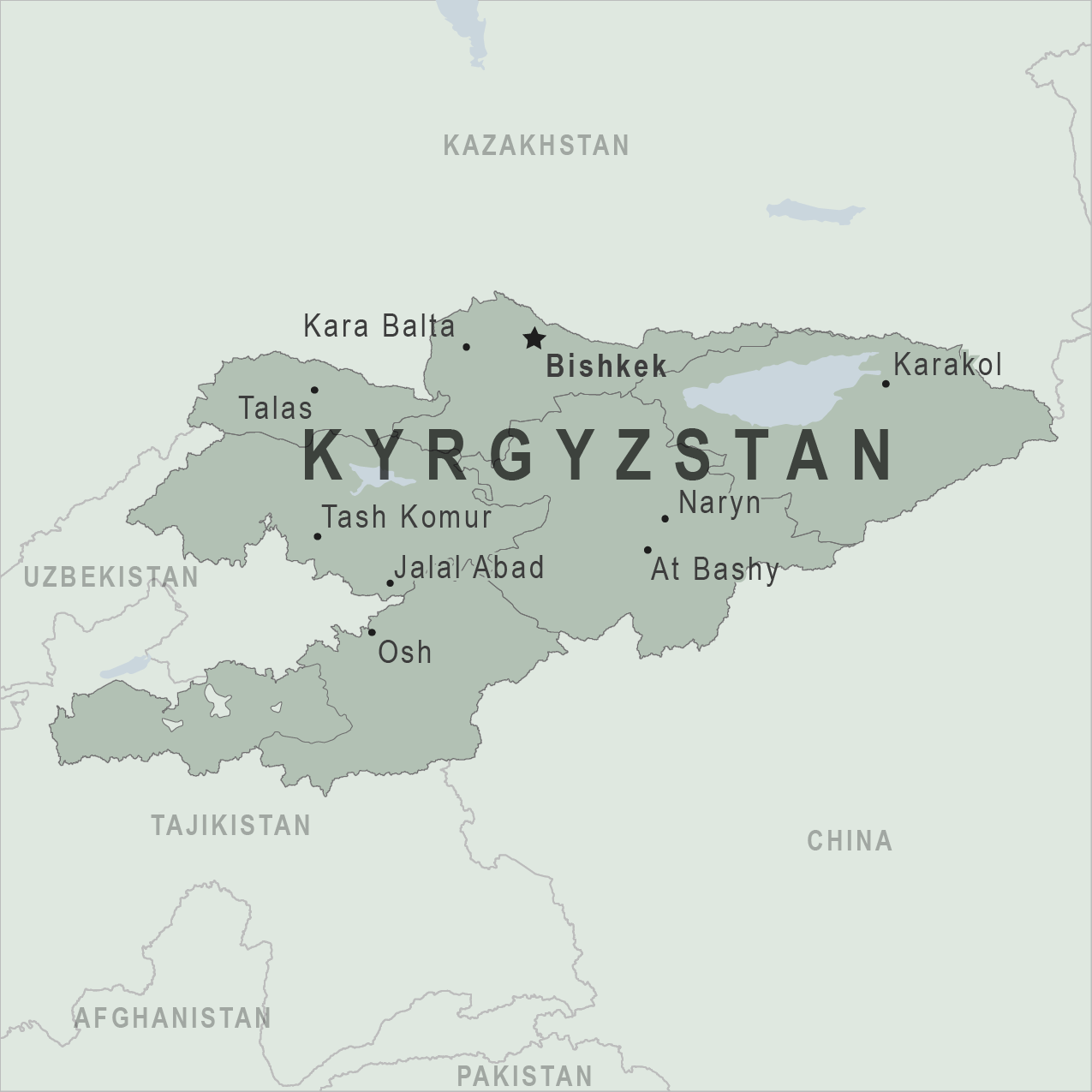
Be aware of current health issues in Kyrgyzstan. Learn how to protect yourself.
Level 1 Practice Usual Precautions
- Updated Global Measles March 22, 2024 Many international destinations are reporting increased numbers of cases of measles. Destination List: Afghanistan, Angola, Armenia, Azerbaijan, Benin, Burkina Faso, Burundi, Cameroon, Central African Republic, Chad, Côte d'Ivoire (Ivory Coast), Democratic Republic of the Congo, Djibouti, Equatorial Guinea, Ethiopia, Gabon, Ghana, India, Indonesia, Kazakhstan, Kyrgyzstan, Lebanon, Liberia, Libya, Malaysia, Mauritania, Nepal, Niger, Nigeria, Pakistan, Qatar, Republic of South Sudan, Republic of the Congo, Romania, Russia, Senegal, Somalia, Sri Lanka, Sudan, Syria, Tajikistan, Togo, Turkey, United Arab Emirates, Uzbekistan, Yemen, Zambia
⇧ Top
Check the vaccines and medicines list and visit your doctor at least a month before your trip to get vaccines or medicines you may need. If you or your doctor need help finding a location that provides certain vaccines or medicines, visit the Find a Clinic page.
Routine vaccines
Recommendations.
Make sure you are up-to-date on all routine vaccines before every trip. Some of these vaccines include
- Chickenpox (Varicella)
- Diphtheria-Tetanus-Pertussis
- Flu (influenza)
- Measles-Mumps-Rubella (MMR)
Immunization schedules
All eligible travelers should be up to date with their COVID-19 vaccines. Please see Your COVID-19 Vaccination for more information.
COVID-19 vaccine
Hepatitis A
Recommended for unvaccinated travelers one year old or older going to Kyrgyzstan.
Infants 6 to 11 months old should also be vaccinated against Hepatitis A. The dose does not count toward the routine 2-dose series.
Travelers allergic to a vaccine component or who are younger than 6 months should receive a single dose of immune globulin, which provides effective protection for up to 2 months depending on dosage given.
Unvaccinated travelers who are over 40 years old, immunocompromised, or have chronic medical conditions planning to depart to a risk area in less than 2 weeks should get the initial dose of vaccine and at the same appointment receive immune globulin.
Hepatitis A - CDC Yellow Book
Dosing info - Hep A
Hepatitis B
Recommended for unvaccinated travelers of all ages traveling to Kyrgyzstan.
Hepatitis B - CDC Yellow Book
Dosing info - Hep B
Cases of measles are on the rise worldwide. Travelers are at risk of measles if they have not been fully vaccinated at least two weeks prior to departure, or have not had measles in the past, and travel internationally to areas where measles is spreading.
All international travelers should be fully vaccinated against measles with the measles-mumps-rubella (MMR) vaccine, including an early dose for infants 6–11 months, according to CDC’s measles vaccination recommendations for international travel .
Measles (Rubeola) - CDC Yellow Book
Rabid dogs are commonly found in Kyrgyzstan. If you are bitten or scratched by a dog or other mammal while in Kyrgyzstan, there may be limited or no rabies treatment available.
Consider rabies vaccination before your trip if your activities mean you will be around dogs or wildlife.
Travelers more likely to encounter rabid animals include
- Campers, adventure travelers, or cave explorers (spelunkers)
- Veterinarians, animal handlers, field biologists, or laboratory workers handling animal specimens
- Visitors to rural areas
Since children are more likely to be bitten or scratched by a dog or other animals, consider rabies vaccination for children traveling to Kyrgyzstan.
Rabies - CDC Yellow Book
Tick-borne Encephalitis
For travelers moving or traveling to TBE-endemic areas
TBE vaccine is recommended for persons who will have extensive exposure to ticks based on their planned outdoor activities and itinerary.
TBE vaccine may be considered for persons who might engage in outdoor activities in areas ticks are likely to be found.
Tick-borne Encephalitis - CDC Yellow Book
Recommended for most travelers, especially those staying with friends or relatives or visiting smaller cities or rural areas.
Typhoid - CDC Yellow Book
Dosing info - Typhoid
Avoid contaminated water
Leptospirosis
How most people get sick (most common modes of transmission)
- Touching urine or other body fluids from an animal infected with leptospirosis
- Swimming or wading in urine-contaminated fresh water, or contact with urine-contaminated mud
- Drinking water or eating food contaminated with animal urine
- Avoid contaminated water and soil
Clinical Guidance
Avoid bug bites.
Crimean-Congo Hemorrhagic fever
- Tick bite
- Touching the body fluids of a person or animal infected with CCHF
- Avoid Bug Bites
Leishmaniasis
- Sand fly bite
Airborne & droplet
- Breathing in air or accidentally eating food contaminated with the urine, droppings, or saliva of infected rodents
- Bite from an infected rodent
- Less commonly, being around someone sick with hantavirus (only occurs with Andes virus)
- Avoid rodents and areas where they live
- Avoid sick people
Tuberculosis (TB)
- Breathe in TB bacteria that is in the air from an infected and contagious person coughing, speaking, or singing.
Learn actions you can take to stay healthy and safe on your trip. Vaccines cannot protect you from many diseases in Kyrgyzstan, so your behaviors are important.
Eat and drink safely
Food and water standards around the world vary based on the destination. Standards may also differ within a country and risk may change depending on activity type (e.g., hiking versus business trip). You can learn more about safe food and drink choices when traveling by accessing the resources below.
- Choose Safe Food and Drinks When Traveling
- Water Treatment Options When Hiking, Camping or Traveling
- Global Water, Sanitation and Hygiene | Healthy Water
- Avoid Contaminated Water During Travel
You can also visit the Department of State Country Information Pages for additional information about food and water safety.
Prevent bug bites
Bugs (like mosquitoes, ticks, and fleas) can spread a number of diseases in Kyrgyzstan. Many of these diseases cannot be prevented with a vaccine or medicine. You can reduce your risk by taking steps to prevent bug bites.
What can I do to prevent bug bites?
- Cover exposed skin by wearing long-sleeved shirts, long pants, and hats.
- Use an appropriate insect repellent (see below).
- Use permethrin-treated clothing and gear (such as boots, pants, socks, and tents). Do not use permethrin directly on skin.
- Stay and sleep in air-conditioned or screened rooms.
- Use a bed net if the area where you are sleeping is exposed to the outdoors.
What type of insect repellent should I use?
- FOR PROTECTION AGAINST TICKS AND MOSQUITOES: Use a repellent that contains 20% or more DEET for protection that lasts up to several hours.
- Picaridin (also known as KBR 3023, Bayrepel, and icaridin)
- Oil of lemon eucalyptus (OLE) or para-menthane-diol (PMD)
- 2-undecanone
- Always use insect repellent as directed.
What should I do if I am bitten by bugs?
- Avoid scratching bug bites, and apply hydrocortisone cream or calamine lotion to reduce the itching.
- Check your entire body for ticks after outdoor activity. Be sure to remove ticks properly.
What can I do to avoid bed bugs?
Although bed bugs do not carry disease, they are an annoyance. See our information page about avoiding bug bites for some easy tips to avoid them. For more information on bed bugs, see Bed Bugs .
For more detailed information on avoiding bug bites, see Avoid Bug Bites .
Stay safe outdoors
If your travel plans in Kyrgyzstan include outdoor activities, take these steps to stay safe and healthy during your trip.
- Stay alert to changing weather conditions and adjust your plans if conditions become unsafe.
- Prepare for activities by wearing the right clothes and packing protective items, such as bug spray, sunscreen, and a basic first aid kit.
- Consider learning basic first aid and CPR before travel. Bring a travel health kit with items appropriate for your activities.
- If you are outside for many hours in heat, eat salty snacks and drink water to stay hydrated and replace salt lost through sweating.
- Protect yourself from UV radiation : use sunscreen with an SPF of at least 15, wear protective clothing, and seek shade during the hottest time of day (10 a.m.–4 p.m.).
- Be especially careful during summer months and at high elevation. Because sunlight reflects off snow, sand, and water, sun exposure may be increased during activities like skiing, swimming, and sailing.
- Very cold temperatures can be dangerous. Dress in layers and cover heads, hands, and feet properly if you are visiting a cold location.
Stay safe around water
- Swim only in designated swimming areas. Obey lifeguards and warning flags on beaches.
- Practice safe boating—follow all boating safety laws, do not drink alcohol if driving a boat, and always wear a life jacket.
- Do not dive into shallow water.
- Do not swim in freshwater in developing areas or where sanitation is poor.
- Avoid swallowing water when swimming. Untreated water can carry germs that make you sick.
- To prevent infections, wear shoes on beaches where there may be animal waste.
Keep away from animals
Most animals avoid people, but they may attack if they feel threatened, are protecting their young or territory, or if they are injured or ill. Animal bites and scratches can lead to serious diseases such as rabies.
Follow these tips to protect yourself:
- Do not touch or feed any animals you do not know.
- Do not allow animals to lick open wounds, and do not get animal saliva in your eyes or mouth.
- Avoid rodents and their urine and feces.
- Traveling pets should be supervised closely and not allowed to come in contact with local animals.
- If you wake in a room with a bat, seek medical care immediately. Bat bites may be hard to see.
All animals can pose a threat, but be extra careful around dogs, bats, monkeys, sea animals such as jellyfish, and snakes. If you are bitten or scratched by an animal, immediately:
- Wash the wound with soap and clean water.
- Go to a doctor right away.
- Tell your doctor about your injury when you get back to the United States.
Consider buying medical evacuation insurance. Rabies is a deadly disease that must be treated quickly, and treatment may not be available in some countries.
Reduce your exposure to germs
Follow these tips to avoid getting sick or spreading illness to others while traveling:
- Wash your hands often, especially before eating.
- If soap and water aren’t available, clean hands with hand sanitizer (containing at least 60% alcohol).
- Don’t touch your eyes, nose, or mouth. If you need to touch your face, make sure your hands are clean.
- Cover your mouth and nose with a tissue or your sleeve (not your hands) when coughing or sneezing.
- Try to avoid contact with people who are sick.
- If you are sick, stay home or in your hotel room, unless you need medical care.
Avoid sharing body fluids
Diseases can be spread through body fluids, such as saliva, blood, vomit, and semen.
Protect yourself:
- Use latex condoms correctly.
- Do not inject drugs.
- Limit alcohol consumption. People take more risks when intoxicated.
- Do not share needles or any devices that can break the skin. That includes needles for tattoos, piercings, and acupuncture.
- If you receive medical or dental care, make sure the equipment is disinfected or sanitized.
Know how to get medical care while traveling
Plan for how you will get health care during your trip, should the need arise:
- Carry a list of local doctors and hospitals at your destination.
- Review your health insurance plan to determine what medical services it would cover during your trip. Consider purchasing travel health and medical evacuation insurance.
- Carry a card that identifies, in the local language, your blood type, chronic conditions or serious allergies, and the generic names of any medications you take.
- Some prescription drugs may be illegal in other countries. Call Kyrgyzstan’s embassy to verify that all of your prescription(s) are legal to bring with you.
- Bring all the medicines (including over-the-counter medicines) you think you might need during your trip, including extra in case of travel delays. Ask your doctor to help you get prescriptions filled early if you need to.
Many foreign hospitals and clinics are accredited by the Joint Commission International. A list of accredited facilities is available at their website ( www.jointcommissioninternational.org ).
In some countries, medicine (prescription and over-the-counter) may be substandard or counterfeit. Bring the medicines you will need from the United States to avoid having to buy them at your destination.
Select safe transportation
Motor vehicle crashes are the #1 killer of healthy US citizens in foreign countries.
In many places cars, buses, large trucks, rickshaws, bikes, people on foot, and even animals share the same lanes of traffic, increasing the risk for crashes.
Be smart when you are traveling on foot.
- Use sidewalks and marked crosswalks.
- Pay attention to the traffic around you, especially in crowded areas.
- Remember, people on foot do not always have the right of way in other countries.
Riding/Driving
Choose a safe vehicle.
- Choose official taxis or public transportation, such as trains and buses.
- Ride only in cars that have seatbelts.
- Avoid overcrowded, overloaded, top-heavy buses and minivans.
- Avoid riding on motorcycles or motorbikes, especially motorbike taxis. (Many crashes are caused by inexperienced motorbike drivers.)
- Choose newer vehicles—they may have more safety features, such as airbags, and be more reliable.
- Choose larger vehicles, which may provide more protection in crashes.
Think about the driver.
- Do not drive after drinking alcohol or ride with someone who has been drinking.
- Consider hiring a licensed, trained driver familiar with the area.
- Arrange payment before departing.
Follow basic safety tips.
- Wear a seatbelt at all times.
- Sit in the back seat of cars and taxis.
- When on motorbikes or bicycles, always wear a helmet. (Bring a helmet from home, if needed.)
- Avoid driving at night; street lighting in certain parts of Kyrgyzstan may be poor.
- Do not use a cell phone or text while driving (illegal in many countries).
- Travel during daylight hours only, especially in rural areas.
- If you choose to drive a vehicle in Kyrgyzstan, learn the local traffic laws and have the proper paperwork.
- Get any driving permits and insurance you may need. Get an International Driving Permit (IDP). Carry the IDP and a US-issued driver's license at all times.
- Check with your auto insurance policy's international coverage, and get more coverage if needed. Make sure you have liability insurance.
- Avoid using local, unscheduled aircraft.
- If possible, fly on larger planes (more than 30 seats); larger airplanes are more likely to have regular safety inspections.
- Try to schedule flights during daylight hours and in good weather.
Medical Evacuation Insurance
If you are seriously injured, emergency care may not be available or may not meet US standards. Trauma care centers are uncommon outside urban areas. Having medical evacuation insurance can be helpful for these reasons.
Helpful Resources
Road Safety Overseas (Information from the US Department of State): Includes tips on driving in other countries, International Driving Permits, auto insurance, and other resources.
The Association for International Road Travel has country-specific Road Travel Reports available for most countries for a minimal fee.
Maintain personal security
Use the same common sense traveling overseas that you would at home, and always stay alert and aware of your surroundings.
Before you leave
- Research your destination(s), including local laws, customs, and culture.
- Monitor travel advisories and alerts and read travel tips from the US Department of State.
- Enroll in the Smart Traveler Enrollment Program (STEP) .
- Leave a copy of your itinerary, contact information, credit cards, and passport with someone at home.
- Pack as light as possible, and leave at home any item you could not replace.
While at your destination(s)
- Carry contact information for the nearest US embassy or consulate .
- Carry a photocopy of your passport and entry stamp; leave the actual passport securely in your hotel.
- Follow all local laws and social customs.
- Do not wear expensive clothing or jewelry.
- Always keep hotel doors locked, and store valuables in secure areas.
- If possible, choose hotel rooms between the 2nd and 6th floors.
Healthy Travel Packing List
Use the Healthy Travel Packing List for Kyrgyzstan for a list of health-related items to consider packing for your trip. Talk to your doctor about which items are most important for you.
Why does CDC recommend packing these health-related items?
It’s best to be prepared to prevent and treat common illnesses and injuries. Some supplies and medicines may be difficult to find at your destination, may have different names, or may have different ingredients than what you normally use.
If you are not feeling well after your trip, you may need to see a doctor. If you need help finding a travel medicine specialist, see Find a Clinic . Be sure to tell your doctor about your travel, including where you went and what you did on your trip. Also tell your doctor if you were bitten or scratched by an animal while traveling.
For more information on what to do if you are sick after your trip, see Getting Sick after Travel .
Map Disclaimer - The boundaries and names shown and the designations used on maps do not imply the expression of any opinion whatsoever on the part of the Centers for Disease Control and Prevention concerning the legal status of any country, territory, city or area or of its authorities, or concerning the delimitation of its frontiers or boundaries. Approximate border lines for which there may not yet be full agreement are generally marked.
Other Destinations
If you need help finding travel information:
Message & data rates may apply. CDC Privacy Policy
File Formats Help:
- Adobe PDF file
- Microsoft PowerPoint file
- Microsoft Word file
- Microsoft Excel file
- Audio/Video file
- Apple Quicktime file
- RealPlayer file
- Zip Archive file
Exit Notification / Disclaimer Policy
- The Centers for Disease Control and Prevention (CDC) cannot attest to the accuracy of a non-federal website.
- Linking to a non-federal website does not constitute an endorsement by CDC or any of its employees of the sponsors or the information and products presented on the website.
- You will be subject to the destination website's privacy policy when you follow the link.
- CDC is not responsible for Section 508 compliance (accessibility) on other federal or private website.
- Where to go
- Types of tourism

- Food and drink
- Health and wellness vacations
- Historical, Cultural sites
- Holidays in jailoo
- Hunting with eagles
- Jeep and motorbike tours
- Mountain, Passes, Valleys
- Mountaineering
- Natural reserves, National Parks
- Natural wonders
- Sites/Settlements
- Ski resorts
- Unesco list
- Whitewater rafting and kayaking
- World Nomad Games
- Kumis treatment
- Skiing and snowboarding
- Hiking & trekking
- Horseback tours
- Living in yurts
Discover Kyrgyzstan Start Travelling
Discover Kyrgyzstan Start Travelling Chatyr-Kol Lake
Top destinations
Bishkek Bishkek
SULAIMAN TOO Osh
ISSYK-KUL LAKE Issykkul
ALA-TOO SQUARE Bishkek
Land of celestial mountains
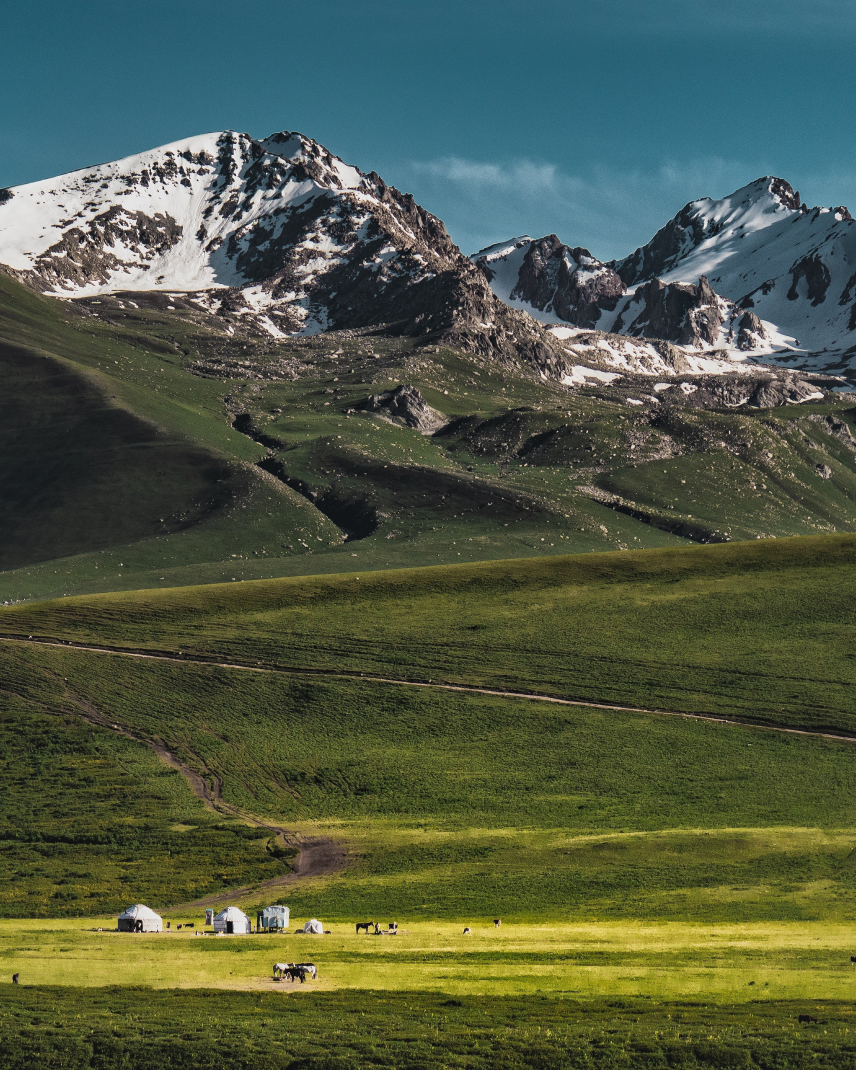
Kyrgyzstan, nestled in the heart of Central Asia, is a land of stunning landscapes, rich cultural heritage, and warm hospitality. With its diverse attractions and unique experiences, Kyrgyzstan has become an increasingly popular destination for travelers seeking an off-the-beaten-path adventure. Let's delve into the wonders of Kyrgyzstan and discover why it should be on your travel bucket list.
Kyrgyzstan offers various travel opportunities catering to different interests and preferences. Nature enthusiasts will be captivated by the country's breathtaking landscapes, including the majestic Tien Shan Mountains, crystal-clear lakes such as Issyk-Kul and Song Kol, and picturesque valleys like the Ala-Archa National Park. These natural wonders provide a perfect backdrop for hiking, trekking, horseback riding, and camping.
Traveling to Kyrgyzstan allows you to engage with the warm and welcoming local communities. Experience the hospitality of Kyrgyz nomads by staying in yurts, traditional nomadic dwellings. Enjoy authentic Kyrgyz cuisine, which features hearty dishes like beshbarmak and manti, and sip on fragrant tea while listening to traditional music and folklore.
Kyrgyzstan is also gaining recognition as a destination for adventure tourism. Embark on thrilling outdoor activities, including mountaineering, skiing, paragliding, and white-water rafting. The country's pristine nature and untouched landscapes offer an exhilarating playground for adrenaline seekers.
When planning your trip to Kyrgyzstan, consider exploring the unique cultural events and festivals throughout the year. The Nomad Games, World Nomad Games, and Kyrgyzstan's Independence Day celebrations are just a few examples of the vibrant festivities that showcase the country's traditions, arts, and sports.
Kyrgyzstan's tourism industry is growing, and the government has taken steps to facilitate travel to the country. Visa requirements have been eased for many nationalities, making it more accessible for international visitors. Additionally, a range of accommodations, from budget-friendly guesthouses to luxury yurt camps and boutique hotels, caters to various traveler preferences.
Visiting Kyrgyzstan will undoubtedly leave you with unforgettable memories and a deep appreciation for its natural beauty and cultural heritage. Kyrgyzstan has everything if you're seeking outdoor adventures, cultural immersion, or a unique travel experience. So pack your bags, embark on a journey to this enchanting destination, and let Kyrgyzstan's wonders mesmerize you.
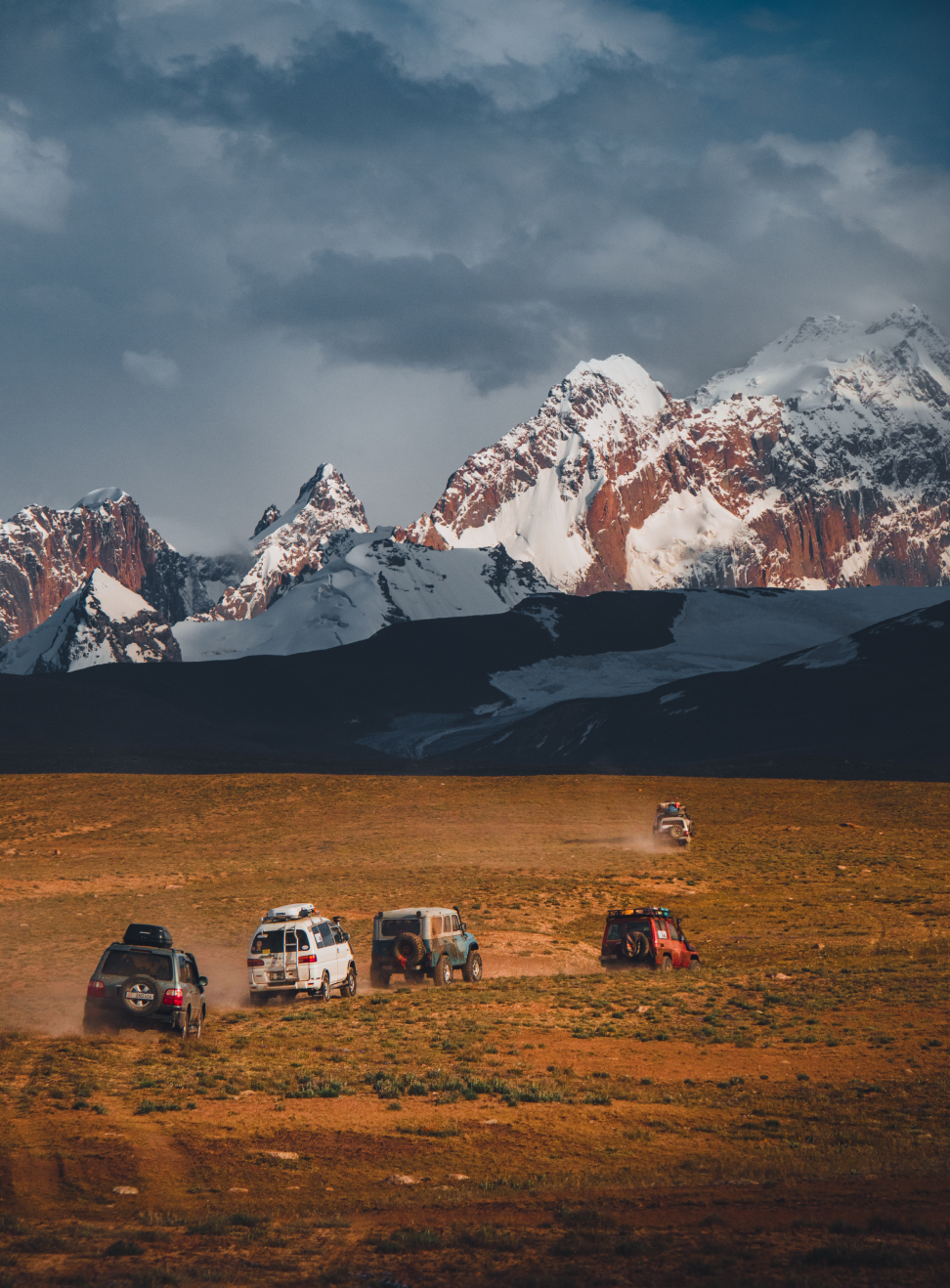
Thing to do
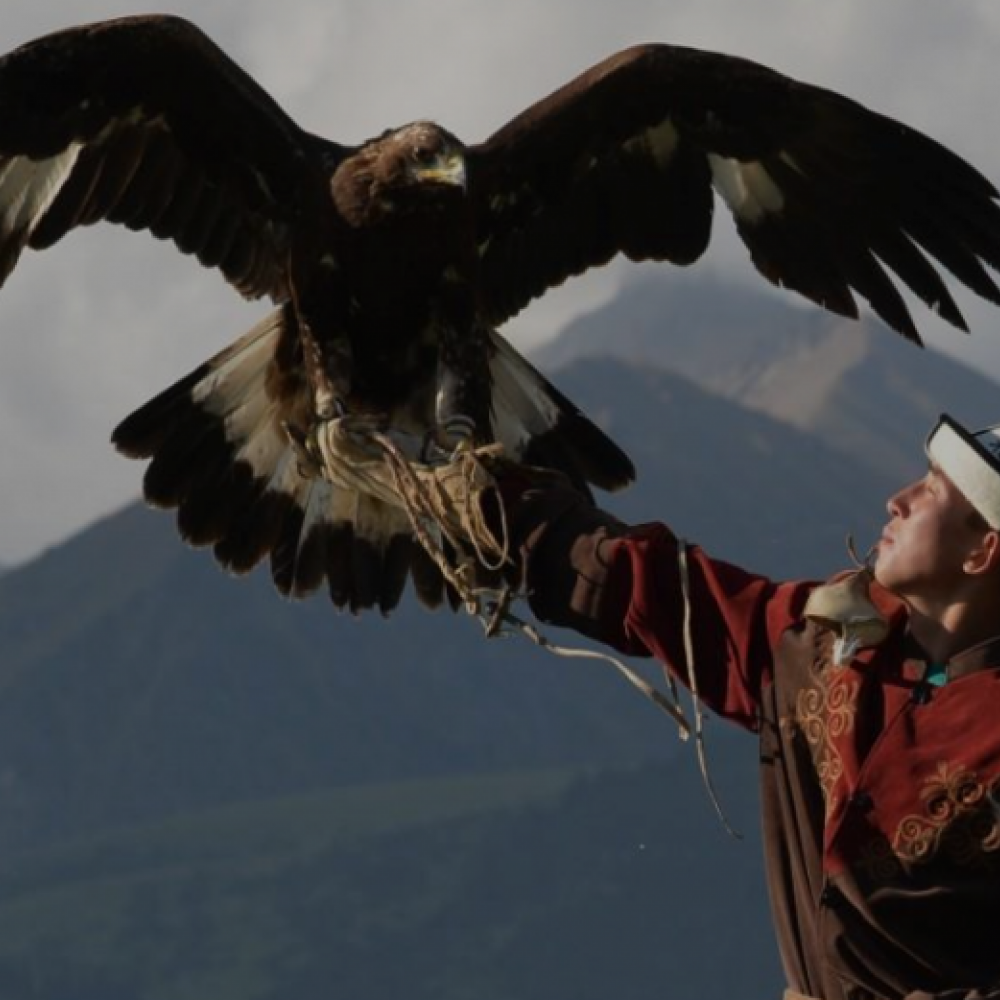
Tourism types
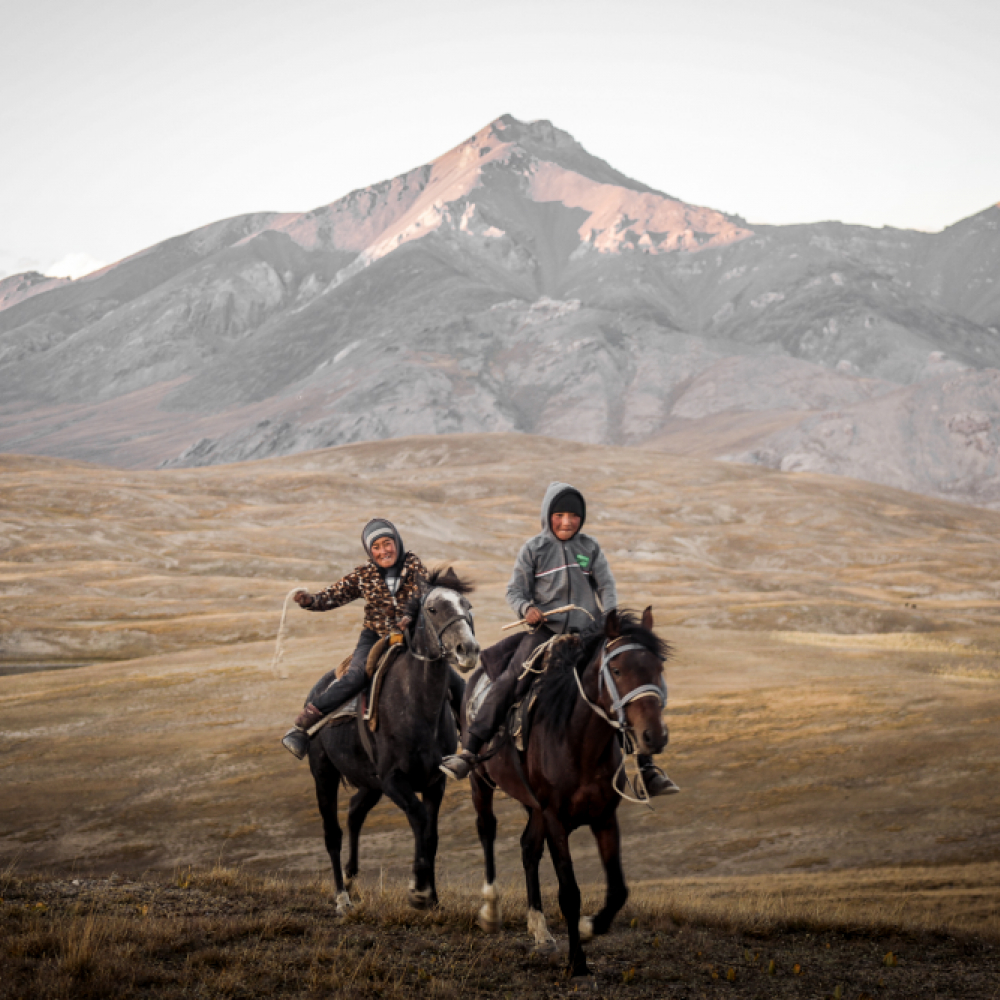
SULAYMAN-TOO Osh
UZGEN MINARET Osh

MANAS PEAK Talas
KIROV RESERVOIR Talas
GUMBEZ OF MANAS Talas
BESH TASH NATIONAL PARK Talas
UZGEN (OZGON) MINARET Osh
KYRGYZ ATA NATIONAL PARK Osh
ALAI VALLEY Osh
ABSHYR ATA WATERFALL Osh
TASH RABAT CARAVANSERAI Naryn
SONG-KUL LAKE Naryn
ORTO TOKOY RESERVOIR Naryn
NARYN STATE RESERVE Naryn
KEL-SUU LAKE Naryn
EKI NARYN VALLEY Naryn
CHATYR-KUL LAKE Naryn
AK-SAI VALLEY Naryn
SARY CHELEK LAKE Jalalabad
SAIMALUU TASH STATE NATURAL PARK Jalalabad
MAUSOLEUM OF SHAH FAZIL Jalalabad
ARSLANBOB WALNUT FORESTS Jalalabad
TUZ-KOL (KARA-KOL) Issykkul
SARYCHAT-EERTASH STATE RESERVE Issykkul
RUH ORDO CULTURAL CENTER Issykkul
ORNOK PETROGLYPHS Issykkul
MANJYLY ATA VALLEY Issykkul
JETI OGUZ GORGE Issykkul
HOLY TRINITY ORTHODOX CHURCH Issykkul
FAIRY TALE CANYON Issykkul
DUNGAN MOSQUE Issykkul
CHONG AK SUU GORGE Issykkul
BARSKOON GORGE Issykkul
ALTYN ARASHAN THERMAL RESORT Issykkul
ALAKUL LAKE Issykkul
AK-SUU GORGE Issykkul
ZIL SKI RESORT Chui
TOO-ASHU PASS Chui
SUUSAMYR VALLEY Chui
KORONA PEAK Chui
KONORCHEK CANYONS Chui
KEL-TOR GORGE Chui
KEGETY GORGE Chui
ISSYK-ATA GORGE Chui
CHUNKURCHAK SKI RESORT Chui
CHONG-KEMIN VALLEY Chui
BURANA TOWER Chui
BOOM GORGE Chui
ALAMEDIN GORGE Chui
ALA-ARCHA NATIONAL PARK Chui
ATA BEYIT MEMORIAL COMPLEX Bishkek
SARKENT NATIONAL NATURE RESERVE Batken
AI KÖL LAKE Batken
KARAVSHIN GORGE Batken
AIGUL TASH MOUNTAIN Batken
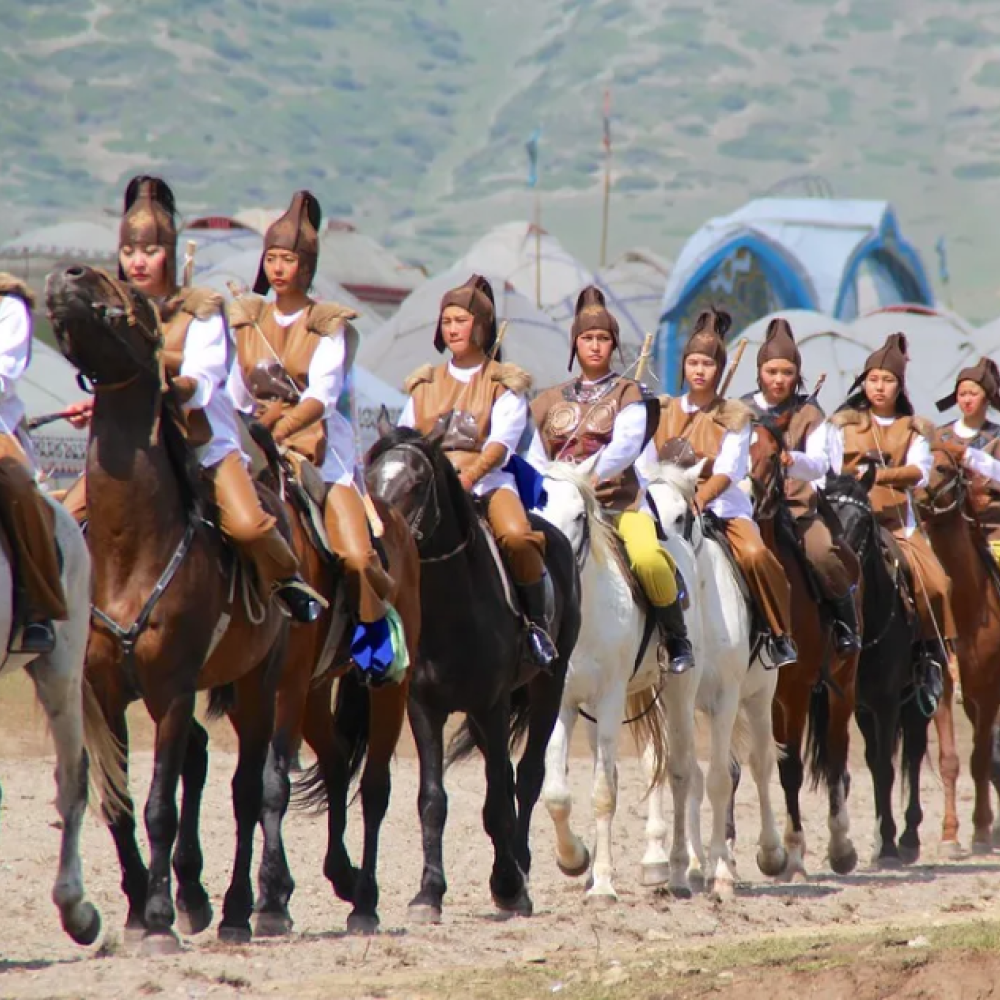
The Issyk-Kul Lake is located in the northwestern part of Kyrgyzstan, 1600 meters above sea level. It is the second largest mountain lake in the world, after Titicaca in South America. This lake, with its slight salty water and framework of forests and mountain ranges, is a true miracle of nature.
General caution: As in any other country, it is advised to be careful with personal belongings and valuables, especially in public places and tourist areas. Watch your belongings, do not leave them unattended.
Public Safety: In general, public safety in Kyrgyzstan is good. However, it is recommended to take general precautions, avoid large crowds, especially during public events, and be aware of your surroundings.
Public transport in Bishkek:
Buses: The city has a network of bus routes covering the main areas. They are an affordable and budget-friendly way to get around. Minibuses: Popular means of transportation are fixed-route taxis (minibuses). They are more flexible and can take you to different parts of the city. Taxi: Taxis are also widely available and may be a more convenient option. It is recommended to use licensed taxis or ask the locals for advice on reliable companies.
Sights worth visiting in Bishkek:
Ala-Too Square: The central square of the city, where government buildings and monuments are located. Panoramic mountain views: Bishkek is surrounded by majestic mountains, and the panoramic view from Liberty Mountain is one of the main attractions. Museums: There are several interesting museums in Bishkek, such as the National Museum of Art, the Museum of History and Archeology, and the Museum of the Frunze Time.
Local customs and traditions in Kyrgyzstan:
Hospitality: Kyrgyzstan is famous for its hospitality. When visiting the home of local residents, tea and national treats are usually offered. Ethnic Festivals: Kyrgyzstan is rich in numerous ethnic groups, and national festivals such as Navruz (new year), Cholpon-Ata (koumiss games) and Urayum (grazing in the mountains) offer a unique opportunity to experience local culture and traditions.
Local dishes and drinks worth trying:
Beshbarmak: National Kyrgyz dish consisting of cuts of meat (usually lamb) and thinly sliced dough. Manti: Steam dumplings, usually stuffed with meat. Lagman: Thin noodles with meat, vegetables and spices. Koumiss: Fermented mare's milk, which is the national drink and has medicinal properties.
Does “Central Asia” conjure up images of craggy mountains, vast grasslands, nomadic tribes on horseback, and meandering rivers in your mind? You would get to see all this and more in Kyrgyzstan, a favorite travel destination in Central Asia for discerning travelers from around the world.
With a visa-free regime for citizens of more than 40 countries, Kyrgyzstan widely opens its door and its heart to guests of many countries. Come explore our history, culture and hospitality!
Click the link below for more information about visa regulations.
https://en.wikipedia.org/wiki/Visa_policy_of_Kyrgyzstan
Tips and how to travel to Kyrgyzstan (2024)
By Joan Torres 43 Comments Last updated on December 29, 2023
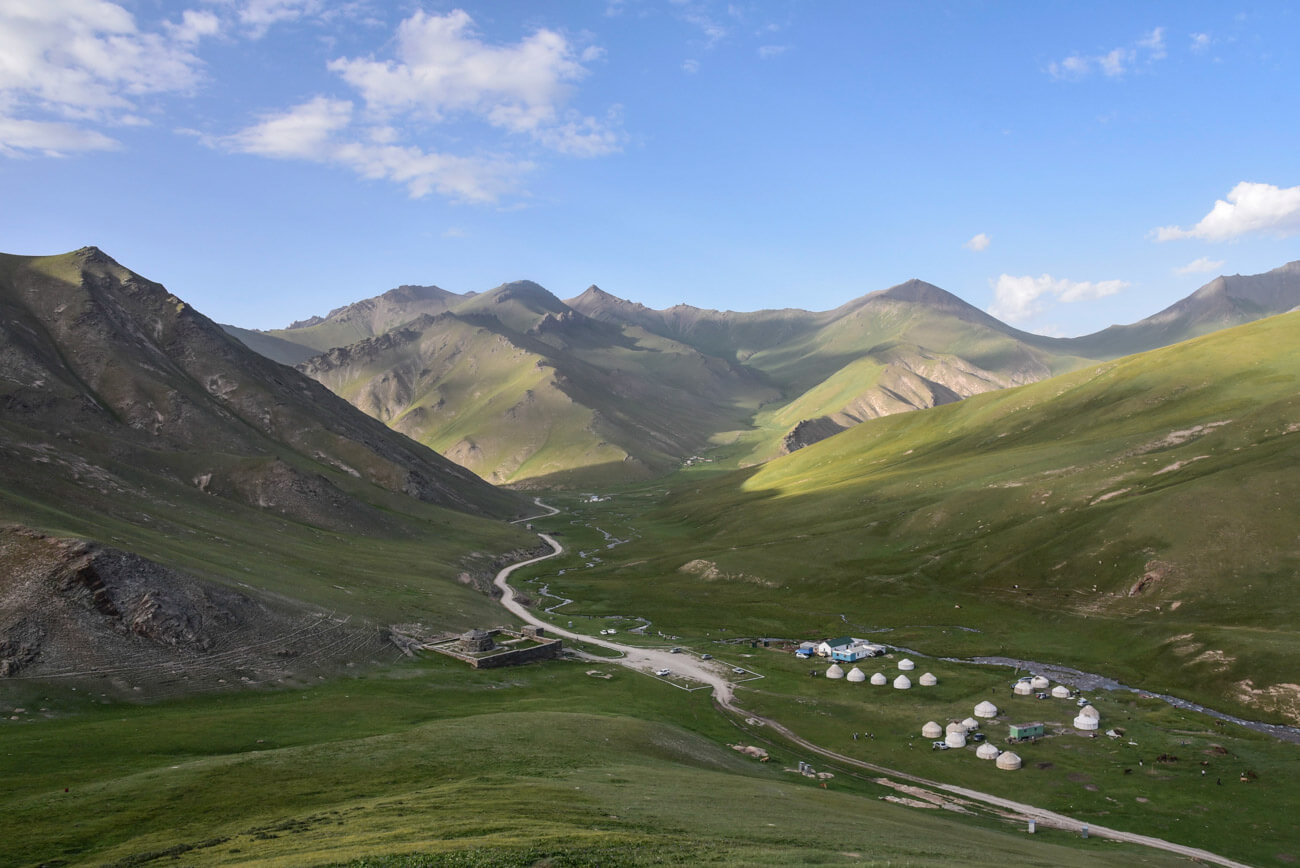
From first-class treks to a very accessible nomadic culture, horse riding and hospitable people, traveling to Kyrgyzstan is the experience, and destination, for those seeking an off the beaten track (but easy) adventure.
After spending two entire months traveling in Kyrgyzstan , I have compiled all the necessary information that will help you plan your trip, from visas and bureaucracy to accommodation, transportation and plenty of cultural facts.

In this Kyrgyzstan travel guide you will find:
Table of Contents
- COVID-19 travel bans
- Travel insurance
- Best time to visit
- How to get in
- Is it safe?
- Top 5 experiences
- The country, people, and culture
- Food and alcohol
- Nomadic life
- Accommodation
- Transportation
- More information
eSIM card for browsing when traveling in Kyrgyzstan
With Holafly , you can now get an electronic SIM card for Kyrgyzstan from home with just 2 clicks.
5% discount with the following code:
AGAINSTTHECOMPASS
Read: Packing list for trekking in Central Asia
😷 COVID-19 travel restrictions for Kyrgyzstan
As of May 2022, Coronavirus restrictions have been lifted for traveling to Kyrgyzstan .
COVID-19 travel insurance for Kyrgyzstan
IATI Insurance is one of the few providers that offers full Coronavirus coverage, not only when it comes to treatment, but also cancellations costs in case you tested positive before departure.
Moreover, it provides coverage for a very big bunch of adventure activities, including trekking in high altitudes.
Readers of Against the Compass can get an exclusive 5% discount .
🪪 Visa for traveling to Kyrgyzstan
The most liberal visa regime in central asia.
Most nationalities get a 60-day free visa on arrival, both at the airport and overland.
If you want to renew it, you just need to cross the Kazakh border (1 hour from Bishkek) and come back on the same day.
These countries are: EU countries (except for Bulgaria, Cyprus, and Romania), Andorra, Argentina, Australia, Bahrain, Bosnia and Herzegovina, Brunei, Canada, Chile, Kuwait, Monaco, New Zealand, Oman , Qatar, Saudi Arabia , Singapore, South Korea, United Arab Emirates , United States, Uzbekistan , Vatican City. Japan and Russia can get an indefinite stay.
The rest of nationalities can apply for a Kyrgyz e-visa
Since September 2017, most of the remaining countries can apply for an e-visa through the official portal . It takes around 1 week and costs 63USD.
Moreover, if you are in possession of an e-visa, you can travel to Kyrgyzstan both via land and air.
Be aware that when applying for an e-visa, most nationalities will also need to be in possession of an LOI, EXCEPT for citizens of:
Brazil, Bulgaria, Cyprus, Indonesia, Israel, Macedonia, Mexico, Philippines, Romania, San Marino, South Africa, Serbia, Thailand, Turkey, Venezuela.
If you are not on any of the above lists, read the Kyrgyzstan visa section of Caravanistan for further information on visas.
Extending your visa does not seem to be possible anymore
We tried to extend our visa and they said that, since May 2017, extensions aren’t possible anymore. We tried to extend it in both Karakol and Bishkek.
It is easier to travel to Almaty and come back.
Overstaying can be expensive
If you overstayed, you won’t be let to get out of the country unless you are in possession of an exit visa, which you can get at the foreign office located at 58 Kievskaya street in Bishkek, after paying the respective fine.
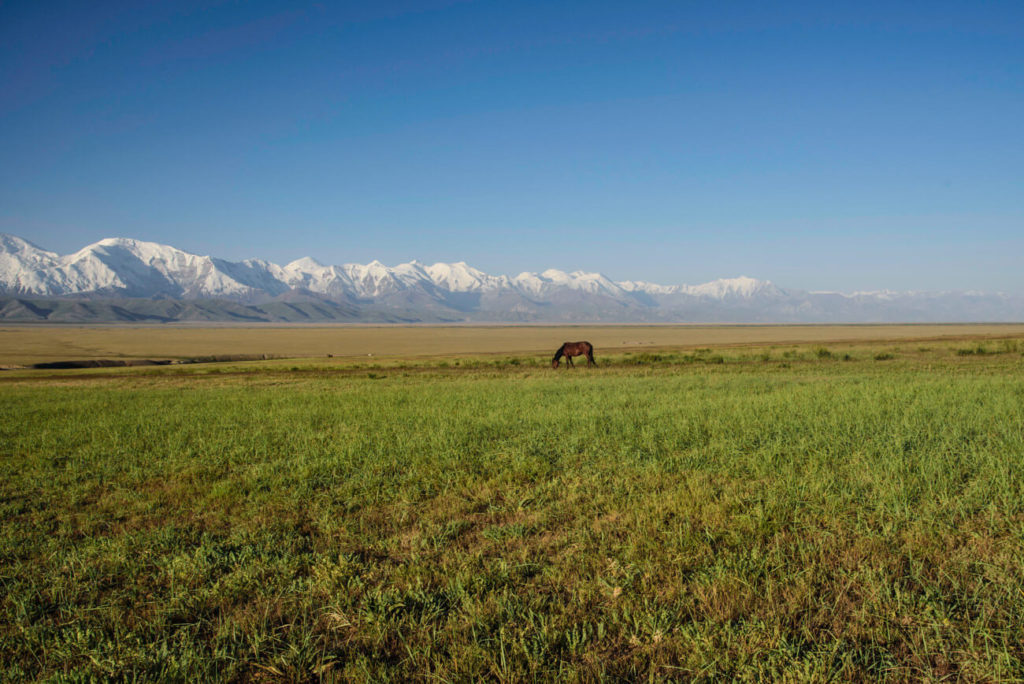

🚑 Travel Insurance for Kyrgyzstan
If you visit Kyrgyzstan, travel insurance is a must, as accidents do happen in the mountains. Actually, during a horse trek in Tash Rabat , I fell off the horse and had to stay in bed for nearly 2 weeks.
It was a pretty bad (and scary accident). I had to go to the hospital, all the way to Bishkek, where they carried out different kinds of tests on me which, in the end, turned out to be expensive. Luckily, I was fully insured.
For Kyrgyzstan, I recommend IATI Insurance :
- Different plans for all budgets
- It covers a big bunch of adventure activities, including trekking in high altitudes
- Covers both short-term trips and 1-year long trips.
- COVID-10 coverage
- Readers of this blog can get a 5% exclusive discount
⛅ Best time to visit Kyrgyzstan
My favorite month for traveling to kyrgyzstan: september.
Why? July & August would be the ideal season for trekking, especially if you plan to go high in the mountains as, during these two months, the weather is warmer and the likelihood of rain is lower. However, Kyrgyzstan is becoming a popular destination, which means that some areas may be crowded.
In September, nevertheless, most crowds will be gone, and the weather will still be warm enough for trekking, and that is why I consider September to be the best month for visiting Kyrgyzstan .
Travel in Kyrgyzstan during High season (mid-June to Mid-September)
- Pros: Best season for trekking, loads of nomads
- Cons: Crowded, plus it can be really hot in Bishkek and other low-altitude areas
Read my packing list for trekking in Central Asia
Travel in Kyrgyzstan during Shoulder season (Spring and Autumn)
- Pros: In late spring and early autumn, you can do some cool treks
- Cons: High mountains may be not accessible, unpredictable weather, nomads may not be there
Travel in Kyrgyzstan during Low season (mid-November to March)
- Pros: Winter landscape, snow, no people
- Cons: No trekking, no nomads
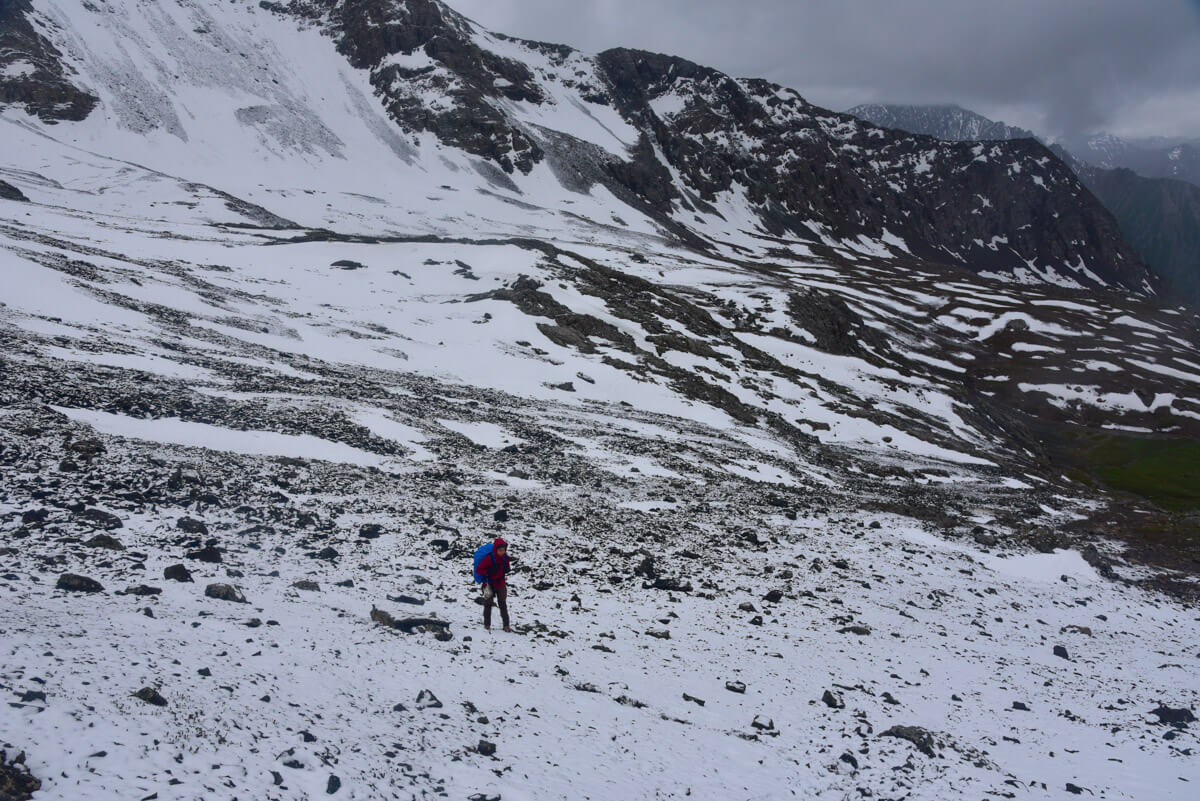
🛫 How to get to Kyrgyzstan
How to travel to kyrgyzstan by air.
Getting to the International Airport of Bishkek is fairly easy, as it has quite a few connections with several airports in Europe. Moreover, you should also check Pegasus, a budget airline from Istanbul with daily flights to Bishkek. Alternatively, check out the flights to Almaty, as they are usually cheaper and it is very close to Bishkek.
How to travel to Kyrgyzstan by land
Kyrgyzstan shares a border with:
- China – There are 2 open borders, Irkeshtam and Torugart. Crossing at Torugart requires having a special, expensive Chinese permit. Crossing via Irkeshtam is fairly easy and you can read the full report here .
- Tajikistan – There are 6 border crossings and 4 of them are open to foreigners. The most obvious is the Kyzyl Art border crossing , which is the one that follows the Pamir Highway. For more information, read the latest Caravanistan updates .
- Kazakhstan – There are like 7 border crossings, but the easiest ones are Karkara and Kordai. For more information, read the latest Caravanistan updates .
- Uzbekistan – There are nowadays 4 borders but only 3 are open as of 2019. For more information, read the latest Caravanistan updates .
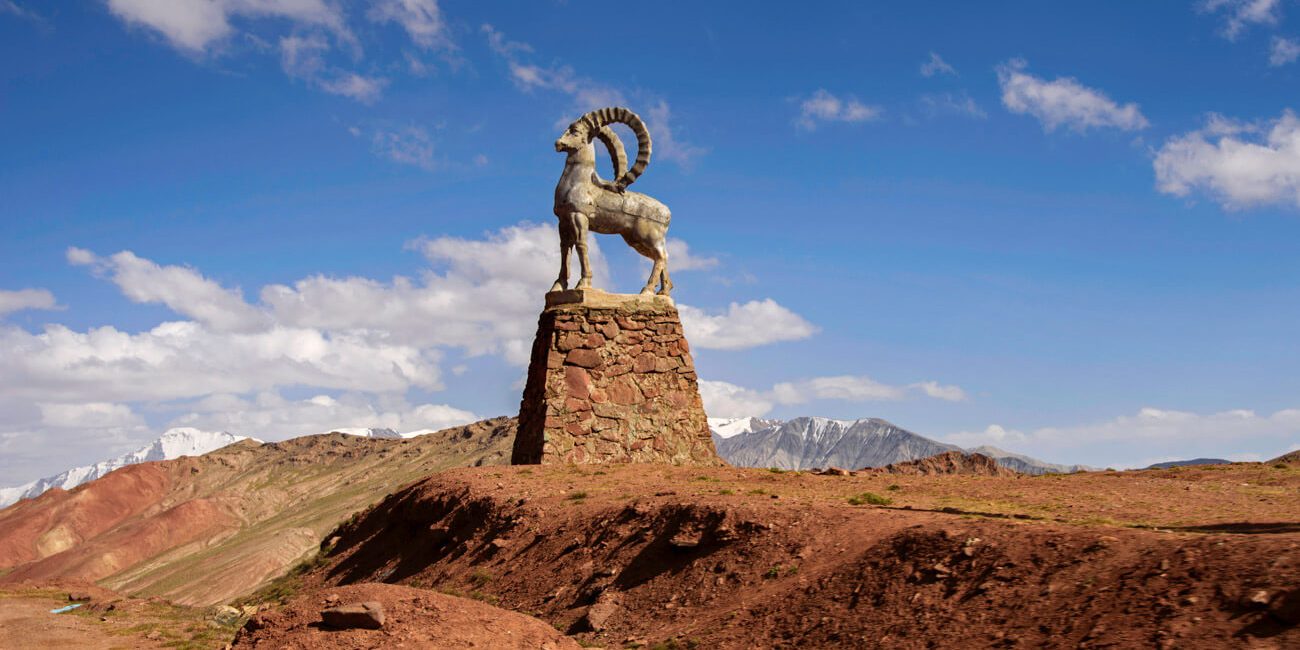
⚠️ Is it safe to travel to Kyrgyzstan?
Remember to get travel insurance for Kyrgyzstan IATI Insurance covers high altitude trekking + offers long term plans, so it’s perfect for Kyrgyzstan and Central Asia Get your 5% exclusive discount by purchasing via this link .
Something you need to know is that the term Stan doesn’t mean a place is dangerous, but Stan means land , so Kyrgyzstan means the land of Kyrgyz.
Kyrgyzstan is a safe destination. Period.
I mean, just check the FCO advice and you will see that all they say is that Kyrgyzstan is a very safe country, and here you need to take into account that the FCO advice is always absolutely biased, meaning that tends to see danger where there is not, especially in the Middle East .
Solo travelers will be just fine and whereas I can’t speak for women, I know many women who have been there, and all they told me was positive experiences.
The only potential danger you may hear about is that Bishkek used to be infamous for its after-midnight crime, mainly targeting drunk people on their way home from the bars. The situation, however, has dramatically improved but, if that is a concern for you, just take a taxi when you go back home.

🛖 Top 5 experiences in Kyrgyzstan
For all the places to visit, don’t forget to check my 1-month Kyrgyzstan itinerary
Stay with Kyrgyz nomads
Experiencing the nomadic life is one of the greatest Kyrgyz experiences. From staying in a yurt to helping them preparing kurut , their local cheese, during our 2-month journey across the country, we met loads of nomads with we had awesome experiences.
However, with the tourism increase, some nomadic camps have become too commercial, and what I recommend is that you try to find the most authentic ones. How? Well, by getting off the beaten track but also, if you go to Song Kul, instead of staying at the CBT camp where everybody stays, just go across the lake.
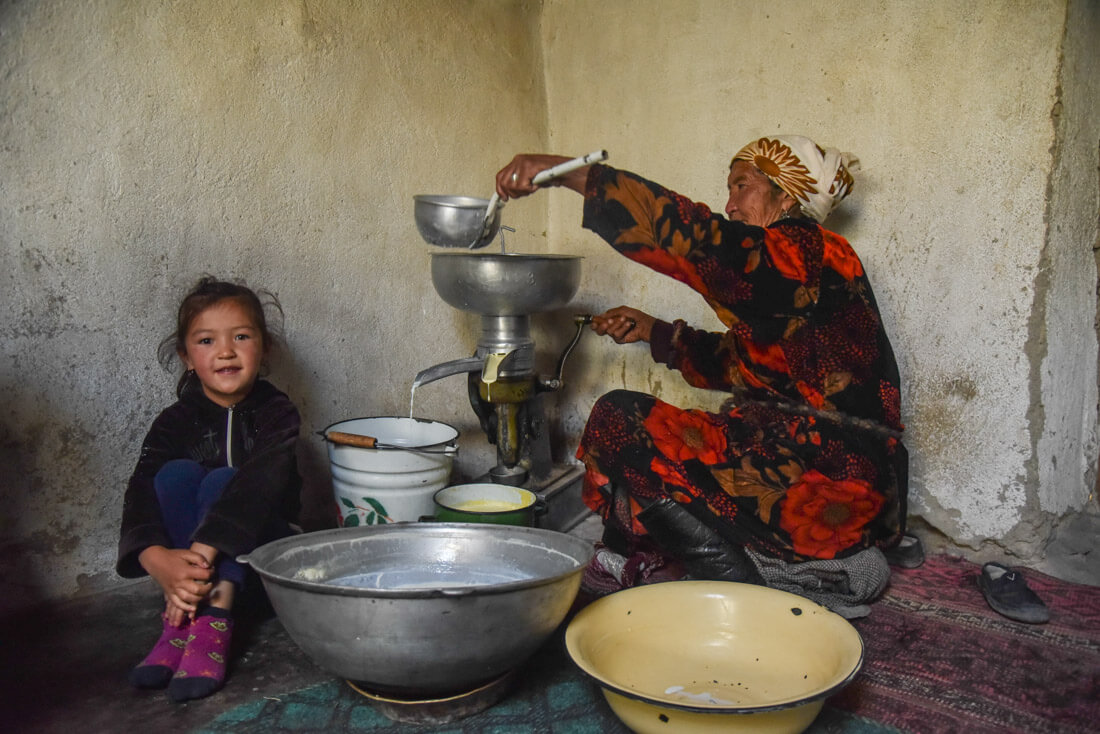
Watch nomad games, but try to find out where the local games happen (don’t go to the touristic ones)
The ancient nomad sports in Kyrgyzstan are just crazy, and bizarre.
From horse wrestling to playing polo with a dead goat instead of an actual ball (Ulak tariysh), the nomadic games of Kyrgyzstan are, definitely, a must-see.
Every summer, some tourist organizations, like CBT, organize nomad games for tourists, in Song Kul and places like that, but I recommend you find the local ones, as the vibe is just great, plus they do a larger variety of sports.
To be very honest, I didn’t manage to see a local game in Kyrgyzstan, but I did in Tajikistan, near the Kyrgyz border (where most Tajiks are ethnically Kyrgyz), and it was just awesome.
Go trekking on a horse
Many people may feel bad for riding a horse, but the truth is that Kyrgyzstan is the land of horses and even today, in the rural areas, they are the preferred way of transportation.
Those horses are really used to go over high altitude mountain passes, and you definitely get a different experience, and perspective than going on foot.
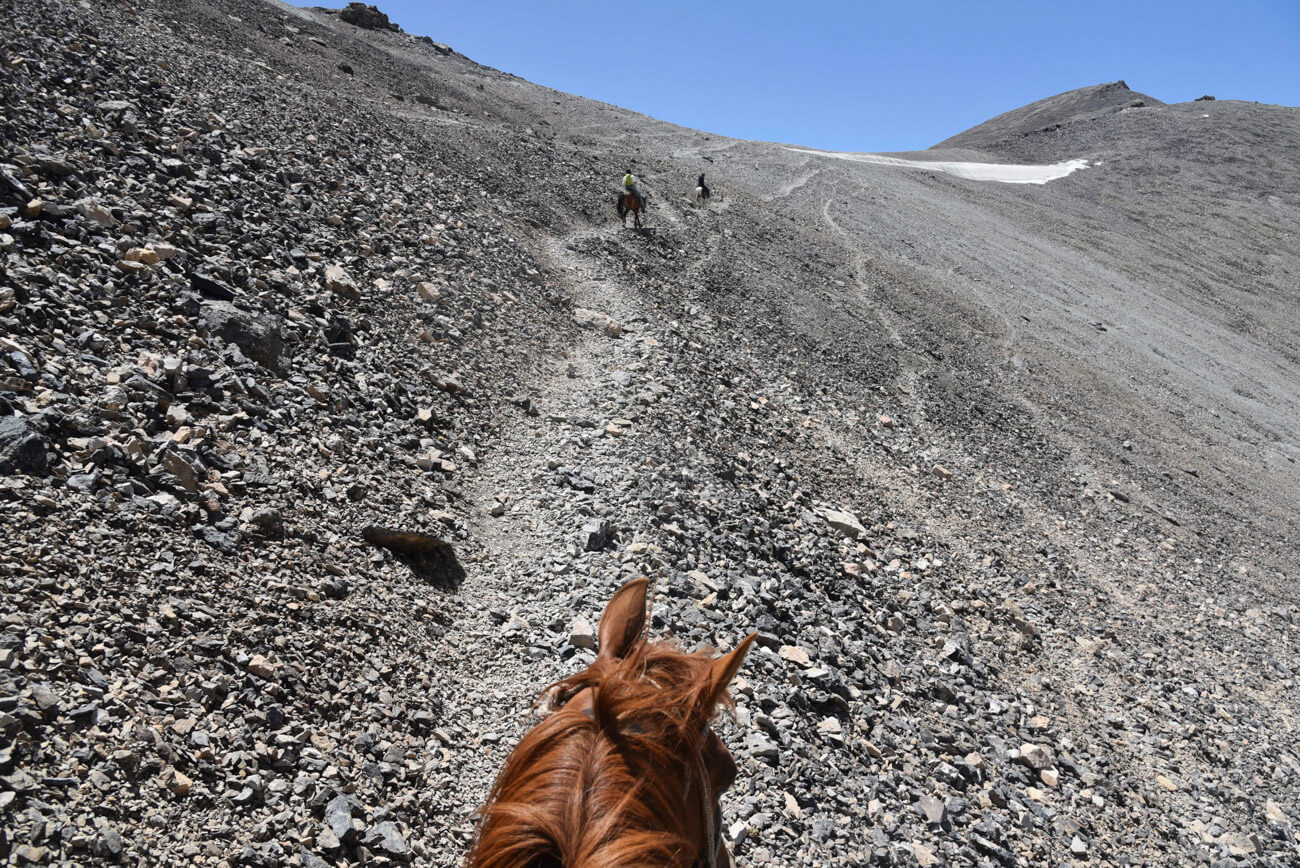
Go trekking in some of the most mind-blowing mountains ever
I truly believe that, in a matter of years, Kyrgyzstan will become the trekking destination of reference, competing directly with Nepal and Argentina, and the reason is that its mountains are absolutely jaw-dropping, plus they are much more accessible than any other destination I know.
Visit the remotest Silk Road Heritage sites
Kyrgyzstan has only a small bunch of Silk Road Heritage sites, but the few it has are truly epic, remote and placed in the most epic locations.

Kyrgyzstan is about nature and nomadic life With very few Silk Road Heritage sites compared to its neighbor Uzbekistan , in Kyrgyzstan, there’s not much to do besides wandering around its gorgeous mountains and experiencing the nomadic life. The truth is that, with the exception of Bishkek and Arslanbob, most towns in Kyrgyzstan are pretty boring as there is no distinctive architecture, soul and social life, as Kyrgyzstan has been a nomadic land for many centuries. When you travel in Kyrgyzstan, you will see that towns are merely used as a base to explore the mountains or take a rest from them.
📚 Books for traveling to Kyrgyzstan
For more books to Kyrgyzstan and Central Asia, check:
The best 28 books on Central Asia
Kyrgyzstan Travel Guide by Bradt
By far, the best and most complete book guide to Kyrgyzstan. Bradt writes the most awesome guides, as they are always filled with great cultural insights and personal experiences. I always buy their Kindle version for whatever country I go to.

Central Asia Guide by Lonely Planet
A classic. If you are traveling throughout the region, this might be a more economical option, rather than buying one guide per country but remember that it is not as insightful as Bradt’s.
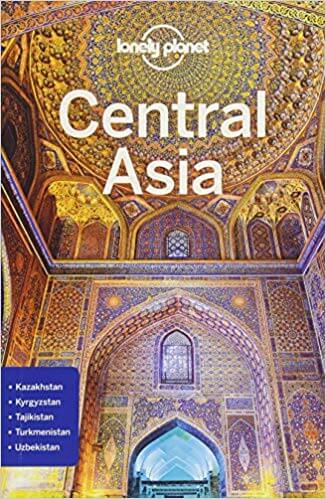
Don’t forget to check my list of the best books on Central Asia and the Silk Road
🕌 15 facts about Kyrgyzstan, its people and culture
1 – Kyrgyzstan used to be part of the Soviet Union – It acquired its independence in 1991, with the collapse of the USSR.
2 – The origin of the Kyrgyz – Kyrgyz people are an ethnic nomadic group which is believed to have come from a region within Siberia, during the 10th and 15th centuries.
Originally, they used to have red hair but, over the centuries, they have mixed with all kinds of groups, especially Mongols and Turks.
3 – Kyrgyz make up 66% of the population – The biggest minority are Uzbeks (15%), followed by Russians (10%).
4 – It’s a Muslim country. Well, not really – Like in most Soviet countries, religion is not a big deal anymore, especially in the north of the country.
In the south, people tend to be more traditional, so you may see more mosques or men with beard and Muslim hats, but nothing relevant. During Ramadan, I was in Bishkek and didn’t see any sign of people fasting.
Alcohol is available everywhere and there is no sex segregation. You will see that women of all ages will always come to you to start a conversation.
5 – However, Saudi Arabia wants to reverse this – They are funding the construction of mosques across the country.
Read: 35 Tips for traveling to Kazakhstan
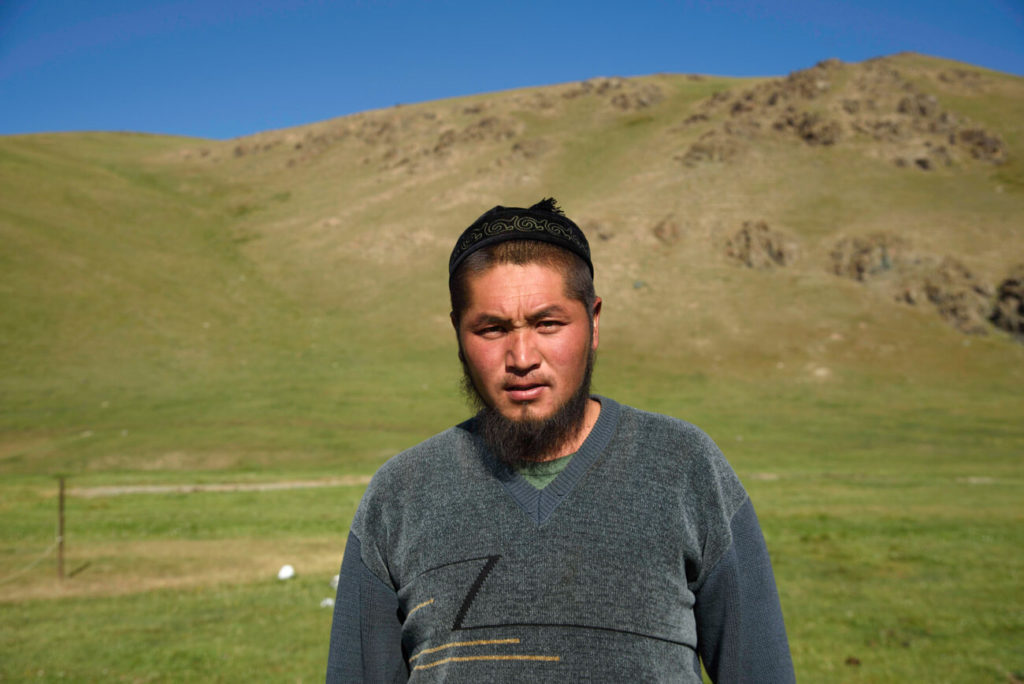
6 – Kyrgyz is the national language but Russian is widely spoken – Kyrgyz, a Turkic language, is the country’s official language.
Russian is spoken by most of the population, except in the south of the country, which has a significant Uzbek population who, for some reason, don’t really speak it.
7 – English is a problem – Communicating with people is one of the biggest issues in Kyrgyzstan, as very few people speak English.
8 – At least, you must learn the Cyrillic alphabet – Extremely useful, especially when it comes to reading restaurant menus and bus directions.
9 – Bishkek is surprisingly Westernized – When you arrive in Bishkek and discover all those restaurants and bars where local people hang out, who dress incredibly well, you realize that this is not what you were expecting.
10 – The rest of the country is more traditional – Outside of Bishkek, most people still live a traditional life, where people’s main life goal is getting married and having children as early as possible. I met several 20-year old women who already had two kids.
11 – Kidnapping brides is still a big deal – And what do I mean by kidnapping brides? In Kyrgyzstan, a man can take a random woman who is just walking on the street to his house and, if both parents agree, he can marry her and the woman can’t say anything.
I know, it’s not a real kidnapping but it’s a crazy tradition and, even today, some locals told me that this is practiced by 20% of the population, especially in small, rural villages.
If you want to know more about, check out this video:
12 – The most hospitable people in Central Asia – In this region, the Kyrgyz are famous for their hospitality. When we went trekking in the mountains, I remember that there was not a single day when someone didn’t invite us to his or her yurt to have some tea and bread with home-made jam and butter.
Traveling in Kyrgyzstan is very pleasant, as the Kyrgyz people, who will always bless you with their smiles, are kind and hospitable by nature.
13 – You can’t believe how clean they are – When you visit Kyrgyzstan , you will realize that these people have a real obsession with cleanliness.
Even in youth hostels, sometimes I could never go to the toilet because there was someone cleaning it. In guest houses and home-stays, women spend the entire day mopping the floor and cleaning the kitchen.
I don’t know whether it’s true or not but, a Russian man told me that, during Soviet times, Kyrgyz people had a bad reputation for being dirty. In order to change this general opinion, they became obsessed with cleanliness.
14 – Girls are pretty, very pretty – Kyrgyz women are stunning, especially in Bishkek. On the other hand, all foreign women say that, in general, Kyrgyz men are not very handsome.
15 – Always remove your shoes – You must always remove shoes when you enter any house, yurt and even hostels and guesthouses.
Read: 70 Tips for traveling to Pakistan

🐪 About nomadic life in Kyrgyzstan
The most accessible nomadic life in the world.
From time immemorial, the ethnic group known as the Kyrgyz have been a nomadic people who tend to move continuously throughout the mountains and valleys of the region with their cattle.
Today, a large proportion of the Kyrgyz population still live a nomadic, traditional life, not very different from their ancestors.
In summer, which is from June to September, you will find hundreds of nomad camps everywhere, either next to the road or in the remotest mountains, where they settle so their horses, cows and sheep can graze freely.
It’s their summer job
During the summer months, Kyrgyz nomads move from cities to the mountains, so their herds of cows, sheep, goats and horses can graze freely.
When the season is over, they sell some of these animals, as well as dairy products and meat. This is the only source of income most of them rely on.
They live in yurts
Yurts are perhaps the most iconic symbol of Kyrgyzstan. These cozy skin-made tents, which can be seen all across the country, can be incredibly warm during the freezing nights.

You can always stay with them, no matter where you go
Whether you just want to get a warm meal or spend the night, wherever you go trekking, the nomads will always welcome you, at least in my experience.
But remember that, even if they don’t ask, they may expect you to pay something.
Get off the beaten track because the touristic areas are too commercialized
If you go to popular places, such as Song Kul for example, most nomad families have spare yurts, which have been built for tourists.
Whereas there is nothing wrong with staying there, the experience won’t be very authentic.
If you have a chance, try to find yurts around the Alay Valley, the Pamirs or even in less popular treks around Karakol . In these yurt camps, you may sleep in the same yurt as the family and even join in with their daily tasks.
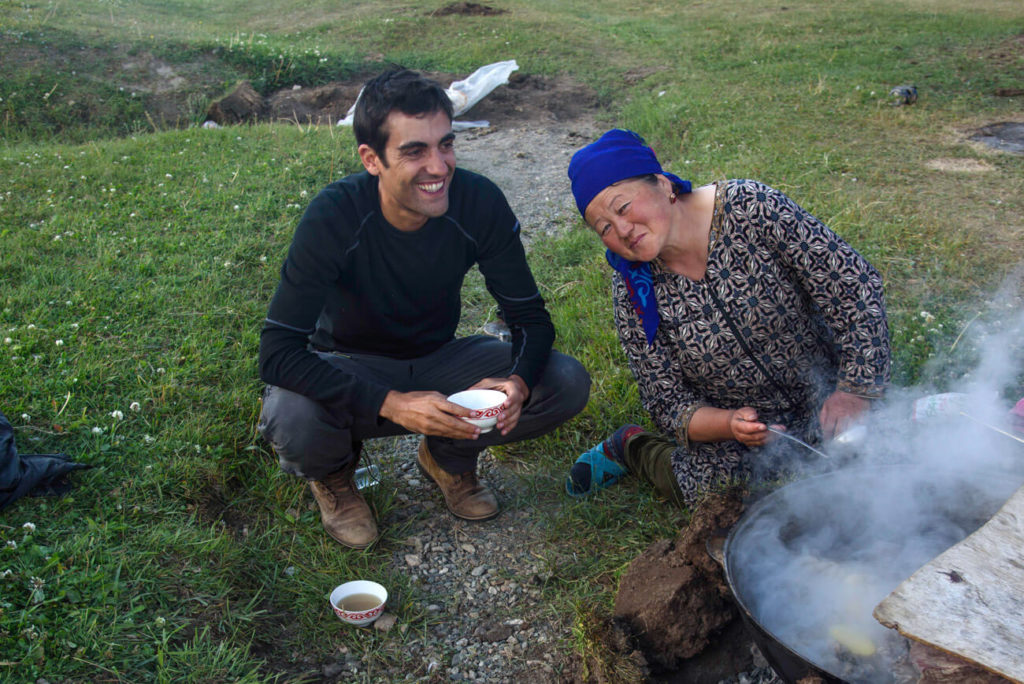
🍲 Facts about food and alcohol in Kyrgyzstan
1 – Food is not amazing but it’s OK to fill your stomach – You will not love it but, after traveling in Kyrgyzstan for 2 months, I was not especially bored of it.
2 – The typical food – Lagman (a hearty noodle soup), manty (meat dumplings) and shorpo (meat broth) are the staple food.
3 – But don’t trust mantys – While traveling in Kyrgyzstan, the only day I got slightly sick was after eating some street mantys . Be careful where you order them, as the meat they are filled with may have been outside of the fridge for days.
4 – In small towns and villages, only staple food – In bigger towns, you can easily find more choices, like salads, kebab or Western food. However, in villages, you’ll have to fill your stomach with lagman and mantys.
5 – You are expected to know what to order from the moment you enter the restaurant – It’s your first day in Kyrgyzstan, the first time you enter a restaurant, holding a menu written in an alphabet which you’ve never seen before.
However, they will expect you to know what to order within 10 seconds of giving you the menu. If you tell them to wait for 5 or 10 minutes, they won’t really understand you and will stand next to you. It’s very weird but you’ll get used to it.
6 – If you are vegetarian, you are fucked – It’s said that Kyrgyzstan is the country with the highest consumption of meat per capita in the world.
At most restaurants, it’s extremely difficult to find vegetarian dishes and, when you ask for something vegetarian, they kind of freak out.
Even sometimes, when I ordered a salad, it came with pieces of cooked beef in it. True story.
7 – Even chicken is difficult to find – If you find chicken on a menu, just order it!
8 – Beer and vodka are available everywhere – Welcome to the ex-Soviet republic of Kyrgyzstan! Despite being a Muslim country, alcohol consumption is present everywhere, even in small villages and towns.
9 – Get used to people being completely smashed at 9am – You’ll definitely meet Kyrgyz men who are massively wasted, who can barely walk, quite early in the morning.
10 – You must try kymys – If you go to the mountains and stay with nomads, ask for kymys , which is fermented milk. Most people don’t like it, as it has a weirdly sour, strong taste.
It has some small percentage of alcohol. However, if you don’t like it the first time, give it another chance. I tasted it in four different places and in two of them it was surprisingly good.
11 – Kyryt is the snack in fashion – Kyryt are some sort of cheese and yogurt balls which are available all across Central Asia but Kyrgyzstan is where they are most prevalent.
Again, some people don’t like them but, like kymys , some of them were good, some of them weren’t.
12 – A fruit paradise – If you come during the season, markets are filled with all kinds of fruits, incredibly tasty and ridiculously cheap. In summer, you will find plenty of nectarines, watermelon, strawberries, raspberries and much, much more!
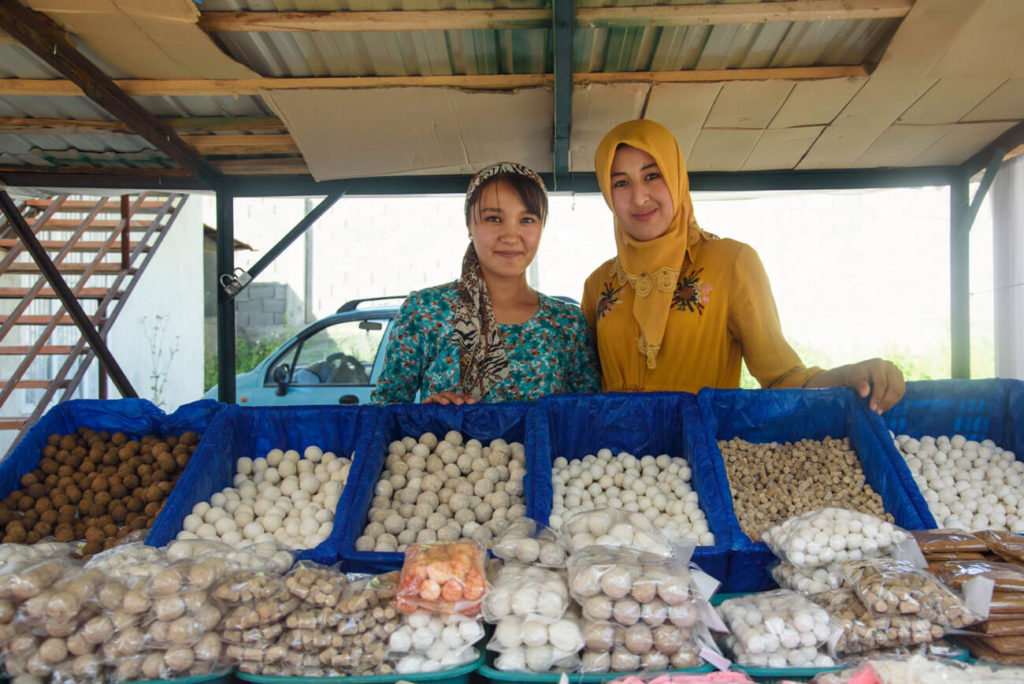
🐴 Horses in Kyrgyzstan
It’s the land of horses.
Horses are as much part of their culture as the yurts. From epic horse treks over 4,000-meter mountain passes to herds of tens of horses grazing in stunning meadows, if you like horses, you are going to love Kyrgyzstan.
They learn how to ride a horse at the same time as walking
When you are in the mountains, you will see plenty of kids (including little girls) riding big horses.
You must go horse trekking
Trekking over high mountain passes, riding one of those beautiful beasts is one of the highlights of Kyrgyzstan.
Ah, in case you are wondering, no, you don’t need any previous riding experience. A guide will always come with you.
But be careful!
Horses are no joke. They are dangerous so don’t try to gallop if you don’t have any experience.
I actually had a pretty bad accident, felling off a horse in Tash Rabat when I tried to gallop (I am a stupid, inexperienced man). I had to stay in bed for two weeks and fully recovered after one month. I could have been much, much worse, so be careful.
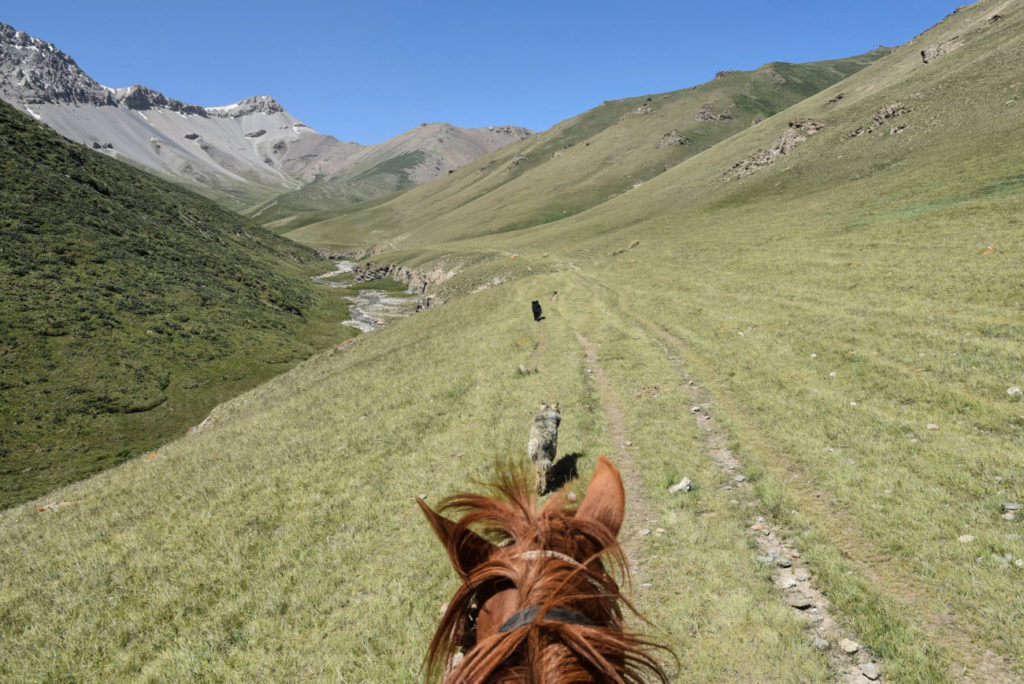
Hiring a horse is cheap
It costs around 700KGS ($10) a day plus 1,000KGS ($15) for the guide, which can be split between several people. If they try to charge you more, they are ripping you off.
But be aware that they eat them!
When you see a herd of horses grazing over a dreamy meadow, don’t get too much in love with them because many of them will end up in a butchery!
Horse games
Horses are so rooted in their culture that they are also main protagonists in their national sports. Among many others, Ulak Tsrtysh is the most popular game, which is a form of polo where they play with a dead goat which is beheaded right before the game begins. Violence in any match is more than guaranteed.
For more information on horses, read: Horse riding in Tash Rabat, Kyrgyzstan
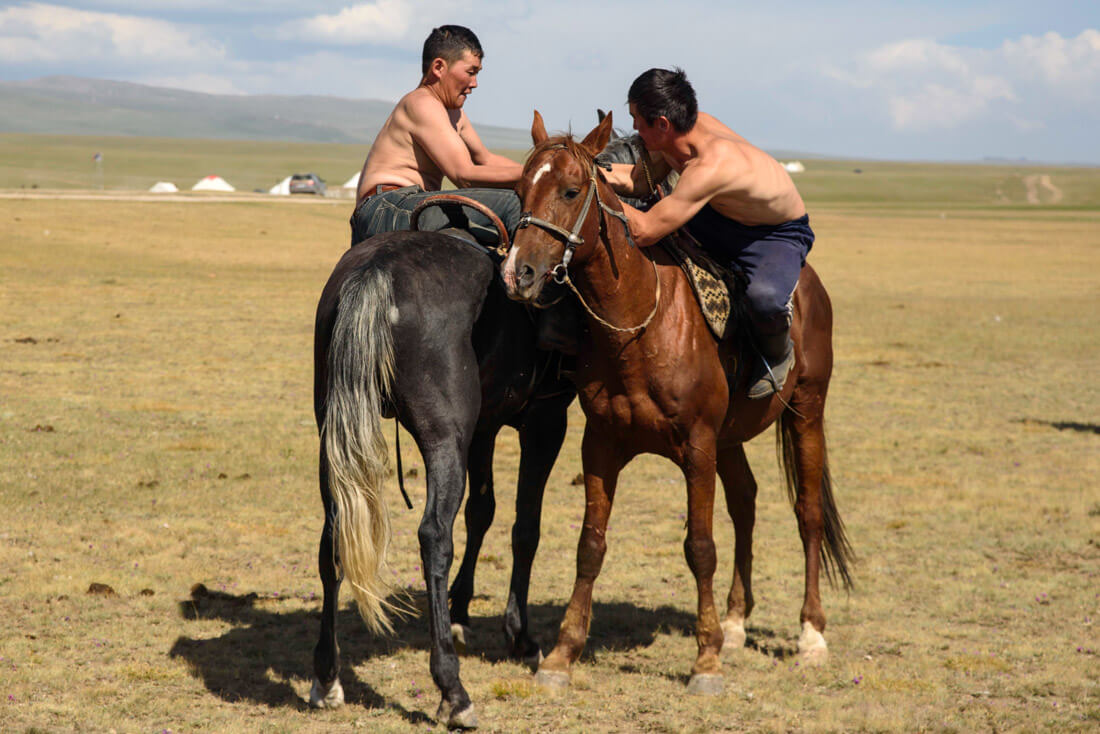
🏔️ Trekking in Kyrgyzstan
Around 90% of the of the country is above 1,500 meters and with that, I’ve told you everything already.
Kyrgyzstan is home to some of the finest world-class hikes. For decades, travelers with a slight sense of adventure, who wanted to savor some first-class hikes, used to go to Argentina, Switzerland, and Nepal. However, just a couple of years ago, the most intrepid travelers quickly realized that trekking in Kyrgyzstan could easily rival Patagonia and the Himalayas.
For more information, check:
Hiking in Kyrgyzstan, everything you need to know
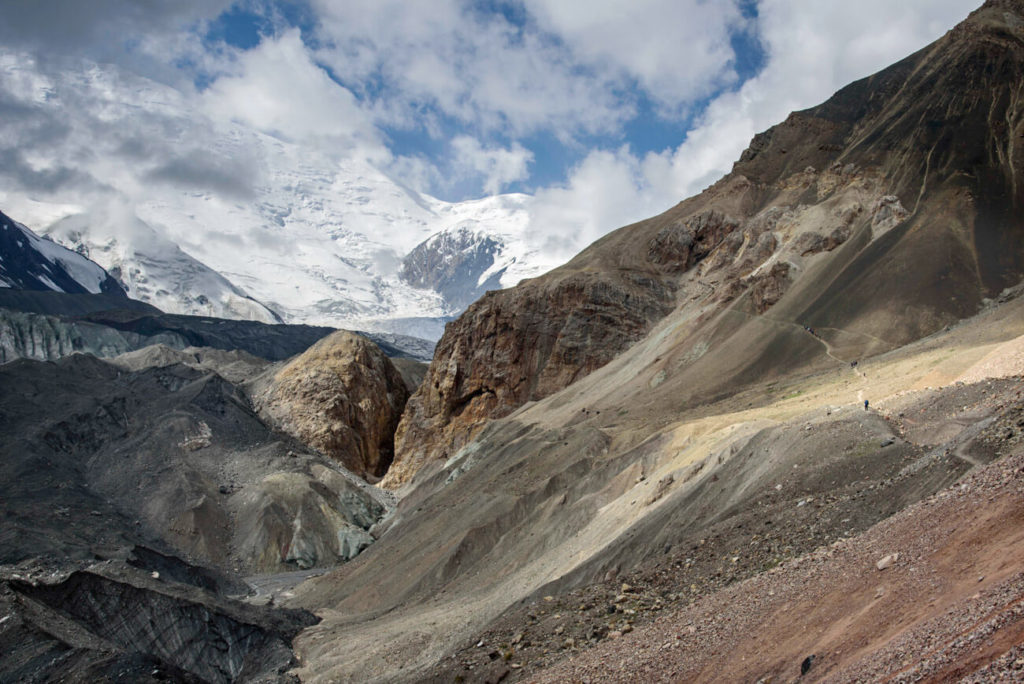
💻 Internet and connectivity in Kyrgyzstan
Esim for browsing, calling and traveling in kyrgyzstan.
Basically, an eSIM is a regular SIM card with a digital format that works like a normal physical SIM card, with the added benefit that you can buy it from home before the beginning of your trip, hence avoiding the hassle of buying it at your destination.
With Holafly , you can get a SIM Card for a wide range of destinations, including Kyrgyzstan .
Moreover, you can benefit from a 5% discount with the following code: AGAINSTTHECOMPASS
Kyrgyzstan has the best internet in Central Asia
High-speed Wi-Fi is available almost all across the country, even in high altitude towns such as Sary-Mogol and Sary-Tash, something I would have never expected.
About getting a SIM Card for traveling around Kyrgyzstan
If you get a local SIM-Card, 3G is also quite fast. Get a mobile company called O! For just a few dollars, they offer weekly deals for both internet data and calls. This mobile company has street stalls all over the country.
Get a VPN for traveling in Kyrgyzstan
You should always use a VPN when you travel, especially when you connect to public Wi-Fi networks.
Your connection will be much safer.
Moreover, you will be able to access content which is typically censored in Kyrgyzstan.
I recommend ExpressVPN – Extremely easy to use, fast and cheap.
If you want to learn more about VPN, check: Why you need a VPN for traveling .
💰 About money, budget and costs
In Kyrgyzstan, they use the Kyrgyz SOM and, approximately:
1 USD = 85 SOM
Kyrgyzstan is a very cheap country to travel, the cheapest country in Central Asia, and a budget backpacker’s dream. You can easily find home or yurt stays for 10USD a day, including dinner and breakfast. Meals cost around 1-2USD in local eateries and between 2-4USD in mid-range places.
Expect to pay 10-15% extra for service Except in cheap, local eateries, you will always pay an extra 10-15% for service when the bill comes.
Public transportation within cities costs 15c and buses between nearby towns, less than 1USD.
Budget backpackers can easily travel around Kyrgyzstan on 20USD a day .
ATMs are available everywhere and, in many of them, you can select the option that you want to cash out USD, instead of KGS. In my experience, the maximum I was able to get was 200USD at a time.
Exchanging money
I’ve never seen so many exchange offices, especially in Bishkek, where you find one in absolutely every corner.
Scams, getting ripped-off
I felt that nobody tried to rip me off – except for taxi drivers, of course, perhaps because mass tourism hasn’t arrived here (yet).
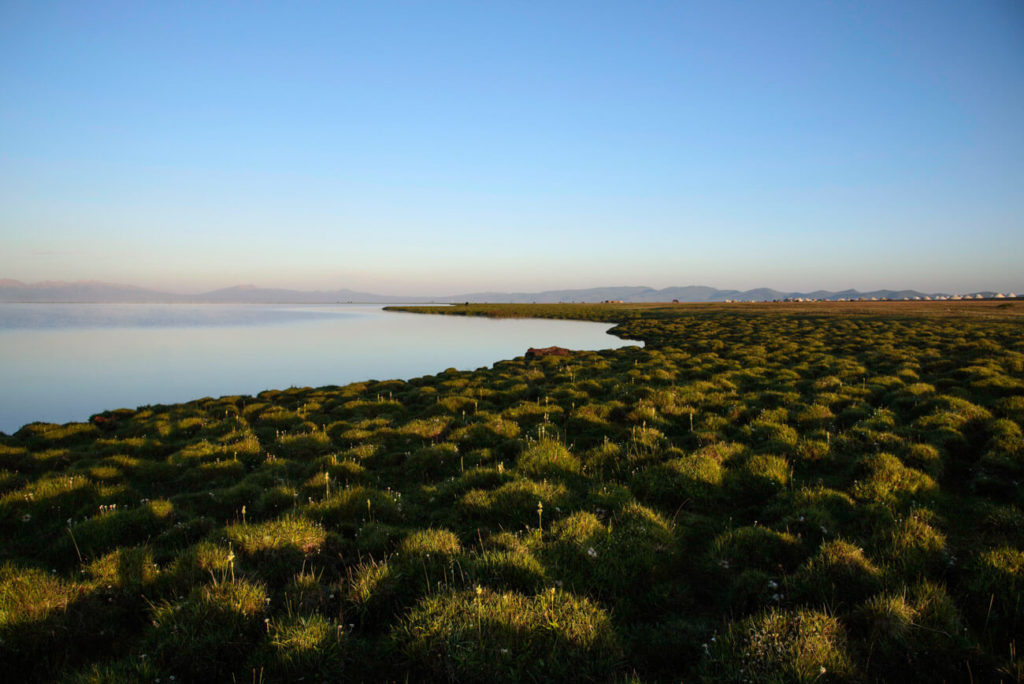
🏨 Accommodation: where to stay in Kyrgyzstan
Staying in a homestay in kyrgyzstan.
Everybody has a home stay. Kyrgyzstan has the peculiarity that, no matter where you go, locals offer their houses to foreigners for home stays.
Whether it is a remote village or a touristic destination, as soon as you arrive, women will approach you, asking if you want to stay at their house, and they are always superb: comfortable, clean and nicely decorated. You will not want to leave!
However, remember that they always expect you to pay, even if you are in a very remote village and you get randomly invited by someone to stay, even if they don’t ask you for money, they are expecting you to give something.
Price is always per person, not per room so, if you travel alone, Kyrgyzstan can be great
There are homestays all over the country, and you can easily find and book them online.
Staying in a yurt in Kyrgyzstan
A yurt is a round tent typically used by nomads in Central Asia and Mongolia, which is usually covered with animal skins.
In the mountains of Kyrgyzstan, if there are nomads, there will be also yurts, since that’s what they use for shelter.
They are incredibly warm and cozy and staying in one is a must-try experience for anyone traveling in Kyrgyzstan.
Staying in a hotel in Kyrgyzstan
In Bishkek, Osh and pretty much any larger city, you can also find regular hotels.

🛺 How to move around Kyrgyzstan – Transportation
Traveling around kyrgyzstan by public transportation, mashrutka is the way to go.
Mashrutkas are some kind of vans and mini-vans that connect all cities and towns in Kyrgyzstan.
They are extremely cheap and it’s very easy to move around with them, as you can find a station (or more) at every bazaar in absolutely every town. You just need to get on at the station and say which city or town you want to go.
Shared local taxis
Late in the evening, for long distances or in very remote towns, marshrutkas don’t run that often, so you will have to take a local shared taxi.
They are more expensive but, definitely, faster than marshrutkas . However, some drivers are completely nuts and may drive at over 120km per hour along narrow mountain roads.
A few things to keep in mind:
Remember that old women have the power – In any bus, marshrutka or taxi you go, women can choose any seat they want, even if you arrived one hour before them. In city buses, always give up your seat to any women over 40-50 years old. If you don’t, they will tell you to stand up. When I fell off the horse and had to stay in bed for 2 weeks, I was sitting in a marshrutka on the way to the hospital. I could barely stand up and, when a woman entered and told me to move and I couldn’t explain why I couldn’t, I created a lot of trouble until she understood.
At 40ºC, windows are still closed – Kyrgyz are afraid of air currents and no matter what time of the year it is, even if it’s the peak of the summer and 40ºC outside, they like to travel with the windows closed and the AC switched off. Sometimes, you can negotiate with the men but, if there are old ladies, forget about it.
Remember to be patient – Ninety percent of Kyrgyzstan is composed of high mountains which means that, every time you want to go from town to town, you will have to cross them, making your journey particularly slow. In addition, in some more remote destinations, shared taxis and marshrutkas leave once they are full and, sometimes, it takes some time to fill them. Just keep in mind that traveling in Kyrgyzstan can be particularly slow.
Hitchhiking in Kyrgyzstan
Hitchhiking is extremely easy and common among the locals. However, remember that, in Kyrgyzstan, everybody is a taxi driver so if you are looking for a free ride, you will need an extra dose of patience.
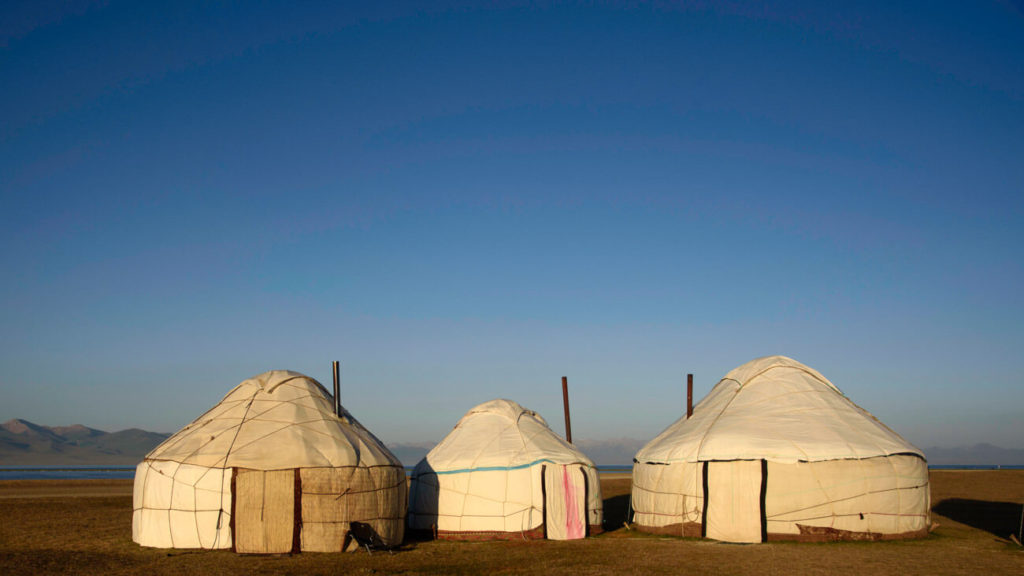
❗ More information for traveling in Kyrgyzstan
📢 In my Travel Resources Page you can find the list of all the sites and services I use to book hotels, tours, travel insurance and more.
What is CBT?
CBT (Community Based Tourism) is a very popular tour agency in Kyrgyzstan that can arrange any kind of activity you want to, from yurt stays to trekking, taxis, permits and anything you can think of.
CBT has offices all over the country and it is so popular because, despite being a tour agency, they offer very cheap and competitive prices.
However, bear in mind that, of course, it will always be cheaper to arrange things on your own.
Check the best books about Central Asia and the Silk Road
All guides and articles for traveling in Kyrgyzstan destination
- Kyrgyzstan Itinerary
- Horse riding in Tash Rabat
- Trekking in Kyrgyzstan
- Trekking the Ala-Kul
- Trekking in Karakol
- China-Kyrgyzstan border crossing
- Kyrgyzstan-Tajikistan border crossing
- Reasons to Visit Kyrgyzstan
Travel guides to other countries in Central Asia
- Tajikistan Travel Guide
- Travel Guide to Uzbekistan
- Travel Guide to Kazakhstan
- Pakistan Travel Guide
- Afghanistan Travel Guide
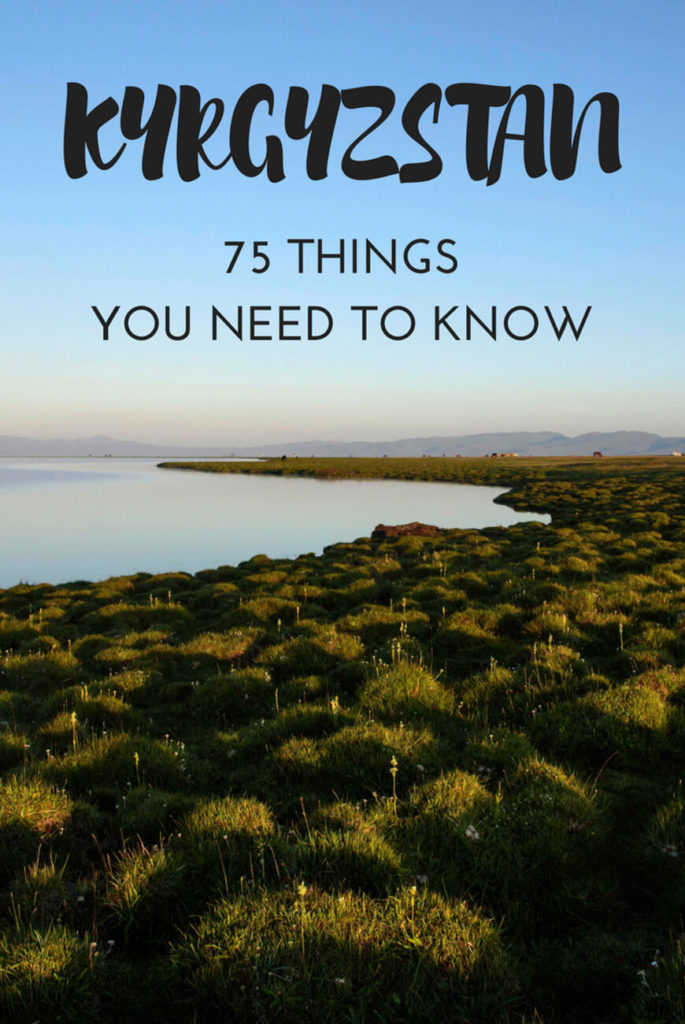
43 comments
I wouldn’t say that’s all you need to know, but it’s a nice start 🙂
Do come back, you ain’t seen nuttin’ yet!
Hi Caravanistan, nice to meet you online 😉 It’s not all but writing more than 3,500 words would be too abusive 😉 More articles coming soon. Cheers!
Very informative blog, thanks! I’m looking at travelling to Kyrgystan on my bike (the northern half of the country, around Naryn, and wonder how much rain I should expect. The climate charts indicate it’s pretty dry, but most blogs mentions seemingly frequent downpours and rain. Would you say that rain is a serious downside there in July-August?
Hi Christian, July & August is mostly dry, but it can rain of course, especially in high altitudes
From past few posts of your’s i had an imaginary tour of this beautiful country. You have shared very nice things about this country.
You should definitely pay a visit! Cheers.
Thank you for providing such a wonderful list of a new website as I hardly needed them.Thank you so much once again. Keep it up.
Nice article! I never knew much about this country until I read your post. Now I really am curious about exploring this place. Thanks for sharing!!
You totally should put it on your next summer travel list 😉 Thanks!
Looks that all the things that I have heard about this country all are rumors. It looks that this city is very peaceful and beautiful. I will definitely visit this country.
I hope it’s true 😉 You’ll enjoy it!
Excellent article Joan. I appreciate the details you put in there. Few points like you are expected to know what to order from the menu and closed windows at 40ºC left me in splits 🙂 🙂
Thanks! Yeah, these a few curiosities which are important know 🙂 !
This was incredibly useful! Kyrgyzstan has been on my places to go and I will totally refer back to this when I plan to make that trip. Thanks for sharing!
I really hope you go and glad you found it useful 😉
hello is it possible to travel to Kazakhstan from Kyrgyzstan should i need to get transit visa or without visa i can travel ?
Hello, it may be possible but it depends on your nationality.
Completely true. Except #21. That russian man obviously exagarrated on his words saying “long back kyrgyz was dirty” (as if he existed long back). The thing is in kyrgyz culture, women take a main role in house keeping, caring of kids, while men as a main provider. Thats why from the early age mothers guide daughters to be independent and know how to cook, clean, and be a support for parents and her future husband. BTW #71 – as for the simcard, its freely distributed at the exit of the airport (beeline, o, megacom) with few free load inside. Tho u have to approach service senter within a few days along with your original passport and get it registered to continue the service. I advised you to avail megacom it has a fast and cheap internet data (20Gb per month – 3.6$, 50Gb – 5.8$, 100Gb – 8.7$, with free call and sms within a network). Its much better if your phone suports 4G. Thats it 🙂 For any inquires kindly contact my WhatsApp#: +996 700 800 900
Hello! Thank you for your feedback, very much appreciated 🙂 ! As per your first comment, I don’t really know what are the exact reasons, as I am just putting into a few words what some people told me! However, in any case, what you are describing (claiming that women take care of the household) is very generic and happens to almost every culture and country in the world, so it doesn’t really explain why Kyrgyz are so obsessed with cleaning. As per your second comment, I will update my post accordingly as soon as I can!
Thank you for this amazing article. Agree with everything,. If you need any guidance in Kyrgyzstan, I can help you
Tell me how are high crime rate in kyrgyz and how hight rare of safftey??
Hello AIgerim, I am planning a trip from US to either Almat (cheaper & still close to Bishkek) Looking for someone to guide through Nature. trekking, hiking, hot springs, polar plunge, experience falcon hunting, Yurt sleeping with authentic Nomads. On a budget, Waiting for a flight price drop in Aug. So no set time yet , But Aug-Sept.
This was a great read! I definitely want to visit this country! Thanks x
Hi! I am from Bishkek, Kyrgyzstan and I absolutely love the way you descibed our reality! You definetly noticed unique features of kyrgyzstani life. Shared your post on Facebook, hope you’ll get more view and we’ll get more tourists 😀 Thank you! BTW, there are several really good ski resorts (the best one in Karakol) in Kyrgyzstan, so turists are more than welcome in winter season!
Thanks for for sharing it, really 🙂 and it’s my pleasure to say nice things about Kyrgyzstan. It is actually one of my most favorite countries. Yes, I had heard about the ski resort and heard it’s great!
I had not had Kyrgyzstan on my radar at all, until reading this blog from you! I love to travel and I love to hike, so now you have me excited to give Kyrgyzstan a try this summer. However, I have reached out to each of the three companies that you recommend for guide services, as I am only English-speaking, so I will need a guide to help me navigate the trails and communicate with the locals.
I live in the US, so am trying to communicate with these companies by email, but it’s been over a week, and no reply from them. Do you recommend my going to Bishkek in June and trying to find an English-speaking guide then? Or is that not realistic? I’m a very experienced traveler and hiker, but as a woman, I am also cautious because I travel alone.
I appreciate your advice. Thank you! And thank you for the inspiration to travel to Kyrgyzstan. 🙂
Hey Lyenne! It is actually better if you go to their offices once you are in Bishkek, or even at the destination in particular, like in Karakol. You will definitely find guides and, most importantly, it will be cheaper
Hello Thank you for your detailed information, it looks amazing Last year also I and my boyfriend we visited all this places, it was taken 20 days. Before coming to Kyrgyzstan we contacted with local companies and got all informations. Decided to do it by ourselves. When we land to Bishkek airport it was difficult to communicate with people, because people’s are dont speak English or French. And in Bishkek we changed our plan booked tour for 19 days. Because our friends recommended. Everything was great. Our guide was professional and speaks English very well.
In Kyrgyzstan some places no internet connection where is big mountains. And you need to take warm clothes, during the summer we see some snow 🙂
Hey Joan 🙂 , I’m so glad to have come across your page. Its so exciting and deeply informative. The descriptions are stunning and have given me a Stronger YES to go to Kyrgyzstan already!
I would like to know your advice on the below, -How many number of days (minimum) would you recommend to see around Kyrgyzstan? (Song Kul, Issyk Kul, Ala Kul, Ak-suu, all these gems and horse-treks in my mind) -What time of the year would be ideal to do the visit? -What are the “you can’t afford to miss” things to do and or places to visit in Kyrgyzstan? -Is it safe to travel as a couple or groups traveling is better for safety? Looking forward to your responses; to plan our trip.
Thanks in advance 😀
Hey Fatima, thanks for your comment, here are my responses: – I think you’d need minimum 2 weeks to visit these places – June to September is best and when the weather in the mountains is warmer – Besides the places you mentioned, I loved Alay Vallay and Tash Rabat – Kyrgyzstan is safe for anyone 🙂
I like your style of writing – informative, honest with a sense of humour. I have a plan to visit just one country for a week in Central Asia in 2020. While googling and reading up, I came across your blog and find it has all the info I need in my deciding process. So, the idea I have now is if I’d like to experience a nomadic mountaineous life, go with Kyrgyzstan and if I’d like to explore bazaars and ancient towns/architectures, go with Uzbekistan.
yes, that’s right 🙂 thanks,
Absolutely wonderful descriptions. Very insightful and helpful, especially considering that you made it a point to inform your readers about certain subtler aspects of Kyrgyz culture that would otherwise surprise people when they visit, not knowing what to expect. Reading about all your travels and adventures here has only made me think strongly about visiting Kyrgyzstan this year 🙂
Keep up the good work, and all the best with your other travels and writing as well!
Thank you so much for your kind words, Cyd!
Hi Joan, thank you so much for your interesting and inspiring info on Kyrghystan! Based on that we would like to go there for a 10 days trip first half of September, after a 10 days trip in Uzbekistan. as we only have 10 days, we would like to do it by car with a driver in order not to loose too much time: do you have any suggestions or drivers we can contact?
Hi there, sorry but unfortunately, I don’t personally know of any guide/driver!
I loved Bishkek. I didn’t go to trek just to visit and fell in love with the city, culture, and how inexpensive it was! The clubs are fun, karaoke was incredible, food excellent, and very easy to get around via taxi. The hotel I stayed at was 5 star quality under $40USD a day and the food there was some of the best I had in the country. I went to the mountains as well and saw amazing scenery. Snow on the mountains, wild horses, and wildlife. I was shocked at how western Bishkek was. I honestly felt like I was in an Asian neighborhood in the middle of Los Angeles. The people were extremely friendly, the woman are beautiful, but there is some things as a westerner you have to get used to. Lots of pushing and shoving when its crowded seemed pretty normal and if you are shopping be aware of counterfeit items. Other than that the country was beyond what I expected and I will be back soon!!! Issyk Kul is the next destination for me next time I am there and I would love to visit Osh. My entire 3 week journey including plane ticket, food, going out, and my incredible hotel was less than $2000. Its the biggest hidden secret in the world right now.
Thanks for the article. I have lived in Kyrgyzstan for many years. Mountains, Bishkek, Issyk-Kul. It’s very beautiful there. The people are hospitable.
Is it possible to get visa on arrival? or need to apply thru online (e-visa) before coming to Kyrgyzstan?
what’s your nationality?
Hi I enjoyed your article about Kyrgystan. Most likely we will be going and hopefully this summer! That’s why I searched for the info online. So…. I’m a vegetarian. I was told to take a jar of jam with me but I don’t think this will cut it 😉 We are planning to hike and spend as little time in a city as possible. How f****d i quote :))) do you think I am?
We don’t want to carry our bags all day, we prefer them to be dropped off to the next location. Or maybe we can afford a porter for a day or two. My partner had a shoulder op. So he is still bit vulnerable. I also read that you recommend to book hikes when we get there.
Can you recommend any local tour companies? When I try the online places you mentioned prices are high.
Is it best to fly to Bishkek or other cities have better hikes in the area?
We don’t want to get to high up, I don’t like cold or be in snow.
We would do probably 2-3 weeks.
Can you please recommend me best trails and places, and give me advice on planning? Thanks Kat
Hello, sorry for late answer. Vegetarians may have a hard time, since even the local shorpo (soup) is meat based… Cheese, bread, nuts, jam, fruits… That’s the type of food you find in the mountains. You can also find instant noodles in shops.
I don’t know any specific tour company, but you can easily arrange or find many in specific villages and towns in Kyrgyzstan.
For trails and places, you can check following guides: https://againstthecompass.com/en/trekking-in-kyrgyzstan/ https://againstthecompass.com/en/backpacking-kyrgyzstan/
Leave a Comment Cancel reply
Your email address will not be published. Required fields are marked *
Notify me when new comments are added.
Join our Expeditions
From Syria to Iraq in Pakistan, Against the Compass is finally running expeditions to the most epic and off-the-beaten-track countries.
We have scheduled expeditions for every month of the year.
Latest posts
- How to visit Angel Falls and Canaima National Park
- Things to do in Haiti in a 1-week itinerary
- Is Syria safe to visit in 2024?
- How to travel to Syria in 2024: Need to know
- Is Iraq safe to visit in 2024?
Kyrgyz’ what?! A complete travel guide for Kyrgyzstan.
- By Sarah Steiner
- Updated On March 30, 2024
Making plans for travel to Kyrgyzstan doesn’t register on every travellers bucket list…
But why not?
After visiting Mongolia we were certain; the nomadic herder culture is one of our favourites in the world! The horsie-ness and vastness nomadic herder culture entails, suits us and our style of travel. It’s wild. It’s remote. And it’s still very real.
The chance to visit Kyrgyzstan definitely meant stepping away from the mainstream. And we couldn’t wait to get there…
Travel to Kyrgyzstan
- About Kyrgyzstan
- Fear of the ‘Stans
- Best time to visit
Places to visit in Kyrgyzstan
Kyrgyz hospitality.
- Travel to Kyrgyzstan with kids
- Getting around
- Connectivity and wifi
Accommodation in Kyrgyzstan
Where we stayed.
- Read more about travel to Kyrgyzstan
About Kyrgyzstan, quickly
- Capital: Bishkek
- Land area: 199,951 km 2
- Population: 6,533,500
- Official language: Kyrgyz
- Co-official language: Russian
- Religion: 90% Islam, 7% Christianity, 3% other
- Drives on: Right
- Calling code: +996
- Time zone: Universal Coordinated Time ( UTC+06:00 )
- Outlets: Plug Type C, F (220 V / 50 Hz)
Kyrgyzstan is a mountainous, landlocked country. It is bordered to the north by Kazakhstan , Uzbekistan to the west and southwest, China to the east and Tajikistan to the southwest.

Fear of travel to the ‘Stans
Let’s be honest; first thoughts of the ‘- stan ‘ poses connotations that bring fear. History and media presents a certain image abroad, and for the seven countries in Asia that end with the suffix ‘Stan, our first reaction is not instinctively smooth.
But the word stan actually means land in the Persian language of Farsi; a word for “place of” or “country”. Moreover it’s a bit like the suffix of names in English titles such as Eng land , Scot land , Switzer land .
And rightly so. Central Asia is a region of diverse geography and land with a lot of fascinating history behind it. And I admit, we didn’t tell our family we were heading to Central Asia until we were actually there. Namely because we didn’t want to be put off when they freaked out on hearing the word ending with ‘Stan.
But don’t let it put you off. It’s ok for families to worry about us. That’s their prerogative and that’s ok.
Definitely don’t miss out of the land of travel and adventure in the ‘Stans. Travel to Kyrgyzstan is incredible.
Visas for Kyrgyzstan
The good news for travel to Kyrgyzstan is that it’s visa-free for a growing number of passports.
Passport holders from 69 different nations are not required to obtain a visa in advance for travel to Kyrgyzstan for travel up to the length of 30, 60 or 90 days. It is also possible for a lot of those nations to arrange a visa on arrival for an extended stay of up to 90 days.
If you aren’t one of the countries to qualify for visa-free entry, you can apply through an e-visa system or in person at a Kyrgyz embassy. You can apply via the E-visa government website .
- Tip: Always check for updated details of visas before you travel to Kyrgyzstan .
Best time to visit Kyrgyzstan
Unlike Uzbekistan just over the border, the usual tourist season for Kyrgyzstan travel is the high summer.
Summertime is also the holiday time for Kyrgyz nomads and therefore the time when summer pastures are full of yurts. Even semi-nomads who live life in the cities during the year go to the mountain summer pastures during the school holidays and warmest times of the year.
Aside from that, fruits and vegetables are ripe and the weather is as warm as it gets.
Yurt camps set up in summer pastures offer yurt stays from mid-May to mid-September (and trust me, it’s getting cold up in the Tien Shan mountains by early September). After their holidays the camps are slowly packed away and the families move back to the cities.
In the cities however, summertime is hot. Temperatures in Osh and Bishkek get up to over 40°C. This is due to the distance in the cities from any large bodies of water (remember, Kyrgyzstan is a landlocked country).
The largest lake is Issyk Kul, which becomes a popular summer beach destination in Kyrgyzstan. It is even (just) warm enough to swim here (whilst surrounded by surreal snowcapped mountains in the distance).

Kyrgyz language
In Kyrgyzstan, the Kyrgyz language is co-official with Russian. In the cities Russian is the predominant language (especially in Bishkek), but in the smaller towns and rural areas the main language used is Kyrgyz.
Kyrgyz is a Turkic language with a written alphabet using Cyrillic.
A few Kyrgyz basics
- Hello: Salamatsuzbu
- Hello (informal): Salam
- Thank you: Rahmat
- How much is it?: Kanchadan?
A lot of Kyrgyzstan travel will have you feeling like you are quite literally in the middle of nowhere.
For the days we weren’t in Bishkek, every day we ended up somewhere random and unheard of. The landscape challenged us. Not only because it is so different from our previous months of travel in East Asia , but because it is a challenging landscape in itself.
However, this is exactly why travel in Kyrgyzstan is so appealing.
Because out of the city, people are living in this landscape as they have done for generations…
In Kyrgyzstan, we spent time in:
- Chong-Kemin National Park
Song Kol Lake
Kyrgyzstan’s capital city has a population of around one million people.
However, as a culture Kyrgyzstan is known for its rich nomadic history. So it makes sense then that the urban areas of Kyrgyzstan don’t showcase the best of what the country has to offer.
Bishkek is no exception.
Picture huge tree-lined streets, boulevards and very Soviet style architecture. It’s easy to get lost in the serious bustle of Bishkek, and slightly tricky to find a local place to eat.
But like it or lump it, Bishkek most commonly serves as the gateway to the amazing outdoor activities and vistas of Kyrgyzstan.
Plus, as far as Kyrgyzstan travel, the country has the most liberal tourist visa regime in the area of Central Asia, so the chances are you’re going to visit. And it’s worth making the most of it…
Things to do in Bishkek
- Osh Bazaar: This is the biggest and most colourful market in Bishkek and a great place to start exploring the city from. You can find anything here: pastries, cooked food, dried fruit, vegetables, souvenirs and cheap Chinese knock offs.
- Panfilov Park: This is a very Soviet style amusement park that gets busy with locals. Part of the park is ticket-entry only, but there is also a spacious play area and free playground for kids.
- Ala Too Square: Another unmistakably Soviet style feature of Bishkek, this was built to celebrate the 60th anniversary of the Kyrgyz Soviet Republic. It’s marginally interesting to visit and another chance to soak in all the Soviet influence that is such a huge part of the city history.
- Eat: Bishkek isn’t honestly the most relaxing place to wander aimlessly, but if in doubt you can focus on finding a good place to eat. Beshbarmak is the Kyrgyz national dish; a soup and noodle bowl that is worth hunting out if you are there.

- Note: Osh Bazaar is notorious for pickpocketing. I haven’t any photos from inside the bazaar as didn’t take my camera or phone out on any visit.
We still can’t decide if Gavin had his small, reusable-cutlery bag snatched from his backpack or if we just lost it while staying in Bishkek. Keep your valuables safe.
That aside, we only had two days in Bishkek but it felt like enough.
We had jobs to do including finding an English-speaking witness to sign paperwork we needed to send home, and a post office to send them by mail. That kept us sufficiently busy in Bishkek and less touristy to be fair.
General vibes are of a busy city with sights to see if you are looking and have the time. And if you don’t, then get yourself out of there and on to the rest of Kyrgyzstan…
Chong Kemin National Park
Chong Kemin National Park covers 500 hectares of land in the north of Kyrgyzstan, in an area once known as Chong Kemin River Valley.
Setting out from Bishkek, Chong Kemin is often the first stop on a tour for a night in rural Kyrgyzstan. And most tours include a stop of the ancient Burana Tower on the way.
We found Chong Kemin to be a beautiful area. Landscape within the park starts from desert-like stretches of flat, vast land, winding up into the hills through coniferous forests, mountain-scapes and glacial fed rivers.
We stayed our first night out of the city at a guesthouse somewhere in the park. And even to this day we still don’t know exactly where we were.
Cellphone reception cuts out at the base of the park, before winding up into the hills past vast farms and herds and herds of horses. We stopped in a village to ask a passing horseman for directions, because even our driver hadn’t been there before.
Chong Kemin is blissfully off the beaten track alright.

Things to do in Chong Kemin
- Hiking in the National Park: Chong Kemin has a range of different hiking trails in the park. Or, like us, you can put on your hiking shoes and explore from the homestay.
- Horse riding: Our homestay in Chong Kemin was surrounded by horses. We went to sleep with the sound of horses in the paddock outside and woke up with one right at the window.
- Get adventurous, try something new: Our kids were in awe of the young boys practising with a homemade bow and arrow. If you aren’t in a hurry, take the time to try something different. I mean, how often do you get the chance to try archery in the mountains of Kyrgyzstan?
- Burana Tower: Not technically in Chong Kemin, but on the way. Burana Tower is large minaret in the Chuy Valley. The tower was built during the 11th century (though it has been partially restored) and claims fame as the earliest architectural wonder of Central Asia.

Experiencing nomadic herder life in Kyrgyzstan is one of our best travel experiences to date. Song Kol is an alpine lake in the Tien Shan mountains of Kyrgyzstan, just over 3000m above sea level.
Albeit cold, but stunning.
Song Kol Lake is one of the highlights of Kyrgyzstan travel.
Things to do at Song Kol
- Horse riding: Horses are the livelihood and heart of nomadic Kyrgyz herder culture. You can ride along the shore line or trek up into the surrounding foothills of Song Kol.
- Stay in a yurt: There is nothing quite like the smell of a yurt fire burning from the warmth of your yurt home for the night. Waking up in the hills of Kyrgyzstan is a dreamlike tick for the bucket list.
- Hiking: Song Kol is beautiful and peaceful. There are plenty of options to enjoy short or long hikes.
- Help out: Learn to make curd and cream from fresh milk, and help collect water for the camp on donkeys.
- Try kymyz: This is the Kyrgyz national beverage of fermented horse milk.
It is strong and sour to taste, and mildly alcoholic but it’s deemed to be healthy and good for digestion. Perhaps healthier than vodka and cognac at least (which also seems to be a popular beverage with Kyrgyz people here!).

- Read all about our stay at Song Kol Lake with a nomadic family here .
Issyk Kul Region
Issyk Kul is an ancient lake in Kyrgyzstan, estimated to be 25 millions years old and the second largest alpine lake on the planet. (Pretty cool, right?).
The lake is surrounded by the snowcapped Tian Shan mountain range which is uncannily beautiful (and ironic, if you are arriving from anywhere desert-like in Central Asia).
Things to do in Issyk Kul Region
- Lake Issyk Kul: Want to go swimming in Kyrgyzstan?
No, seriously. If the weather is warm enough, the lake is Kyrgyzstan’s most popular summer ‘beach’ destination. (Don’t let the snow capped mountinas in the distance put you off too much!).

Karakol seems to have it all. It is a smallish town in eastern Kyrgyzstan. Most often it is known as a starting point for day hikes in the Tien Shan mountains and a base to see some of Kyrgyzstans most famous natural scenery.
It is in a unique location geographically, with China to the east and the rest of Central Asia to the west, in an area that was once part of Turkestan. Not only is there Chinese influence in the cuisine and culture of Karakol, but you can see the vestiges of Soviet influence again, in architecture, cuisine and culture.
Jeti Oguz and Fairytale Canyon are near to Karakol and can easily be done as day trips.
Things to do in Karakol
- Hiking: Karakol is considered the gateway to the Tien Shan mountain range, famous for beautiful alpine multi day hikes. There is also a range of short day walks (many in Jeti Oguz) without going to far from Karakol.
- Jeti Oguz: If you are in Kyrgyzstan with kids and/or not planning for long hikes, Jeti Oguz is a great choice for a day trip from Karakol. It is only 40 minutes drive from town.
- Seven Bulls : A striking rock formation. There are short walks along the river and up to a great lookout point.
- Dungan Mosque: The Dungan mosque was built between 1907and 1910 by a group of Chinese Muslims—known as Dungans.
The mosque is beautiful and eye-catching, with bright colours and patterns. But what is most interesting is that the wooden mosque is constructed entirely without the use of nails.
- Karakol Bazaar: Karakol Bazaar is interesting because due to its location, sellers originate from a range of Kyrgyz, Russian, Dungan, Uzbek, Uighur and Kalmak backgrounds.
Obviously, we have a thing for bazaars in Central Asia! But you can’t help but be drawn in by the bustle and energy of an Asian market. (Plus, the boys found extremely cheap knock-off Bakugan cards and thought it was the best bazaar ever. Not an authentic travel tip I know, but it’s worth sharing, just in case).
- Holy Trinity Russian Orthodox Cathedral: Another cultural sight of Karakol that differs again from the norm.
The first church in Karakol was built from stone in 1869 but was destroyed by an earthquake. The current cathedral is built out of wood on a brick base.

Food in Kyrgyzstan
Kyrgyz food is similar to it’s surrounding neighbours (Uzbekistan, Kazakhstan and Tajikistan).
In restaurants and roadside cafes, choices can often be simple and limited in variety.
And in summary, traditional Kyrgyz food is based around horse, mutton, and beef meat, as well as various dairy products. (And spoiler alert; Kyrgyzstan travel as far as food is concerned, is a different kind of adventure itself!). Meat is usually served on top of pasta or noodles, inside dumplings, or with potatoes.
There isn’t a lot more choice than that, but we didn’t find anything we really didn’t like. And meals are always served with a pot of hot tea.
Some of the most popular Kyrgyz foods include:
- Beshbarmak : Horse meat (or mutton) boiled in broth, served over soft homemade noodles.
- Chuchvara : Meat dumplings served in soup.
- Kuurdak: grilled mutton, fat and onions served on flat pasta noodles.
- Monti: meat, onion and fat filled steamed dumplings.
- Samsy: similar to a samosa, these are pockets of meat and onions.
Samsy is a great snack choice from a roadside stall or bakery-style cafe in the city. (aka: a staple food traveling in Kyrgyzstan with kids).
- Lagman: meat, vegetables and noodles served in a broth. (A cross between laksa and noodle soup?).
- Ashlam-fu : A spicy lunch dish made with cold noodles, vinegar, and eggs. This one didn’t grow on us but it is supposedly a refreshing cold lunch dish to eat in summer.
- Kurut : Small snack balls made of dried sheep’s cheese or fermented yogurt. Sounds worse than it is, and I was put off after eating them in Uzbekistan. But , kurut doesn’t taste too bad as a snack with a cold beer sitting in the sunshine outside a yurt…
- Shashlyk kebabs : Cubes of meat on skewers cooked over embers.
- Plov : Rice dish made with mixed boiled or fried meat, onions, carrots and garlic (similar to Indian pilau).
- Lepeshki: Kyrgyz bread served with almost every meal.

Food choices in Kyrgyzstan with kids
Kyrgyz cuisine doesn’t offer too much choice, which made it fairly easy to find food the kids were happy to eat. They even found some things they really enjoyed (a travel-win!).
Some Kyrgyz foods our kids enjoyed:
- Samsy: similar to a samosa, these are pockets of meat and onions. Samsy is a great snack choice from a roadside stall or bakery-style cafe in the city. (aka: a staple food traveling in Kyrgyzstan with kids).
- Bread (lepeshki): Round and flat breads are commonly served with most meals.

- Side note: a lot of the time the tables are laid with small bowls of treats and sweets included as part of the lunch spread. And the dinner spread. Even sometimes with breakfast. (Don’t worry about finding Kyrgyz food kids will eat!).
Kyrgyzstan travel with kids
When you think of telling people you are planning to visit Kyrgyzstan with kids, first responses are liikely the same. Where ? Albeit there isn’t a lot of information online about Kyrgyzstan travel with kids, so this response is somewhat justified. And we too felt a heightened parental nervousness prior to travel.
Arriving in Bishkek surrounded by the solemn Soviet style of city architecture doesn’t exactly scream welcome to Kyrgyzstan with kids …
But, the good news is that as soon as you head out of the city, travel with kids feels as it does anywhere else; like a new adventure.
Kyrgyzstan is a very welcoming country. We were humbled and welcomed by other families who were genuinely pleased to see us traveling in Kyrgyzstan with kids. We traveled around the rural areas with a driver, and felt safe in the country with kids.
The landscape of Kyrgyzstan is exciting and varied; perfect for children. Our kids loved the freedom of being outdoors.
At Chong-Kemin they easily made themselves at home making homemade bows and arrows with local kids.
In Song Kol they were in awe of the local boys riding horses and donkeys and jumped at any chance to spend time with them. And at Issyk-Kul they swam in the biggest of Kyrgyzstan’s lakes and watched kids practising training with an eagle.
Experiencing that kind of nomadic lifestyle in Kyrgyzstan with kids really is the most incredible opportunity for learning and adventure.
Hospitality in Kyrgyzstan is one of the best stories from our travels. Kyrgyz people are somewhat shy on meeting, but welcoming without question.
Don’t be concerned by the language barrier. We found that even without language we found we could understand and enjoy meeting locals and especially learning about the nomadic lifestyle of Kyrgyzstan.
It feels like a real honour to be welcomed into the homes of nomadic families, farmers, herders and Kyrgyz families.
And one of the best things about travel to Kyrgyzstan with kids is that Kyrgyz people love children. The boys were given sweets and biscuits everywhere we went. Families we met and stayed with welcomed them and genuinely seemed to be thrilled to have them play with their kids.
In Karakol, we spent four days in between Bokonbaevo and Kazakhstan, and met our drivers family. He ended up giving his boy a day off school especially to hang out with us. We couldn’t speak as little Russian and they spoke English, but we went out for dinner with the whole family and his wife even gave us all haircuts!
Hospitality in Kyrgyzstan is definitely an asset of Kyrgyz traditions.

Travel to Kyrgyzstan – Money
The local currency in Kyrgyzstan is called the som . It exists in bills and coins, with the largest denomination of note 5000 KGS (about $65 USD).
ATM’s are common in the cities and larger towns, but definitely carry cash with you to Song Kol as the nearest town is half a days drive away.
- Tip: At bigger hotels in Bishkek and other cities you might be able to pay by card, but at smaller guesthouses you will be expected to pay in cash.
Licensed money exchange booths (marked obmen valyot ) will exchange US dollars and other major currencies. In Karakol we found a money-changer next door to a bank to exchange Kyrgyz som for Kazakh tenge .
- Tip: It is always a good idea to carry US dollars on you for travel in Central Asia.
Bargaining is common in Kyrgyzstan. It’s definitely worth negotiating when buying souvenirs at the bazaar as prices are often initially inflated for tourists. (We learnt this the hard way trying to buy souvenirs at Osh Bazaar).
Travel to Kyrgyzstan – Budget
Heres the catch. In theory, backpacking or travel to Kyrgyzstan on a budget is doable. Quite doable in fact. However, in our case we were travelling Kyrgyzstan with kids and we didn’t quite know what to expect.
We booked ahead to confirm a tour with a CBT office and this isn’t cheap. But it made it easy, and accommodation, meals and transport were included in the price for the days we were on the tour.
As a guide for budget travel to Kyrgyzstan , here are some of the costs we found:
- Samsy/streetfood snack: 50 som
- Bottle of water: 40 som
- Domestic beer: 150 som
- Entry to Burana Tower: 150 som per adult
- Roadside cafe lunch meal: 100-150 som
- Restaurant meal in Karakol: 600-1200 som
- Hotel in Bishkek: US $50-70
Communications: Phone and wifi
Kyrgyzstan has two main telecommunications operators; Megacom and Beeline. Mobile internet is not expensive with either provider, and tourist/short-stay packages are available.
Wifi is available in accommodation in the city, and we found good wifi in Karakol as well. 3G is available in the larger towns, although very spotty driving between sights along the south side of Issyk Kul. Roaming on an international sim should work in Kyrgyzstan as well.
Kyrgyzstan has a wide range of accommodation options. Looking online for hostels in Bishkek, you will find everything from budget range dorm-style hostels to top end hotels. We stayed in a total of five different yurtstays/homestays and guesthouses during our time in Kyrgyzstan. I booked the accommodation in Bishkek and Karakol online through booking.com. The yurt stays and homestay in Chong-Kemin were booked for us by Kyrgyz Tourism , based in Bishkek.
Staying in a yurt stay means basic accommodation, but the best thing about any homestay in Kyrgyzstan is that is likely includes breakfast and sometimes even dinner.

- Bishkek: Hotel Koisha
- Chong-Kemin/Boo Jeptes Area: Homestay
- Song-Kol Lake: Yurtstay
- Bokonbaevo: Yurtstay
- Karakol: Jamilya Eje’s Guesthouse
Hotel Koisha in Bishkek is a great place to start. The family room has two seperate rooms and a private bathroom. And you wouldn’t guess it from the outside, but the hotel has a huge courtyard, kitchen, outdoor kitchen and BBQ area, and indoor/outdoor common space.
The hotel is only 100m from Osh Bazaar, and affordable at US $38 per night for a family room. I would recommend Hotel Koisha as a good choice for arrival in Bishkek. It made day one for us in Kyrgyzstan with kids feel safe and smooth.
In Karakol, Jamilya Eje’s Guesthouse was a great find. We stayed four nights, relaxing in between our Kyrgyzstan tour and starting our next leg over the border to Kazakhstan . The quadruple room is a decent size with a double bed and two single beds. Cost: US $55 per night. Dinner is available in the restaurant room most nights. Breakfast is included. The guesthouse is in walking distance of playgrounds in Karakol and the main Karakol Bazaar.
Getting around Kyrgyzstan
The main ways to travel within Kyrgyzstan are by private taxi, marshrutkas (shared taxi van) or bus.
In Bishkek and Karakol we used taxis to get around. Taxis are cheap and it is easy for your hostel or hotel to call and book a taxi if you need to go somewhere. On the street you can wave down a registered taxi vehicle and negotiate a fixed price for a ride.
Marshrutkas are a a form of shared taxi, most commonly a minivan and are the most common form of transport. They act as buses, departing from central stations in the larger towns and cities and bus stops in rural areas. Some are scheduled but most line up and wait until they are full before departing.
- Tip: In a smaller marshrutkas is you pay for all four seats it will essentially act a private taxi).
We booked a driver for our time in Kyrgyzstan through Kyrgyz Tourism , based in Bishkek.
- Tip: I recommend you email Aisha at Kyrgyz Tourism who is amazing to deal with.
She answered all of my questions and was fantastic in understanding and adapting a tour that would suit us to get around Kyrgyzstan with the kids.

One challenge in our travels to Kyrgyzstan
High altitude temperatures at Song-Kol lake mean it gets COLD! Early September is technically summer, but it hits zero degrees at night time.
Arriving in Kyrgyzstan having traveled for months prior in South East and East Asia, we were traveling light and had only been in temperate climates. (Not to mention arriving directly to Kyrgyzstan travel after the past few weeks sweltering in the Karakalpakstan desert and taking an overnight train across the desert in Uzbekistan !).
We knew Song-Kol Lake would take us to the highest point of our travels for the year and in truth we were fine. The kids had long pants and layered up with singlets, long sleeves, jumpers, and light jackets.
Our host Mum at our yurt camp even came in during the night to re-stock our yurt fire with cow poo. BUT , we could have been better prepared.
Our driver lent me a warm jumper to wear under my light jacket, and I have to be honest – I was so appreciative!
If we went again…
Now with hindsight, if we went again we would head to the op-shop in Bishkek to stock up with warm clothes BEFORE hitting sub-zero temperatures at Song-Kol lake.
There are plenty of op-shops in Kyrgyzstan (they get knock-offs and near-new labelled clothing directly from South Korea ), but we didn’t think of that before heading out of the city.
Stock up with jackets or jumpers first!

Useful links for travel to Kyrgyzstan and beyond…
These are the companies we use while traveling fulltime as a family and that we would recommend to anyone planning and booking travel.
- Booking.com – The best all-around accommodation booking site that constantly provides the cheapest and lowest rates. They have the widest selection of budget accommodation. And it’s easy to filter and sort into price and availability with all the extras you are looking for personally. (We love their flexible cancellation policy!).
- Skyscanner – This is by far our favourite flight search engine. They are able to search small websites and budget airlines that larger search sites often miss. We book all our flights through Skyscanner!
- GetYourGuide – Get Your Guide is a huge online marketplace for tours and excursions offered all around the world. It includes everything from walking tours, to street-food tours, cooking classes, desert safari’s and more!
- SafetyWing – A global travel insurance that covers people from all over the world while outside their home country. You can buy it short or longterm; and even if you are out of the country.
- World Nomads – Travel insurance tailored for longterm travel and nomads (including those who have already left home). Make sure you have insurance for your Kyrgyzstan travel and adventures!
Read more about traveling in Central Asia
- What makes Silk Road flatbreads so fabled?
- Uzbekistan: A complete travel guide to Uzbekistan.
- The greatest gift of travel: We found it in Uzbekistan.
- Taking an overnight train to Nukus, Karakalpakstan.
- Border crossing: Karkara, Kyrgyzstan to Keten, Kazakhstan.
- Visiting human disaster at the disappearing Aral Sea in Muynak.
- 9 Kyrgyz foods to try (plus one that’s optional).
We hope you enjoyed our Kyrgyzstan Travel Guide and feel inspired for the adventure of travel to Kyrgyzstan! Leave us a comment if you have any questions about Kyrgyzstan travel. We truly enjoyed it and hope you do too!
Wondering about itineraries? Questions about schooling? See our Family Travel Guides and FAQ here .
Top Destinations
- Cook Islands
- New Zealand
Latest Posts
Choosing the best moroccan hammam in rabat: what to expect., visiting hassan ii mosque casablanca: everything you need to know., hassan ii mosque hammam in casablanca: the best hammam in morocco , ramadan in morocco: should you reconsider travel to morocco during ramadan, chez lamine marrakech: eat lamb where gordon ramsay ate , jardin majorelle in marrakech (ysl garden): is it truly worth the visit.

We are the Steiners: Sarah, Gavin, Harry and Oscar – a family from New Zealand with a love of travel and adventure together… Especially where it takes us off the beaten track!

Away with the Steiners uses affiliate links. That means that if you buy something through these links, we may earn a commission at no extra cost to you.
1 thought on “Kyrgyz’ what?! A complete travel guide for Kyrgyzstan.”
Hey there, author! I just finished reading your travel guide on Kyrgyzstan, and I couldn’t resist dropping a comment. First off, let me say, wow! Your article is like a virtual tour of this incredible country. It’s clear that you have a genuine passion for exploring new places, and that enthusiasm shines through every word.
Your detailed descriptions of Kyrgyzstan’s landscapes, from the rugged mountains to the serene lakes, had me daydreaming about my next adventure. And your practical tips, like the advice on local cuisine and the importance of respecting the culture, are invaluable for anyone planning a trip there. I also loved the personal anecdotes you sprinkled throughout the article; it made me feel like I was right there with you, experiencing everything firsthand.
I’m seriously considering Kyrgyzstan as my next travel destination, all thanks to your inspiring article. Keep up the fantastic work, and please keep sharing your adventures with us! Can’t wait to see where you’ll take us next. Safe travels!
Leave a Comment Cancel Reply
Your email address will not be published. Required fields are marked *
Save my name, email, and website in this browser for the next time I comment.
Notify me of new posts by email.
Text in the modal-dialog Body
This tool provides general information about visa eligibility for holders of passports and documents of different countries. To check visa eligibility, please choose country of your passport below. You will be provided with is information about - exemption or requirement of obtain entry visa to enter the Kyrgyz Republic, - available mechanism of obtaining visa.
Permanent residents of Special Administrative Regions of China, the Hong Kong and Macao, (Hong Kong SAR, Macau SAR) have a 30-day visa-free regime for all types of travel documents (dip., service, ordinary). Citizens of the Maldives have a 30-day visa-free regime for all types of travel documents.
An e-Visa is an easiest way to get permit of entry into the Kyrgyz Republic. All you need to do is to complete the online application form and pay with your credit/debit card instead of applying through the Kyrgyz mission. After receiving your e-Visa confirmation through this portal, you can enter the Kyrgyz Republic during e-Visa validity period.
Citizens of certain countries are eligible for the e-Visa provided that they meet required criteria. To find out these criteria, go to Main Page , click on Apply for a visa button and select your Country, Type of Travel Document and Visa Type.
No. You do not have to obtain a visa if you are not going to leave the international transit area.
No, you must fill in the application form in English.
The process of application consists of certain steps. In the step Preview & Confirmation you have possibility to check once again, correct and confirm your data. After making payment You cannot change your data and must create a new e-Visa application.
Yes. For security reasons verification email is valid only for 72 hour. You should make verification within 72 hours after receiving email otherwise, your application will be canceled and you will have to start a visa application once again.
Yes. Just enter into the section Continue application and enter your reference number. You will proceed to the steps which you have not completed yet.
You can know the status of your e-Visa application via this portal. Just enter the section Check status and enter your reference number. You will proceed to Application Status page where you can get information about status of your e-Visa application.
Please, check 'spam' and 'junk' folders as well. If this does not help, you should submit a new application and indicate different email address.
CCVV/CVC/CVC2 for Visa and MasterCard is the final three digits of the number printed on the signature strip on the back of your card.
Visa fee depends on visa category, type and period.
After final checking and confirmation of your application you will proceed to payment step and make payment via standard electronic payment system.
No. The card does not have to be under your name.
We cannot provide an invoice for your payment. Once a successful payment has been made you will receive a payment confirmation email to the email address used for your application. The payment confirmation email will state the amount paid and application details.
No. e-Visa fee is not refundable.
No. The applicant is responsible for any mistakes made in his/her application.
No. Visa fee is not refundable.
You will need valid travel Document/Passport, Photo and Credit/debit card. You need to have scanned images of your Document/Passport and digital photo to attach them to your electronic application according to the visa type.
All documentation should be presented in Kyrgyz or Russian languages or translated to these languages.
Understanding the difference between the visa validity period and duration of stay is important. Validity period of a visa is generally longer than its duration. The validity establishes the first and last dates during which the visa can be used. The visa expires on the last day of its validity. Duration of stay indicates the length of time you have permission to remain in Kyrgyzstan within the validity period of the visa.
Please, contact the support desk for this matter:
- Skip to main content
- Skip to "About this site"
Language selection
Search travel.gc.ca.
Help us to improve our website. Take our survey !
COVID-19: travel health notice for all travellers
Kyrgyzstan travel advice
Latest updates: The Health section was updated - travel health information (Public Health Agency of Canada)
Last updated: March 13, 2024 13:52 ET
On this page
Safety and security, entry and exit requirements, laws and culture, natural disasters and climate, kyrgyzstan - exercise a high degree of caution.
Exercise a high degree of caution in Kyrgyzstan due to the possibility of violent crime.
Borders with Tajikistan and Uzbekistan - Avoid non-essential travel
Avoid non-essential travel to the areas within 30 km of the borders with Tajikistan and Uzbekistan due to security concerns.
Back to top
Border areas
South of kyrgyzstan including jalal-abad, batken, osh oblasts (provinces) and borders with uzbekistan and tajikistan.
The southern regions are prone to smuggling activities due to ill-defined and porous borders, making the security situation volatile and dangerous in the south of the country and along the borders with Uzbekistan and Tajikistan.
Land disputes and tensions between Uzbekistan and Kyrgyzstan have occurred since the dissolution of the Soviet Union in 1991. However, in early 2023, Uzbek and Kyrgyz authorities announced that they finally reached an agreement on the delimitation of their shared borders.
Uzbek authorities may restrict access to border crossings with Kyrgyzstan without warning.
You should confirm with local authorities if border posts are open for travel before heading to Uzbekistan.
Tensions and occasional clashes due to territorial disputes have occurred on the border between the Sughd region of Tajikistan and the Batken region of Kyrgyzstan, including near the Vorukh enclave. Conflicts have resulted in numerous casualties, including civilians.
In September 2022, Kyrgyzstan and Tajikistan signed a ceasefire agreement, but the situation remains unpredictable and could deteriorate without notice.
The passage of persons, goods and vehicles to and from Tajikistan is restricted at certain border checkpoints located at the Kyrgyz-Tajik border until further notice.
Order of the Cabinet of Ministers – Ministry of Justice of Kyrgyzstan (in Kyrgyz and Russian only)
Marked and unmarked minefields may be present in areas bordering the following countries, especially in uncontrolled areas:
If you are traveling in any of these areas despite the advisory in effect:
- stay on main roads and paved surfaces
- avoid roadside ditches, shoulders and unmarked trails
- cross only at official border crossings
- strictly observe warning signs indicating the possible presence of landmines
Petty crime
Petty crime, such as mugging, pickpocketing and purse snatching, occurs frequently.
Ensure that your personal belongings, including your passport and other travel documents, are secure at all times.
Violent crime
Violent crime is also common. Criminals, including organized gangs, target both locals and foreigners.
Target locations may include:
- areas near major hotels
- public transportation
- currency exchange booths
- shopping centres and markets
The police response is limited.
To minimize the risk of becoming a victim of crime:
- don’t walk or travel alone, especially at night
- don’t show signs of affluence
- avoid carrying large sums of money
Common criminal strategies
Fraudulent police officers.
Thieves posing as police officers have approached foreign travellers and ask them to pay alleged fines.
If you face with this situation, offer to follow the officer to the nearest police station to pay the alleged fine.
Fraudulent airport facilitators
Fraudulent “meet and greet” airport facilitators have lured travellers into cars and requested money.
- Make prior travel arrangements with your contacts
- Ask for identification upon arrival
- Don’t leave the airport with anyone who doesn’t show you their identification
Entertainment venues
Thieves may also target foreign travellers in tourist entertainment locations such as bars, nightclubs and other drinking establishments.
One or more individuals may propose to go to your hotel room or apartment. The individual will then try to provide access to your accommodation to its accomplices. You could be the victim of robbery, physical assault, and blackmailing.
Foreign travellers on foot, travelling alone or in small groups at night have been followed and robbed.
- Avoid walking or travelling alone, especially at night
- Always use a reputable taxi service in advance before leaving popular restaurants and places of recreation
Spiked food and drinks
Never leave your food or drinks unattended or in the care of strangers. Be wary of accepting snacks, beverages, gum or cigarettes from new acquaintances. These items may contain drugs that could put you at risk of sexual assault and robbery.
Credit card, Internet and ATM fraud is common.
- Pay careful attention when your cards are being handled by others
- Use ATMs located in well-lit public areas or inside a bank or business
- Avoid using card readers with an irregular or unusual feature
- Cover the keypad with one hand when entering your PIN
- Check for any unauthorized transactions on your account statements
Overseas fraud
Demonstrations
Demonstrations may occur. Even peaceful demonstrations can turn violent at any time. They can also lead to disruptions to traffic and public transportation.
- Avoid areas where demonstrations and large gatherings are taking place
- Follow the instructions of local authorities
- Monitor local media for information on ongoing demonstrations
Mass gatherings (large-scale events)
There is a threat of terrorism. Terrorist attacks could occur at any time.
Targets could include:
- government buildings, military installations and schools
- places of worship
- airports and other transportation hubs and networks
- public areas such as tourist attractions, restaurants, bars, coffee shops, shopping centres, markets, hotels and other sites frequented by foreigners
Always be aware of your surroundings when in public places. Be particularly vigilant during:
- sporting events
- religious holidays
- public celebrations
- major political events, such as elections
Terrorists may use such occasions to mount attacks.
Road safety
Roads conditions and road safety are poor throughout the country. Drivers don’t respect traffic laws. Accidents causing fatalities are common.
Roads are poorly maintained and inadequately lit.
Roads from Bishkek to Tashkent are hazardous during winter. The road between Almaty and Bishkek is difficult because of the many checkpoints set up between both cities.
Gas stations outside Bishkek and Osh are scarce.
- Make sure you’re well prepared
- Plan for sufficient supply of gasoline, water and food
- Always carry a cell phone and chargers
- Keep a list of emergency contact numbers with you
Public transportation
Public transportation is unsafe due to poor maintenance and reckless driving practices.
Avoid using public transportation.
Use only officially marked taxis with meters or a trusted ride-sharing app. Avoid shared taxis and street taxis.
- Ask the driver to use the meter or pre-negotiate the fare
- Don ’ t share a ride with strangers
We do not make assessments on the compliance of foreign domestic airlines with international safety standards.
Information about foreign domestic airlines
Every country or territory decides who can enter or exit through its borders. The Government of Canada cannot intervene on your behalf if you do not meet your destination’s entry or exit requirements.
We have obtained the information on this page from the Kyrgyz authorities. It can, however, change at any time.
Verify this information with the Foreign Representatives in Canada .
Entry requirements vary depending on the type of passport you use for travel.
Before you travel, check with your transportation company about passport requirements. Its rules on passport validity may be more stringent than the country’s entry rules.
Regular Canadian passport
Your passport must be valid for at least 6 months beyond the date you expect to leave Kyrgyzstan.
Passport for official travel
Different entry rules may apply.
Official travel
Passport with “X” gender identifier
While the Government of Canada issues passports with an “X” gender identifier, it cannot guarantee your entry or transit through other countries. You might face entry restrictions in countries that do not recognize the “X” gender identifier. Before you leave, check with the closest foreign representative for your destination.
Other travel documents
Different entry rules may apply when travelling with a temporary passport or an emergency travel document. Before you leave, check with the closest foreign representative for your destination.
Useful links
- Foreign Representatives in Canada
- Canadian passports
Tourist visa: not required for stays of up to 60 days in a 120-day period Business visa: not required for stays of up to 60 days in a 120-day period Student visa: not required for stays of up to 60 days in a 120-day period
If you intend to stay in Kyrgyzstan for longer than 60 days, you must obtain an E-Visa before your arrival in the country.
Once in the country, you must also register with the State Registration Service Passport Desk within 5 business days following your arrival. You will need to show this proof of registration to leave the country.
If you fail to do so, local authorities will prevent you from leaving until you pay the associated fine.
- State Registration Services - Ministry of Justice of Kyrgyzstan
- E-visa - Ministry of Foreign Affairs of Kyrgyzstan
Regional travel
You must obtain a special permission from Chinese authorities if you are travelling onward to China from Kyrgyzstan.
Children and travel
Learn more about travelling with children .
Yellow fever
Learn about potential entry requirements related to yellow fever (vaccines section).
Relevant Travel Health Notices
- Global Measles Notice - 13 March, 2024
- COVID-19 and International Travel - 13 March, 2024
This section contains information on possible health risks and restrictions regularly found or ongoing in the destination. Follow this advice to lower your risk of becoming ill while travelling. Not all risks are listed below.
Consult a health care professional or visit a travel health clinic preferably 6 weeks before you travel to get personalized health advice and recommendations.
Routine vaccines
Be sure that your routine vaccinations , as per your province or territory , are up-to-date before travelling, regardless of your destination.
Some of these vaccinations include measles-mumps-rubella (MMR), diphtheria, tetanus, pertussis, polio, varicella (chickenpox), influenza and others.
Pre-travel vaccines and medications
You may be at risk for preventable diseases while travelling in this destination. Talk to a travel health professional about which medications or vaccines may be right for you, based on your destination and itinerary.
Yellow fever is a disease caused by a flavivirus from the bite of an infected mosquito.
Travellers get vaccinated either because it is required to enter a country or because it is recommended for their protection.
- There is no risk of yellow fever in this country.
Country Entry Requirement*
- Proof of vaccination is not required to enter this country.
Recommendation
- Vaccination is not recommended.
* It is important to note that country entry requirements may not reflect your risk of yellow fever at your destination. It is recommended that you contact the nearest diplomatic or consular office of the destination(s) you will be visiting to verify any additional entry requirements.
About Yellow Fever
Yellow Fever Vaccination Centres in Canada
There is a risk of hepatitis A in this destination. It is a disease of the liver. People can get hepatitis A if they ingest contaminated food or water, eat foods prepared by an infectious person, or if they have close physical contact (such as oral-anal sex) with an infectious person, although casual contact among people does not spread the virus.
Practise safe food and water precautions and wash your hands often. Vaccination is recommended for all travellers to areas where hepatitis A is present.
Tick-borne encephalitis (TBE) is a risk in some areas of this destination. It is a viral disease that affects the central nervous system (brain and spinal cord). It is spread to humans by the bite of infected ticks or occasionally when unpasteurized milk products are consumed.
Travellers to areas where TBE is found may be at higher risk during April to November, and the risk is highest for people who hike or camp in forested areas.
Protect yourself from tick bites . The vaccine is not available in Canada. It may be available in the destination you are travelling to.
Hepatitis B is a risk in every destination. It is a viral liver disease that is easily transmitted from one person to another through exposure to blood and body fluids containing the hepatitis B virus. Travellers who may be exposed to blood or other bodily fluids (e.g., through sexual contact, medical treatment, sharing needles, tattooing, acupuncture or occupational exposure) are at higher risk of getting hepatitis B.
Hepatitis B vaccination is recommended for all travellers. Prevent hepatitis B infection by practicing safe sex, only using new and sterile drug equipment, and only getting tattoos and piercings in settings that follow public health regulations and standards.
The best way to protect yourself from seasonal influenza (flu) is to get vaccinated every year. Get the flu shot at least 2 weeks before travelling.
The flu occurs worldwide.
- In the Northern Hemisphere, the flu season usually runs from November to April.
- In the Southern Hemisphere, the flu season usually runs between April and October.
- In the tropics, there is flu activity year round.
The flu vaccine available in one hemisphere may only offer partial protection against the flu in the other hemisphere.
The flu virus spreads from person to person when they cough or sneeze or by touching objects and surfaces that have been contaminated with the virus. Clean your hands often and wear a mask if you have a fever or respiratory symptoms.
Coronavirus disease (COVID-19) is an infectious viral disease. It can spread from person to person by direct contact and through droplets in the air.
It is recommended that all eligible travellers complete a COVID-19 vaccine series along with any additional recommended doses in Canada before travelling. Evidence shows that vaccines are very effective at preventing severe illness, hospitalization and death from COVID-19. While vaccination provides better protection against serious illness, you may still be at risk of infection from the virus that causes COVID-19. Anyone who has not completed a vaccine series is at increased risk of being infected with the virus that causes COVID-19 and is at greater risk for severe disease when travelling internationally.
Before travelling, verify your destination’s COVID-19 vaccination entry/exit requirements. Regardless of where you are going, talk to a health care professional before travelling to make sure you are adequately protected against COVID-19.
Measles is a highly contagious viral disease and is common in most parts of the world.
Be sure your measles vaccination is up-to-date regardless of your travel destination.
In this destination, rabies is commonly carried by dogs and some wildlife, including bats. Rabies is a deadly disease that spreads to humans primarily through bites or scratches from an infected animal. While travelling, take precautions , including keeping your distance from animals (including free-roaming dogs), and closely supervising children.
If you are bitten or scratched by a dog or other animal while travelling, immediately wash the wound with soap and clean water and see a health care professional. In this destination, rabies treatment may be limited or may not be available, therefore you may need to return to Canada for treatment.
Before travel, discuss rabies vaccination with a health care professional. It may be recommended for travellers who are at high risk of exposure (e.g., occupational risk such as veterinarians and wildlife workers, children, adventure travellers and spelunkers, and others in close contact with animals).
Safe food and water precautions
Many illnesses can be caused by eating food or drinking beverages contaminated by bacteria, parasites, toxins, or viruses, or by swimming or bathing in contaminated water.
- Learn more about food and water precautions to take to avoid getting sick by visiting our eat and drink safely abroad page. Remember: Boil it, cook it, peel it, or leave it!
- Avoid getting water into your eyes, mouth or nose when swimming or participating in activities in freshwater (streams, canals, lakes), particularly after flooding or heavy rain. Water may look clean but could still be polluted or contaminated.
- Avoid inhaling or swallowing water while bathing, showering, or swimming in pools or hot tubs.
Travellers' diarrhea is the most common illness affecting travellers. It is spread from eating or drinking contaminated food or water.
Risk of developing travellers' diarrhea increases when travelling in regions with poor standards of hygiene and sanitation. Practise safe food and water precautions.
The most important treatment for travellers' diarrhea is rehydration (drinking lots of fluids). Carry oral rehydration salts when travelling.
Typhoid is a bacterial infection spread by contaminated food or water. Risk is higher among children, travellers going to rural areas, travellers visiting friends and relatives or those travelling for a long period of time.
Travellers visiting regions with a risk of typhoid, especially those exposed to places with poor sanitation, should speak to a health care professional about vaccination.
Insect bite prevention
Many diseases are spread by the bites of infected insects such as mosquitoes, ticks, fleas or flies. When travelling to areas where infected insects may be present:
- Use insect repellent (bug spray) on exposed skin
- Cover up with light-coloured, loose clothes made of tightly woven materials such as nylon or polyester
- Minimize exposure to insects
- Use mosquito netting when sleeping outdoors or in buildings that are not fully enclosed
To learn more about how you can reduce your risk of infection and disease caused by bites, both at home and abroad, visit our insect bite prevention page.
Find out what types of insects are present where you’re travelling, when they’re most active, and the symptoms of the diseases they spread.
Crimean-Congo haemorrhagic fever is a viral disease that can cause fever, pain and bleeding under the skin. In some cases, it can be fatal. It spreads to humans through contact with infected animal blood or tissues, or from the bite of an infected tick. Risk is generally low for most travellers. Protect yourself from tick bites and avoid animals, particularly livestock. There is no vaccine available for Crimean-Congo haemorrhagic fever.
Animal precautions
Some infections, such as rabies and influenza, can be shared between humans and animals. Certain types of activities may increase your chance of contact with animals, such as travelling in rural or forested areas, camping, hiking, and visiting wet markets (places where live animals are slaughtered and sold) or caves.
Travellers are cautioned to avoid contact with animals, including dogs, livestock (pigs, cows), monkeys, snakes, rodents, birds, and bats, and to avoid eating undercooked wild game.
Closely supervise children, as they are more likely to come in contact with animals.
Person-to-person infections
Stay home if you’re sick and practise proper cough and sneeze etiquette , which includes coughing or sneezing into a tissue or the bend of your arm, not your hand. Reduce your risk of colds, the flu and other illnesses by:
- washing your hands often
- avoiding or limiting the amount of time spent in closed spaces, crowded places, or at large-scale events (concerts, sporting events, rallies)
- avoiding close physical contact with people who may be showing symptoms of illness
Sexually transmitted infections (STIs) , HIV , and mpox are spread through blood and bodily fluids; use condoms, practise safe sex, and limit your number of sexual partners. Check with your local public health authority pre-travel to determine your eligibility for mpox vaccine.
Tuberculosis is an infection caused by bacteria and usually affects the lungs.
For most travellers the risk of tuberculosis is low.
Travellers who may be at high risk while travelling in regions with risk of tuberculosis should discuss pre- and post-travel options with a health care professional.
High-risk travellers include those visiting or working in prisons, refugee camps, homeless shelters, or hospitals, or travellers visiting friends and relatives.
Medical services and facilities
Health care is limited in availability. Quality of care varies greatly throughout the country and may not be up to Canadian standards, especially in rural areas.
Clinics and hospitals may have limited access to supplies, medication or medical equipment.
The cost of medical services can be significantly higher for foreign travellers. If you don’t speak Kyrgyz or Russian, you should seek assistance from an interpreter to deal with clinic or hospital staff.
Medical evacuation can be very expensive and you may need it in case of a serious illness or injury.
Make sure you get travel insurance that includes coverage for medical evacuation and hospital stays.
Travel health and safety
Keep in Mind...
The decision to travel is the sole responsibility of the traveller. The traveller is also responsible for his or her own personal safety.
Be prepared. Do not expect medical services to be the same as in Canada. Pack a travel health kit , especially if you will be travelling away from major city centres.
You must abide by local laws.
Learn about what you should do and how we can help if you are arrested or detained abroad .
Penalties for possession, use or trafficking of illegal drugs are severe. Convicted offenders can expect long jail sentences and heavy fines.
Drugs, alcohol and travel
Photography
Photographing military installations or government buildings may result in a penalty.
Seek permission from local authorities before taking such photographs.
Identification
Police officers regularly carry out identification checks. You might be detained if you’re stopped and can’t present ID.
You should keep:
- a legally certified copy of your visa, registration and passport with you at all times
- your passport and visa in safekeeping facilities
- digital copies of all your travel documents
Dress and behaviour
Although Kyrgyzstan is officially a secular country, locals closely adhere to Islamic practices and beliefs, particularly in rural areas.
To avoid offending local sensitivities:
- dress conservatively
- behave discreetly
- respect religious and social traditions
2SLGBTQI+ travellers
Kyrgyz law doesn’t criminalize sexual acts or relationships between persons of the same sex.
However, 2SLGBTQI+ travellers could be discriminated against based on their sexual orientation, gender identity, gender expression, or sex characteristics.
Travel and your sexual orientation, gender identity, gender expression and sex characteristics
Dual citizenship
Dual citizenship is not legally recognized in Kyrgyzstan.
If local authorities consider you a citizen of Kyrgyzstan, they may refuse to grant you access to Canadian consular services. This will prevent us from providing you with those services.
Travellers with dual citizenship
International Child Abduction
The Hague Convention on the Civil Aspects of International Child Abduction is an international treaty. It can help parents with the return of children who have been removed to or retained in certain countries in violation of custody rights. It does not apply between Canada and Kyrgyzstan.
If your child was wrongfully taken to, or is being held in Kyrgyzstan by an abducting parent:
- act as quickly as you can
- consult a lawyer in Canada and in Kyrgyzstan to explore all the legal options for the return of your child
- report the situation to the nearest Canadian government office abroad or to the Vulnerable Children’s Consular Unit at Global Affairs Canada by calling the Emergency Watch and Response Centre.
If your child was removed from a country other than Canada, consult a lawyer to determine if The Hague Convention applies.
Be aware that Canadian consular officials cannot interfere in private legal matters or in another country’s judicial affairs.
- International Child Abduction: A Guidebook for Left-Behind Parents
- Travelling with children
- Canadian embassies and consulates by destination
- Emergency Watch and Response Centre
You should carry an international driving permit.
International Driving Permit
The currency of Kyrgyzstan is the Kyrgyzstani som (KGS).
The economy is primarily cash-based. ATMs are limited in rural areas.
Kyrgyzstan is in an active seismic zone. Earthquakes occur.
Useful links:
- Earthquakes - What to Do?
- Large-scale emergencies abroad
- Safety precautions in case of an emergency situation - Ministry of Emergency Situations of Kyrgyzstan
Avalanches and landslides
Avalanches and landslides are common in mountainous areas, particularly in the spring.
They can be hazardous and block road access.
- Monitor local media and weather forecasts
- Follow the advice of local authorities
Local services
Dial 112 for emergency assistance or:
- 101 in case of fire
- 103 for medical emergencies
- 102 for police
Consular assistance
Kyrgyz Republic, Tajikistan, Turkmenistan, Uzbekistan
For emergency consular assistance, call the Embassy of Canada to Kazakhstan, in Nur-Sultan, and follow the instructions. At any time, you may also contact the Emergency Watch and Response Centre in Ottawa.
The decision to travel is your choice and you are responsible for your personal safety abroad. We take the safety and security of Canadians abroad very seriously and provide credible and timely information in our Travel Advice to enable you to make well-informed decisions regarding your travel abroad.
The content on this page is provided for information only. While we make every effort to give you correct information, it is provided on an "as is" basis without warranty of any kind, expressed or implied. The Government of Canada does not assume responsibility and will not be liable for any damages in connection to the information provided.
If you need consular assistance while abroad, we will make every effort to help you. However, there may be constraints that will limit the ability of the Government of Canada to provide services.
Learn more about consular services .
Risk Levels
take normal security precautions.
Take similar precautions to those you would take in Canada.
Exercise a high degree of caution
There are certain safety and security concerns or the situation could change quickly. Be very cautious at all times, monitor local media and follow the instructions of local authorities.
IMPORTANT: The two levels below are official Government of Canada Travel Advisories and are issued when the safety and security of Canadians travelling or living in the country or region may be at risk.
Avoid non-essential travel
Your safety and security could be at risk. You should think about your need to travel to this country, territory or region based on family or business requirements, knowledge of or familiarity with the region, and other factors. If you are already there, think about whether you really need to be there. If you do not need to be there, you should think about leaving.
Avoid all travel
You should not travel to this country, territory or region. Your personal safety and security are at great risk. If you are already there, you should think about leaving if it is safe to do so.
An official website of the United States government
U.S. International Trade in Goods and Services, February 2024
- News Release
- Related Materials
- Additional Information
The U.S. Census Bureau and the U.S. Bureau of Economic Analysis announced today that the goods and services deficit was $68.9 billion in February, up $1.3 billion from $67.6 billion in January, revised.
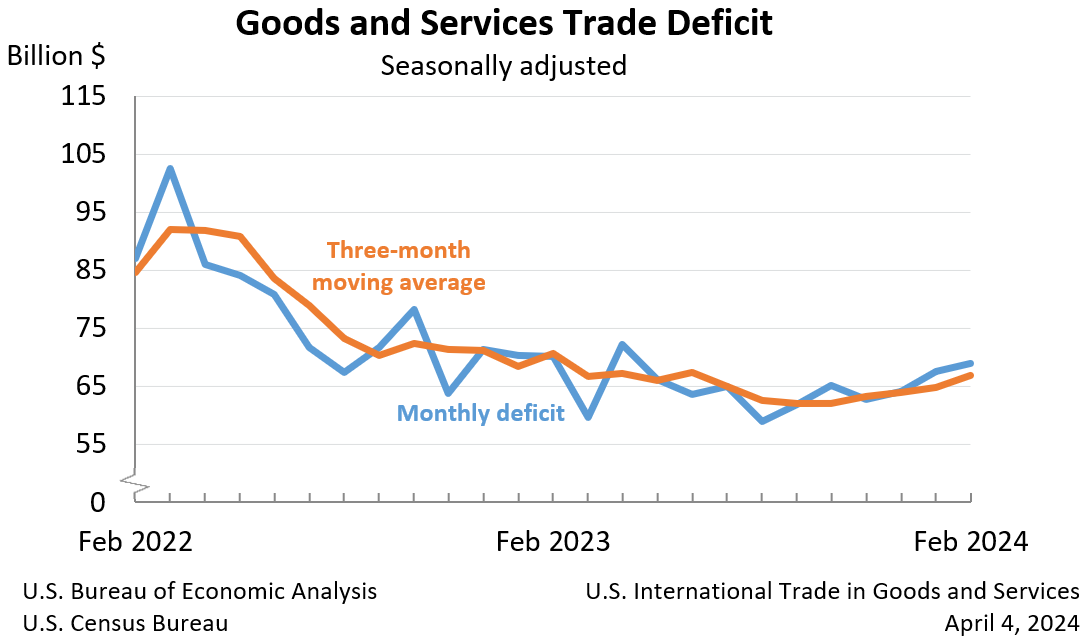
Exports, Imports, and Balance (exhibit 1)
February exports were $263.0 billion, $5.8 billion more than January exports. February imports were $331.9 billion, $7.1 billion more than January imports.
The February increase in the goods and services deficit reflected a decrease in the goods deficit of $0.3 billion to $91.4 billion and a decrease in the services surplus of $1.6 billion to $22.5 billion.
Year-to-date, the goods and services deficit decreased $3.9 billion, or 2.8 percent, from the same period in 2023. Exports increased $9.3 billion or 1.8 percent. Imports increased $5.4 billion or 0.8 percent.
Three-Month Moving Averages (exhibit 2)
The average goods and services deficit increased $2.1 billion to $66.9 billion for the three months ending in February.
- Average exports increased $3.0 billion to $259.0 billion in February.
- Average imports increased $5.1 billion to $325.9 billion in February.
Year-over-year, the average goods and services deficit decreased $3.7 billion from the three months ending in February 2023.
- Average exports increased $5.3 billion from February 2023.
- Average imports increased $1.6 billion from February 2023.
Exports (exhibits 3, 6, and 7)
Exports of goods increased $5.0 billion to $176.7 billion in February.
Exports of goods on a Census basis increased $5.0 billion.
- Crude oil increased $1.1 billion.
- Nonmonetary gold increased $0.6 billion.
- Soybeans increased $1.0 billion.
- Civilian aircraft increased $1.4 billion.
- Passenger cars decreased $0.9 billion.
Net balance of payments adjustments decreased less than $0.1 billion.
Exports of services increased $0.8 billion to $86.4 billion in February.
- Travel increased $0.4 billion.
- Transport increased $0.3 billion.
Imports (exhibits 4, 6, and 8)
Imports of goods increased $4.7 billion to $268.1 billion in February.
Imports of goods on a Census basis increased $4.8 billion.
- Cell phones and other household goods increased $1.4 billion.
- Pharmaceutical preparations decreased $1.3 billion.
- Other foods increased $0.5 billion.
- Other automotive parts and accessories increased $0.5 billion.
Imports of services increased $2.4 billion to $63.8 billion in February.
- Travel increased $1.3 billion.
- Transport increased $1.0 billion.
Real Goods in 2017 Dollars – Census Basis (exhibit 11)
The real goods deficit increased $1.0 billion, or 1.2 percent, to $87.0 billion in February, compared to a 0.3 percent decrease in the nominal deficit.
- Real exports of goods increased $3.0 billion, or 2.1 percent, to $147.8 billion, compared to a 2.9 percent increase in nominal exports.
- Real imports of goods increased $4.0 billion, or 1.7 percent, to $234.9 billion, compared to a 1.8 percent increase in nominal imports.
Revisions to January exports
- Exports of goods were revised down $0.1 billion.
- Exports of services were revised up $0.1 billion.
Revisions to January imports
- Imports of goods were revised down less than $0.1 billion.
- Imports of services were revised up $0.2 billion.
Goods by Selected Countries and Areas: Monthly – Census Basis (exhibit 19)
The February figures show surpluses, in billions of dollars, with South and Central America ($5.5), Netherlands ($4.3), Hong Kong ($2.8), Australia ($1.6), United Kingdom ($0.8), Belgium ($0.6), Brazil ($0.6), Switzerland ($0.4), and Saudi Arabia (less than $0.1). Deficits were recorded, in billions of dollars, with China ($21.9), European Union ($17.6), Mexico ($15.3), Vietnam ($9.6), Germany ($7.6), Japan ($6.2), Ireland ($5.3), South Korea ($5.2), Canada ($5.1), India ($4.4), Taiwan ($4.2), Italy ($3.4), Malaysia ($2.4), France ($0.8), Singapore ($0.3), and Israel ($0.3).
- The balance with Switzerland shifted from a deficit of $1.5 billion in January to a surplus of $0.4 billion in February. Exports increased $0.7 billion to $3.6 billion and imports decreased $1.2 billion to $3.2 billion.
- The deficit with Japan decreased $1.1 billion to $6.2 billion in February. Exports increased $0.1 billion to $6.4 billion and imports decreased $1.0 billion to $12.6 billion.
- The deficit with Mexico increased $2.7 billion to $15.3 billion in February. Exports increased $0.4 billion to $27.6 billion and imports increased $3.1 billion to $43.0 billion.
All statistics referenced are seasonally adjusted; statistics are on a balance of payments basis unless otherwise specified. Additional statistics, including not seasonally adjusted statistics and details for goods on a Census basis, are available in exhibits 1-20b of this release. For information on data sources, definitions, and revision procedures, see the explanatory notes in this release. The full release can be found at www.census.gov/foreign-trade/Press-Release/current_press_release/index.html or www.bea.gov/data/intl-trade-investment/international-trade-goods-and-services . The full schedule is available in the Census Bureau's Economic Briefing Room at www.census.gov/economic-indicators/ or on BEA's website at www.bea.gov/news/schedule .
Next release: May 2, 2024, at 8:30 a.m. EDT U.S. International Trade in Goods and Services, March 2024
Upcoming Updates to Goods and Services
With the releases of the "U.S. International Trade in Goods and Services" report (FT-900) and the FT-900 Annual Revision on June 6, 2024, statistics on trade in goods, on both a Census basis and a balance of payments (BOP) basis, and statistics on trade in services will be revised beginning with 2019. The revised statistics for goods on a BOP basis and for services will also be included in the "U.S. International Transactions, 1st Quarter 2024 and Annual Update" report and in the international transactions interactive database , both to be released by BEA on June 20, 2024.
Revised statistics on trade in goods will reflect:
- Corrections and adjustments to previously published not seasonally adjusted statistics for goods on a Census basis.
- End-use reclassifications of several commodities.
- Recalculated seasonal and trading-day adjustments.
- Newly available and revised source data on BOP adjustments, which are adjustments that BEA applies to goods on a Census basis to convert them to a BOP basis. See the "Goods (balance of payments basis)" section in the explanatory notes for more information.
Revised statistics on trade in services will reflect:
- An improved estimation method for transport services.
- Newly available and revised source data, primarily from BEA surveys of international services.
- Recalculated seasonal adjustments.
- Revised temporal distributions of quarterly source data to monthly statistics. See the "Services" section in the explanatory notes for more information.
A preview of BEA's 2024 annual update of the International Transactions Accounts will be available in the Survey of Current Business later in April 2024.
Full Release & Tables (PDF)
Tables only (excel), release highlights (pdf), historical comparisons (pdf), u.s. trade in goods and services, 1960-present (excel), u.s. trade in goods and services by selected countries and areas, 1999-present, seasonal adjustment by selected countries and areas, frequently asked questions.
- Goods Data Inquiries U.S. Census Bureau, Economic Indicators Division 301-763-2311 [email protected]
- Goods Media Inquiries U.S. Census Bureau, Public Information Office 301-763-3030 [email protected]
- Services Data and Media Inquiries Balance of Payments Division 301-278-9559 [email protected]
- Media Connie O’Connell 301-278-9003 [email protected]
Explanatory Notes
Goods (Census basis)
Data for goods on a Census basis are compiled from the documents collected by U.S. Customs and Border Protection (CBP) and reflect the movement of goods between foreign countries and the 50 states, the District of Columbia, Puerto Rico, the U.S. Virgin Islands, and U.S. Foreign Trade Zones. They include government and non-government shipments of goods and exclude shipments between the United States and its territories and possessions; transactions with U.S. military, diplomatic, and consular installations abroad; U.S. goods returned to the United States by its Armed Forces; personal and household effects of travelers; and in-transit shipments. The General Imports value reflects the total arrival of merchandise from foreign countries that immediately enters consumption channels, warehouses, or Foreign Trade Zones.
For imports, the value reported is the CBP-appraised value of merchandise—generally, the price paid for merchandise for export to the United States. Import duties, freight, insurance, and other charges incurred in bringing merchandise to the United States are excluded. The exception is exhibit 17a, which shows CIF import value. The CIF (cost, insurance, and freight) value represents the landed value of the merchandise at the first port of arrival in the United States. It is computed by adding import charges to the customs value and therefore excludes U.S. import duties.
Exports are valued at the f.a.s. (free alongside ship) value of merchandise at the U.S. port of export, based on the transaction price including inland freight, insurance, and other charges incurred in placing the merchandise alongside the carrier at the U.S. port of exportation.
Revision procedure (Census basis)
Monthly revisions: Monthly data include actual month's transactions as well as a small number of transactions for previous months. Each month, the U.S. Census Bureau revises the aggregate seasonally adjusted (nominal and real, or chained-dollar) and unadjusted export, import, and trade balance figures, as well as the end-use totals for the prior month. Country detail data and commodity detail data, based on the Standard International Trade Classification (SITC) Revision 4 and the North American Industry Classification System (NAICS), are not revised monthly. The timing adjustment shown in exhibit 14 is the difference between monthly data as originally reported and as recompiled.
For January 2024, unadjusted exports of goods were revised down less than $0.1 billion and unadjusted imports of goods were revised up less than $0.1 billion. Goods carry-over in February 2024 was $0.4 billion (0.3 percent) for exports and less than $0.1 billion (less than 0.1 percent) for imports. For January 2024, revised export carry-over was $0.1 billion (0.1 percent) and revised import carry-over was less than $0.1 billion (less than 0.1 percent).
Quarterly revisions to chain-weighted dollar series: For March, June, September, and December statistical month releases, revisions are made to the real, or chained-dollar, series presented in exhibits 10 and 11: the previous five months are revised to incorporate the U.S. Bureau of Labor Statistics' (BLS) revisions to price indexes, which are used to produce the real series and to align Census data with data published by the U.S. Bureau of Economic Analysis (BEA) in the national income and product accounts (NIPAs).
Annual revisions: Each June, not seasonally adjusted goods data are revised to redistribute monthly data that arrived too late for inclusion in the month of transaction. In addition, revisions are made to reflect corrections received subsequent to the monthly revisions. Seasonally adjusted data are also revised to reflect recalculated seasonal and trading-day adjustments. These revisions are reflected in totals, end-use, commodity, and country summary data.
Other revisions: For December and January statistical month releases, each prior month of the most recent full year is revised so that the totals of the seasonally adjusted months equal the annual totals.
U.S./Canada data exchange and substitution
Data for U.S. exports to Canada are derived from import data compiled by Canada. The use of Canada's import data to produce U.S. export data requires several alignments in order to compare the two series.
- Coverage - Canadian imports are based on country of origin. U.S. goods shipped from a third country are included. U.S. exports exclude these foreign shipments. For February 2024, these shipments totaled $355.5 million. U.S. export coverage also excludes U.S. postal shipments to Canada. For February 2024, these shipments totaled $37.5 million. U.S. import coverage includes shipments of railcars and locomotives from Canada. Effective with January 2004 statistics, Canada excludes these shipments from its goods exports to the United States, therefore creating coverage differences between the two countries for these goods.
- Valuation - Canadian imports are valued at the point of origin in the United States. However, U.S. exports are valued at the port of exit in the United States and include inland freight charges, making the U.S. export value slightly larger than the Canadian import value. Canada requires inland freight to be reported separately from the value of the goods. Combining the inland freight and the Canadian reported import value provides a consistent valuation for all U.S. exports. Inland freight charges for February 2024 accounted for 1.6 percent of the value of U.S. exports to Canada.
- Re-exports - Unlike Canadian imports, which are based on country of origin, U.S. exports include re-exports of foreign goods. Therefore, the aggregate U.S. export figure is slightly larger than the Canadian import figure. For February 2024, re-exports to Canada were $4,960.4 million.
- Exchange Rate - Average monthly exchange rates are applied to convert the published data to U.S. currency. For February 2024, the average exchange rate was 1.3500 Canadian dollars per U.S. dollar.
- Other - There are other minor differences, such as rounding error, that are statistically insignificant.
Canadian estimates: Effective with January 2001 statistics, the current month data for exports to Canada contain an estimate for late arrivals and corrections. In the following month, this estimate is replaced, in the news release exhibits only, with the actual value of late receipts and corrections. This estimate improves the current month data for exports to Canada and treats late receipts for exports to Canada in a manner that is more consistent with the treatment of late receipts for exports to other countries.
Nonsampling errors
The goods data are a complete enumeration of documents collected by CBP and are not subject to sampling errors. Quality assurance procedures are performed at every stage of collection, processing, and tabulation. However, the data are still subject to several types of nonsampling errors. The most significant of these include reporting errors, undocumented shipments, timeliness, data capture errors, and errors in the estimation of low-valued transactions.
Reporting errors: Reporting errors are mistakes or omissions made by importers, exporters, or their agents in their import or export declarations. Most errors involve missing or invalid commodity classification codes and missing or incorrect quantities or shipping weights. They have a negligible effect on aggregate import, export, and balance of trade statistics. However, they can affect the detailed commodity statistics.
Undocumented shipments: Federal regulations require importers, exporters, or their agents to report all merchandise shipments above established exemption levels. The Census Bureau has determined that not all required documents are filed, particularly for exports.
Timeliness and data capture errors: The Census Bureau captures import and export information from administrative documents and through various automated collection programs. Documents may be lost, and data may be incorrectly keyed, coded, or recorded. Transactions may be included in a subsequent month's statistics if received late.
Low-valued transactions: The total values of transactions valued as much as or below $2,500 for exports and $2,000 ($250 for certain quota items) for imports are estimated for each country, using factors based on the ratios of low-valued shipments to individual country totals for past periods.
The Census Bureau recommends that data users incorporate this information into their analyses, as nonsampling errors could impact the conclusion drawn from the results. See " U.S. Merchandise Trade Statistics: A Quality Profile " (October 2014) for a detailed discussion of errors affecting the goods data.
Area groupings
North America: Canada, Mexico.
Dominican Republic-Central America-United States Free Trade Agreement (CAFTA-DR): Costa Rica, Dominican Republic, El Salvador, Guatemala, Honduras, Nicaragua.
Europe: Albania, Andorra, Armenia, Austria, Azerbaijan, Belarus, Belgium, Bosnia and Herzegovina, Bulgaria, Croatia, Cyprus, Czech Republic, Denmark, Estonia, Faroe Islands, Finland, France, Georgia, Germany, Gibraltar, Greece, Hungary, Iceland, Ireland, Italy, Kazakhstan, Kosovo, Kyrgyzstan, Latvia, Liechtenstein, Lithuania, Luxembourg, Malta, Moldova, Monaco, Montenegro, Netherlands, North Macedonia, Norway, Poland, Portugal, Romania, Russia, San Marino, Serbia, Slovakia, Slovenia, Spain, Svalbard-Jan Mayen Island, Sweden, Switzerland, Tajikistan, Turkey, Turkmenistan, Ukraine, United Kingdom, Uzbekistan, Vatican City.
European Union: Austria, Belgium, Bulgaria, Croatia, Cyprus, Czech Republic, Denmark, Estonia, Finland, France, Germany, Greece, Hungary, Ireland, Italy, Latvia, Lithuania, Luxembourg, Malta, Netherlands, Poland, Portugal, Romania, Slovakia, Slovenia, Spain, Sweden.
Euro Area: Austria, Belgium, Croatia, Cyprus, Estonia, Finland, France, Germany, Greece, Ireland, Italy, Latvia, Lithuania, Luxembourg, Malta, Netherlands, Portugal, Slovakia, Slovenia, Spain.
Pacific Rim: Australia, Brunei, China, Hong Kong, Indonesia, Japan, Korea (South), Macau, Malaysia, New Zealand, Papua New Guinea, Philippines, Singapore, Taiwan.
South/Central America: Anguilla, Antigua and Barbuda, Argentina, Aruba, Bahamas, Barbados, Belize, Bermuda, Bolivia, Brazil, British Virgin Islands, Cayman Islands, Chile, Colombia, Costa Rica, Cuba, Curacao, Dominica, Dominican Republic, Ecuador, El Salvador, Falkland Islands (Islas Malvinas), French Guiana, Grenada, Guadeloupe, Guatemala, Guyana, Haiti, Honduras, Jamaica, Martinique, Montserrat, Netherlands Antilles, Nicaragua, Panama, Paraguay, Peru, Sint Maarten, St. Kitts and Nevis, St. Lucia, St. Vincent and the Grenadines, Suriname, Trinidad and Tobago, Turks and Caicos Islands, Uruguay, Venezuela.
Africa: Algeria, Angola, Benin, Botswana, British Indian Ocean Territories, Burkina Faso, Burundi, Cabo Verde, Cameroon, Central African Republic, Chad, Comoros, Congo (Brazzaville), Congo (Kinshasa), Djibouti, Egypt, Equatorial Guinea, Eritrea, Eswatini, Ethiopia, French Southern and Antarctic Lands, Gabon, Gambia, Ghana, Guinea, Guinea-Bissau, Ivory Coast, Kenya, Lesotho, Liberia, Libya, Madagascar, Malawi, Mali, Mauritania, Mauritius, Mayotte, Morocco, Mozambique, Namibia, Niger, Nigeria, Reunion, Rwanda, St. Helena, Sao Tome and Principe, Senegal, Seychelles, Sierra Leone, Somalia, South Africa, South Sudan, Sudan, Tanzania, Togo, Tunisia, Uganda, Zambia, Zimbabwe.
Adjustments for seasonal and trading-day variations
Goods are initially classified under the Harmonized Commodity Description and Coding System (Harmonized System), which is an internationally accepted standard for the commodity classification of traded goods. The Harmonized System describes and measures the characteristics of the goods and is the basis for the systems used in the United States: Schedule B for exports and Harmonized Tariff Schedule for imports. Combining trade into approximately 140 export and 140 import end-use categories makes it possible to examine goods according to their principal uses (see exhibits 7 and 8). These categories are used as the basis for computing the seasonal and trading-day adjusted data. These adjusted data are then summed to the six end-use aggregates for publication (see exhibit 6). The Census Bureau provides these data to BEA for use in the NIPAs and in the U.S international transactions accounts (balance of payments accounts).
Exhibit 19 shows goods (Census basis) that are seasonally adjusted for selected countries and world areas. Unlike the commodity-based adjustments discussed above, these adjustments are developed and applied directly at the country and world area levels. For total exports and imports, data users should refer to the commodity-based totals shown in the other exhibits. The seasonally adjusted country and world area data will not sum to the seasonally adjusted commodity-based totals because the seasonally adjusted country and world area data and the commodity-based totals are derived from different aggregations of the export and import data and from different seasonal adjustment models. Data users should use caution drawing comparisons between the two sets of seasonally adjusted series.
The seasonal adjustment procedure (X-13ARIMA-SEATS) is based on a model that estimates the monthly movements as percentages above or below the general level of series (unlike other methods that redistribute the actual series values over the calendar year). Because the data series for aircraft is highly variable, users studying data trends may wish to analyze trade in aircraft separately from other trade.
Adjustments for price change
Data adjusted for seasonal variation on a real, or chained-dollar, basis (2017 reference year) are presented in exhibits 10 and 11. This adjustment for price change is done using the Fisher chain-weighted methodology. The deflators are primarily based on the monthly price indexes published by the BLS using techniques developed for the NIPAs by BEA.
Principal commodities
Goods data appearing in exhibit 15 are classified in terms of the SITC Revision 4, with the exception of agricultural and manufactured goods. Agricultural goods are defined by the U.S. Department of Agriculture (USDA) based on World Trade Organization guidance; they consist of non-fishery food products, raw fibers, feeds, and derivatives. Manufactured goods conform to the NAICS; they consist of goods that have been mechanically, physically, or chemically transformed. USDA agricultural goods and NAICS manufactured goods are not mutually exclusive categories.
Re-exports are foreign merchandise entering the country as imports and then exported in substantially the same condition as when imported. Re-exports, which are included in overall export totals, appear as separate line items in exhibit 15.
Advanced technology products
About 500 of some 22,000 Schedule B and Harmonized Tariff Schedule classification codes used in reporting U.S. merchandise trade are identified as "advanced technology" codes, and they meet the following criteria:
- The code contains products whose technology is from a recognized high technology field (e.g., biotechnology).
- These products represent leading edge technology in that field.
- Such products constitute a significant part of all items covered in the selected classification code.
The aggregation of the goods results in a measure of advanced technology trade that appears in exhibits 16 and 16a. This product- and commodity-based measure of advanced technology differs from broader NAICS-based measures, which include all goods produced by a particular industry group, regardless of the level of technology embodied in the goods.
Goods trade in the Advance Economic Indicators Report
In addition to the U.S. International Trade in Goods and Services report (FT-900), which is released jointly with BEA, the Census Bureau also releases advance statistics on international trade in goods, along with advance estimates on retail and wholesale inventories, in the Advance Economic Indicators Report ( Advance Report ). Trade statistics in the Advance Report, released on average 24 to 26 calendar days after the end of the reference month, reflect nearly complete coverage of goods trade, while statistics in the FT-900, released on average 34 to 36 calendar days after the end of the reference month, reflect complete coverage.
The Advance Report contains advance statistics for goods trade on a Census basis by principal end-use category, thus providing users an earlier high-level snapshot of U.S. international trade for the featured month. Commodity and country details and statistics for goods trade on a balance of payments (BOP) basis and for services trade are released several days later in the FT-900. See the Advance Report Frequently Asked Questions for more information.
The FT-900 is the primary source for the goods trade data used in BEA's quarterly gross domestic product (GDP) statistics. However, for the advance GDP estimate, FT-900 data for the third month are not yet available, so BEA uses data from the Advance Report. Because only goods trade on a Census basis by principal end-use category is available in the Advance Report, BEA applies adjustments, such as BOP and coverage adjustments, to the Advance Report statistics to produce detailed estimates for incorporation into the advance GDP estimate. See the "Key Source Data and Assumptions" table that accompanies each GDP release for more information.
Goods (BOP basis) and services
Quarterly and annual statistics for goods on a BOP basis and for services are included in the U.S. international transactions accounts (ITAs), which are published by BEA in news releases in March, June, September, and December and in the Survey of Current Business in January, April, July, and October. The next release of the ITAs is scheduled for June 20, 2024.
In addition, BEA releases detailed monthly and quarterly goods statistics , which consist of statistics on trade in goods by end-use category and commodity on both a Census basis and a BOP basis, and detailed annual services statistics , which consist of statistics on trade in services and on services supplied through affiliates of multinational enterprises. The services statistics provide detail on U.S. trade in services by type and by country and area and detail on services supplied through affiliates by industry and by country and area.
Goods (BOP basis)
Goods on a Census basis are adjusted by BEA to a BOP basis to align the data with the concepts and definitions used to prepare the international and national economic accounts. These adjustments, which are applied separately to exports and imports, are necessary to supplement coverage of the Census data, to eliminate duplication of transactions recorded elsewhere in the international accounts, and to value transactions at market prices. They include both additions to and deductions from goods on a Census basis and are presented in this release as net adjustments . Adjustments that exhibit significant seasonal patterns are seasonally adjusted. BEA also publishes more detailed quarterly and annual statistics for net adjustments in ITA Table 2.4. U.S. International Trade in Goods, Balance of Payments Adjustments .
The export adjustments include:
Gold exports, nonmonetary - This addition is made for gold that is purchased by foreign official agencies from private dealers in the United States and held at the Federal Reserve Bank of New York. The Census data only include gold that leaves the U.S. customs territory.
Goods procured in U.S. ports by foreign carriers - This addition is made for foreign air and ocean carriers' fuel purchases in U.S. ports.
Net exports of goods under merchanting - This addition is made to include the net value of the purchase and subsequent resale of goods abroad without the goods entering the United States. Because these goods do not cross the U.S. customs frontier, their value is not recorded in the Census data.
Other adjustments to exports include:
Deductions for equipment repairs (parts and labor), developed motion picture film, military grant-aid, and, for periods prior to 2010, goods identified in the Census data as exports under the Foreign Military Sales (FMS) program. Additions for sales of fish caught in U.S. territorial waters, exports of electric energy to Mexico, private gift parcels, military goods transferred through grants, vessels and oil rigs for which ownership changes, valuation of software exports at market value, low-value (below reporting threshold) transactions for 1999–2009 to phase in a revised Census Bureau low-value methodology that was implemented for goods on a Census basis beginning with statistics for 2010, and, for periods prior to 2010, FMS goods exports reported to BEA by the U.S. Department of Defense.
The import adjustments include:
Gold imports, nonmonetary - This addition is made for gold sold by foreign official agencies to private purchasers out of stock held at the Federal Reserve Bank of New York. The Census data only include gold that enters the U.S. customs territory.
Goods procured in foreign ports by U.S. carriers - This addition is made for U.S. air and ocean carriers' fuel purchases in foreign ports.
Imports by U.S. military agencies - This addition is made for purchases of goods abroad by U.S. military agencies, which are reported to BEA by the Department of Defense. The Census data only include imports of goods by U.S. military agencies that enter the U.S. customs territory.
Inland freight in Canada and Mexico - This addition is made for inland freight in Canada and Mexico. Imports of goods from all countries should be valued at the customs value—the value at the foreign port of export including inland freight charges. For imports from Canada and Mexico, this should be the cost of the goods at the U.S. border. However, the customs value for imports for certain Canadian and Mexican goods is the point of origin in Canada or Mexico. BEA makes an addition for the inland freight charges of transporting these goods to the U.S. border to make the value comparable to the customs value reported for imports from other countries.
Other adjustments to imports include:
Deductions for equipment repairs (parts and labor), repairs to U.S. vessels abroad, and developed motion picture film. Additions for non-reported imports of locomotives and railcars from Canada and Mexico, non-reported imports of aircraft, imports of electric energy from Mexico, conversion of vessels for commercial use, valuation of software imports at market value, and low-value (below reporting threshold) transactions for 1999–2009 to phase in a revised Census Bureau low-value methodology that was implemented for goods on a Census basis beginning with statistics for 2010.
The services statistics cover transactions between foreign countries and the 50 states, the District of Columbia, Puerto Rico, the U.S. Virgin Islands, and other U.S. territories and possessions. Transactions with U.S. military, diplomatic, and consular installations abroad are excluded because these installations are considered to be part of the U.S. economy.
Services statistics are based on quarterly, annual, and benchmark surveys and information obtained from monthly government and private sector reports. For categories for which monthly data are not available, monthly statistics are derived from quarterly statistics through temporal distribution, or interpolation. The interpolation methodology used by BEA is the modified Denton proportional first difference method. This method preserves the pattern of the monthly indicator series, if available, while satisfying the annual aggregation constraints. See " An Empirical Review of Methods for Temporal Distribution and Interpolation in the National Accounts " (May 2008) for more information. Services are seasonally adjusted when statistically significant seasonal patterns are present.
Services are shown in eleven broad categories. The following is a brief description of the types of services included in each category:
Maintenance and repair services n.i.e. (not included elsewhere) - Consists of maintenance and repair services performed by residents of one country on goods that are owned by residents of another country. The repairs may be performed at the site of the repair facility or elsewhere. Excludes such services in which the cost is included in the price of the goods and is not billed separately or is declared as a part of the price of the goods on the import or export declaration filed with U.S. Customs and Border Protection. Maintenance and repair of computers are included under computer services, and some maintenance and repair of ships, aircraft, and other transport equipment are included under transport. Construction maintenance and repair are included under construction.
Transport - Consists of transactions associated with moving people and freight from one location to another and includes related supporting and auxiliary services. Transport covers all modes of transportation, including air, sea, rail, road, space, and pipeline. Postal and courier services and port services, which cover cargo handling, storage and warehousing, and other related transport services, are also included.
Travel (for all purposes including education) - Includes goods and services acquired by nonresidents while abroad. A traveler is defined as a person who stays, or intends to stay, for less than one year in a country of which he or she is not a resident or as a nonresident whose purpose is to obtain education or medical treatment, no matter how long the stay. Purchases can be either for own use or for gifts to others. Travel is a transactor-based component that covers a variety of goods and services, primarily lodging, meals, transportation in the country of travel, amusement, entertainment, and gifts. Travel excludes air passenger services for travel between countries, which are included in transport, and goods for resale, which are included in goods.
Travel includes business and personal travel. Business travel covers goods and services acquired for use by persons whose primary purpose for travel is for business (including goods and services for which business travelers are reimbursed by employers). Business travel also includes expenditures by border, seasonal, and other short-term workers in their economy of employment. Personal travel covers travel for all non-business purposes, including for medical or educational purposes.
Construction - Consists of the services provided to create, renovate, repair, or extend buildings, land improvements, and civil engineering constructions, such as roads and bridges. Additionally, in concept, inputs purchased by foreign construction contractors for projects in the United States are included in construction exports, and inputs purchased abroad by U.S. construction contractors are included in construction imports. However, in practice, data are not available to estimate inputs purchased by foreign contractors for projects in the United States, so BEA statistics on construction exports do not include this component.
Insurance services - Includes the direct insurance services of providing life insurance and annuities, non-life (property and casualty) insurance, reinsurance, freight insurance, and auxiliary insurance services. Insurance is measured as gross premiums earned plus premium supplements less claims payable, with an adjustment for claims volatility. Premium supplements represent investment income from insurance reserves, which are attributed to policyholders who are treated as paying the income back to the insurer. Auxiliary insurance services include agents' commissions, brokerage services, insurance consulting services, actuarial services, and other insurance services.
Financial services - Includes financial intermediary and auxiliary services, except insurance services. These services include those normally provided by banks and other financial institutions, such as securities brokerage and underwriting, financial management, financial advisory, and custody services; credit card and other credit-related services; and securities lending, electronic funds transfer, and other services. Financial services include services for which an explicit commission or fee is charged as well as implicit charges, such as (1) implicit fees for bond transactions, measured as the difference between bid and ask prices; (2) margins on buying and selling transactions (called market-making services); and (3) margins between interest payable and the reference rate on loans and deposits (called financial intermediation service charges indirectly measured, abbreviated as FISIM).
Charges for the use of intellectual property n.i.e. - Includes (1) charges for the use of proprietary rights, such as patents, trademarks, copyrights, and franchises, and (2) charges for licenses to reproduce and/or distribute intellectual property embodied in produced originals (such as copyrights on books and manuscripts, computer software, cinematographic works, and sound recordings) and related rights (such as for live performances and television, cable, or satellite broadcast). Charges for end-user rights to use general-use computer software and outright sales of customized computer software are included under computer services. Charges for end-user rights to use audiovisual content, such as film, television programming, and sound recordings, as well as outright sales of audiovisual originals, are included under audiovisual services, a component of personal, cultural, and recreational services.
Telecommunications, computer, and information services - Telecommunications services include the broadcast or transmission of sound, images, data, or other information by electronic means. These services do not include the value of the information transmitted. Computer services consist of hardware- and software-related services and data processing services. Sales of customized software and related use licenses, as well as licenses to use non-customized software with a periodic license fee, are also included, as is software downloaded or otherwise electronically delivered. Cross-border transactions in non-customized packaged software with a license for perpetual use are included in goods. Information services include news agency services, database services, and web search portals.
Other business services - Consists of research and development services, professional and management consulting services, and technical, trade-related, and other business services. Research and development services include services associated with basic and applied research and experimental development of new products and processes as well as outright sales of the outcomes of research and development (such as patents, copyrights, and information about industrial processes). Professional and management consulting services include legal services, accounting, management consulting, managerial services, public relations services, advertising, and market research. Amounts received by a parent company from its affiliates for general overhead expenses related to these services are included. Technical, trade-related, and other business services include architectural and engineering, waste treatment, operational leasing, trade-related, and other business services.
Personal, cultural, and recreational services - Consists of the following three subcategories: (1) audiovisual services, which covers production of audiovisual content, end-user rights to use audiovisual content, and outright sales and purchases of audiovisual originals; (2) artistic-related services, which includes the services provided by performing artists, authors, composers, and other visual artists; set, costume, and lighting design; presentation and promotion of performing arts and other live entertainment events; and fees to artists and athletes for performances, sporting events, and similar events; and (3) other personal, cultural, and recreational services, which includes services such as education services delivered online, remotely provided telemedicine services, and services associated with museum and other cultural, sporting gambling, and recreational activities, except those acquired by customers traveling outside their country of residence.
Government goods and services n.i.e. - Includes goods and services supplied by and to enclaves, such as embassies, military bases, and international organizations; goods and services acquired from the host economy by diplomats, consular staff, and military personnel located abroad and their dependents; and goods and services supplied by and to governments that are not included in other goods and services categories. Goods and services supplied by and to governments are classified to specific goods and services categories when source data permit.
Goods (BOP basis) and services by country and area
Monthly country and area detail is not available for goods on a BOP basis or for services. However, quarterly statistics on goods on a BOP basis and on services that are seasonally adjusted by geography are shown in exhibit 20. Unlike the seasonal adjustments by commodity and by service type that are applied to the global totals, these adjustments are developed and applied directly at the country and world area levels. For total exports and imports, data users should refer to the by-commodity and by-service type totals shown in the other exhibits. The seasonally adjusted country and world area data will not sum to the seasonally adjusted by-commodity and by-service type totals because the two sets of statistics are derived from different aggregations of the export and import data and from different seasonal adjustment models. Data users should use caution drawing comparisons between the two sets of seasonally adjusted series.
The definitions of the world areas shown in exhibit 20 are consistent with the definitions for goods on a Census basis (see Area groupings above) with a few exceptions. For services, CAFTA-DR is not available because trade with this area currently is not reviewed for seasonality. For goods on a BOP basis and for services, European Union reflects the composition of the areas at the time of reporting.
Revision procedure (goods on a BOP basis and services)
Monthly revisions : Each month, a preliminary estimate for the current month and a revised estimate for the immediately preceding month are released. After the initial revision, no further revisions are made to a month until more complete source data become available in March, June, September, and December.
Quarterly revisions : The releases in March, June, September, and December contain revised estimates for the previous six months to incorporate more comprehensive and updated source data.
Annual revisions : Each June, historical data are revised to incorporate newly available and revised source data, changes in definitions and classifications, and changes in estimation methods. Seasonally adjusted data are also revised to reflect recalculated seasonal and trading-day adjustments.
Other revisions : The release for December statistical month contains revisions to goods for January through November of the most recent year; the release for January statistical month contains revisions to both goods and services for all months of the most recent year. These revisions result from forcing the seasonally adjusted months to equal the annual totals.
Data availability
The FT-900 and the FT-900 Supplement are available at www.census.gov/ft900 or www.bea.gov/data/intl-trade-investment/international-trade-goods-and-services .
Census Bureau's application programming interface (API): The Census Bureau's API, available at www.census.gov/developers , lets developers create custom apps to reach new users and makes key demographic, socio-economic, and housing statistics more accessible than ever before.
BEA's data API: BEA's data API, available at apps.bea.gov/API/signup/ , provides programmatic access to BEA's published economic statistics using industry-standard methods and procedures.
Kyrgyzstan urges citizens not to fly to Russia unless necessary
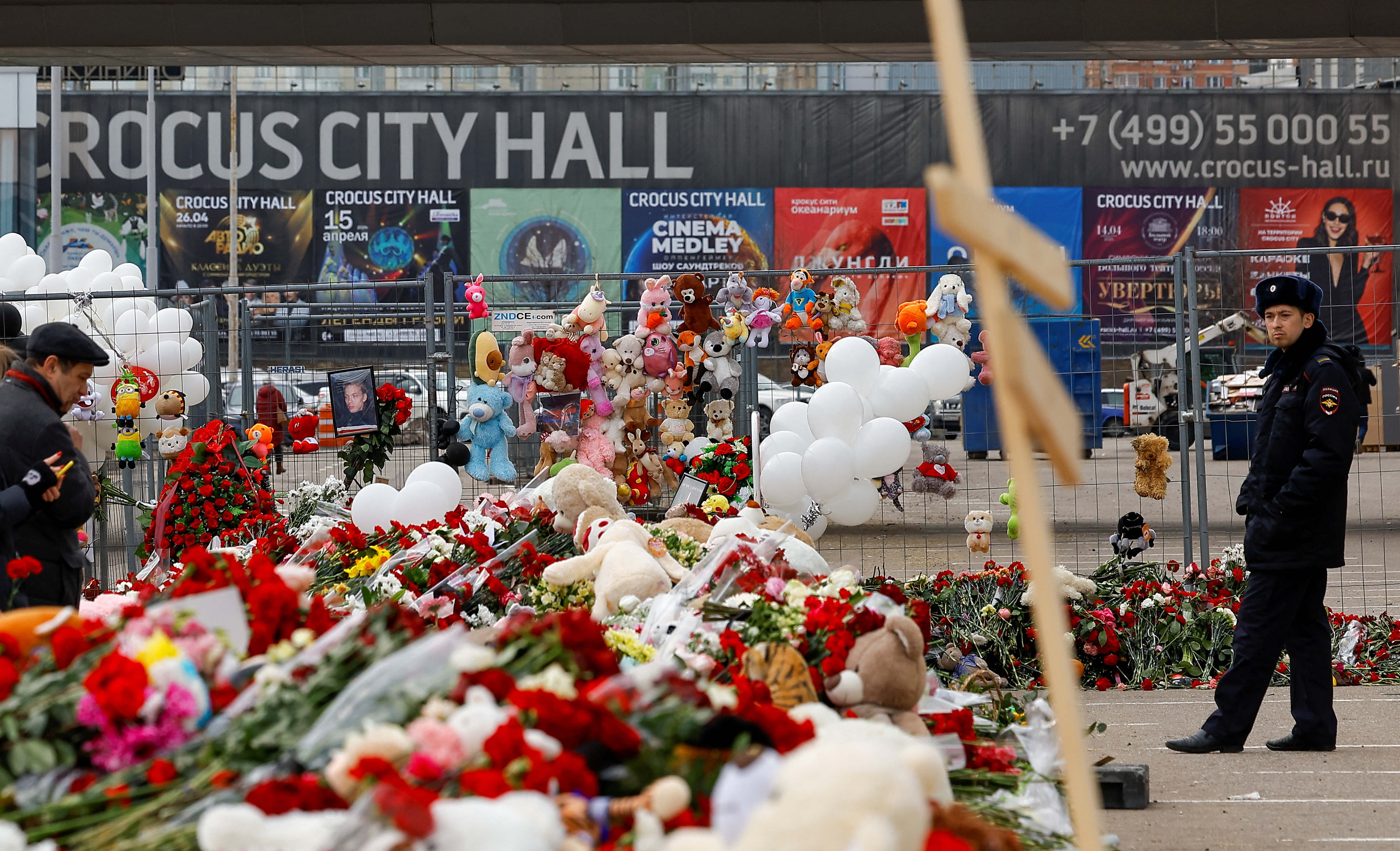
MIGRANT LABOUR
The Reuters Daily Briefing newsletter provides all the news you need to start your day. Sign up here.
Reporting by Olzhas Auyezov and Mark Trevelyan Editing by Gareth Jones
Our Standards: The Thomson Reuters Trust Principles. , opens new tab

An activated but faulty missile launcher on a Danish navy vessel triggered a closure of airspace and shipping traffic in the Great Belt strait on Thursday, the Danish armed forces said.
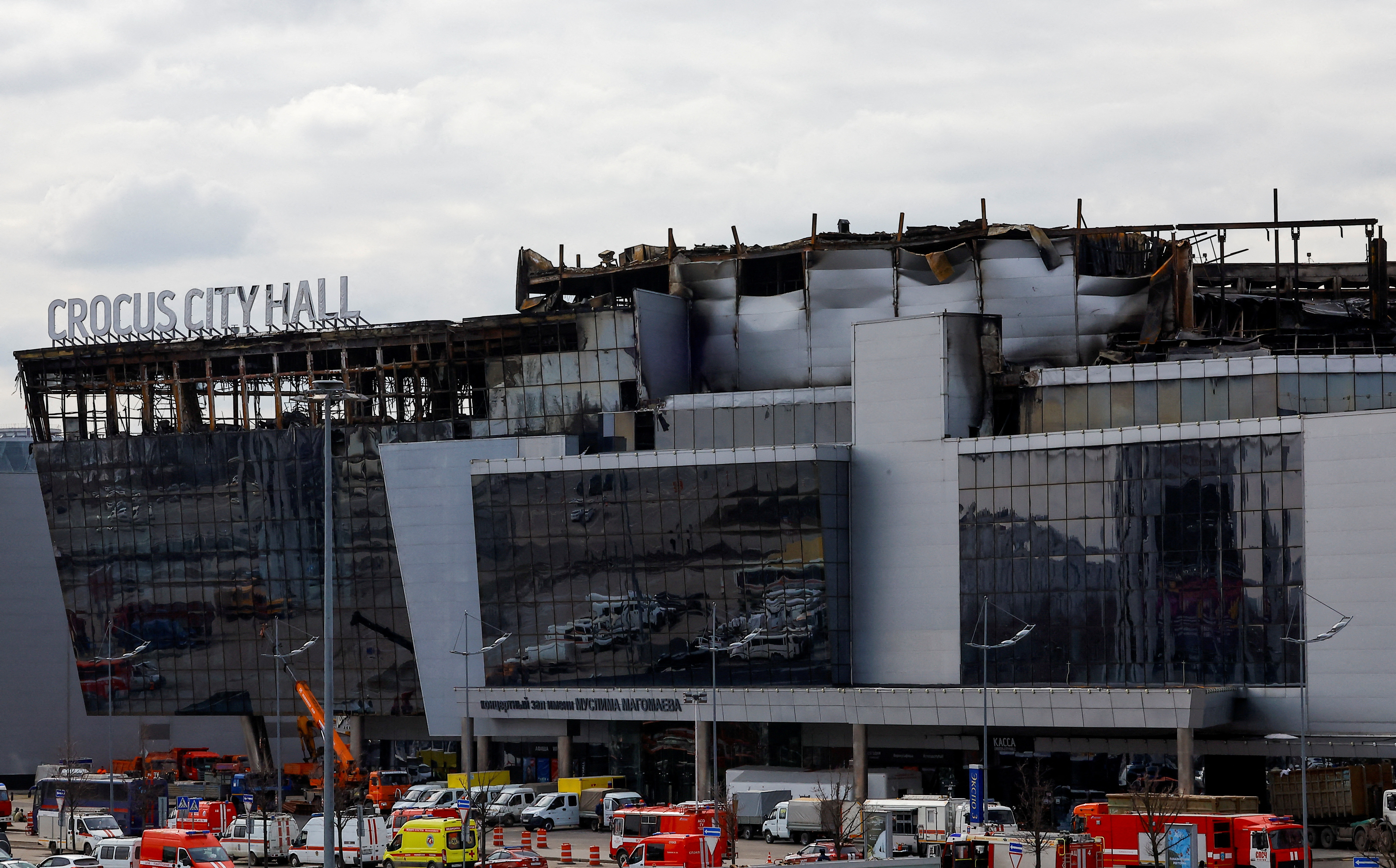
Biden speaks with Israel's Netanyahu after strike kills food aid workers
U.S. President Joe Biden spoke with Israeli Prime Minister Benjamin Netanyahu on Thursday, three days after Israel launched an attack that killed seven World Central Kitchen aid workers in Gaza, according to a source familiar with the matter.
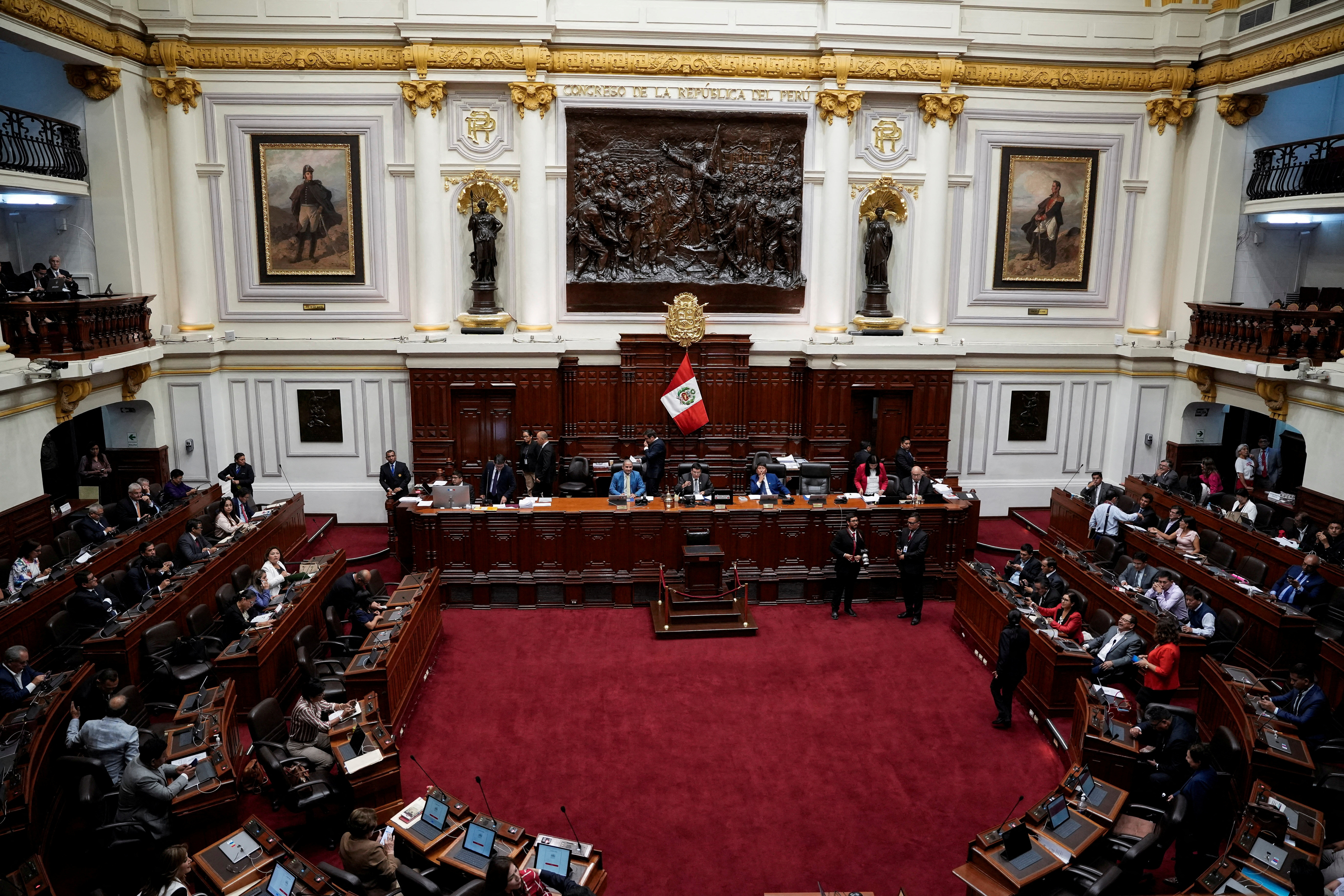

An official website of the United States government
The .gov means it’s official. Federal government websites often end in .gov or .mil. Before sharing sensitive information, make sure you’re on a federal government site.
The site is secure. The https:// ensures that you are connecting to the official website and that any information you provide is encrypted and transmitted securely.

FDIC Consumer News
Travel Tips: Bon Voyage
Vea esta página en español
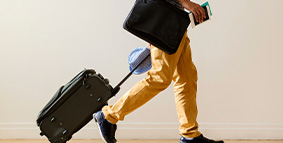
Safe travels with your money
Considering a vacation soon? In the rush of preparing for travel, it is easy to forget the steps you should take to protect your finances while you are away. Here are some ways to avoid money-related travel issues, save money on fees, and greatly improve your chances for a safe, pleasant journey.
Decide on the amount of cash or credit you may need on the trip
For your own security, it is not a good idea to take large sums of cash anywhere. If lost or stolen, you cannot replace it. Only carry enough cash for local transit, tips, and other small expenses. Use credit cards when you can, because they are readily accepted by merchants worldwide and can easily be replaced if lost or stolen. If you need cash fast, even in a foreign country, you can usually get it from an automated teller machine (ATM) using most of the same cards you use back home. Before you travel, ask your bank about any fees, such as an ATM or foreign transaction fees, they may charge for using your debit or credit card at your destination. Read more about Overdraft and Account Fees here . Some suggestions to consider:
- If you plan to get cash using a credit card at an ATM, you can incur hefty fees. Using your debit card to get cash from an ATM may cost you less.
If you’re traveling out of the country, when you pay for purchases, you are likely to fare better on the exchange rate (how much your U.S. dollars will be worth in a foreign country) if you use a credit card or a debit card (and choose the “credit” option) instead of converting your cash to local currency.
- If you do convert currency, the fee is usually the same whether you exchange $10 or $100, so convert larger, rather than smaller, amounts.
- Always exchange money in a safe place and put it away in your wallet or purse immediately. Divide and store your cash in multiple safe locations when you can. This can reduce the likelihood of losing all your cash in the event of theft.
- In addition to your bank (debit/ATM) card, take at least two major credit cards with available credit that should meet your foreseeable needs. If you are traveling internationally, make sure the cards you bring are widely accepted where you are going. Some cards are more widely accepted internationally than others. Leave unnecessary credit cards secured at home.
- If your card does not have foreign transaction and/or currency conversion fees when making purchases or taking money out of an ATM, choose the local currency during the process. Let your financial institution do the currency exchange, which will be more in your favor than if you convert the currency at the time of checkout.
Stash your valuables
Before leaving, consider putting jewelry and other valuable items in a safe deposit box at your financial institution. Other options may include a secured safe in your home or trusted relative or friends.
Copy important documents and make a list of important numbers
Make two copies of your passport identification page, driver’s license, vehicle registration, airline, or other tickets, and your itinerary. Leave one copy at home with a relative or friend, and carry the other one with you separately from the items themselves. Do the same with your list of important numbers, which might include phone numbers for your credit cards, bank, property insurance, and health insurance companies.
It is not a good idea to include credit card numbers or your Social Security number on this list, because the information could fall into the wrong hands, and be sure to carry the list with you; do not pack it.
Understand what credit card blocking is about
Credit card blocking most often occurs when you rent a car or check into a hotel and present your credit card. The clerk can electronically ask the bank that issued the card to “block” (reserve) part of your line of credit to cover the expected cost before you use it for other vacation purchases. If it is a hotel, what is usually blocked on arrival is the cost of your room for the length of stay, plus incidental expenses you may incur, like meals and phone calls. In the case of rental cars, it could be the cost of the rental plus fuel charges. There is nothing sinister or illegal about it, as long as the amount blocked is not out of line with what the customer is likely to pay at the end of the transaction.
If you leave on vacation with your credit card near the limit or if you are a business traveler who spends long periods on the road, you should be aware of credit blocking. Any additional transactions you attempt after you hit your credit limit could be rejected.
To learn more about credit card blocking, visit the Federal Trade Commission (FTC) webpage, When a Company Declines Your Credit or Debit Card .
Pay bills before you leave, if possible
You do not want essential services to be cut off while you are away on a long trip. Check the due dates on all bills, especially utilities and auto insurance, to see if payments will come due in your absence. If so, make those payments before you leave or pay them online from wherever you are (set a reminder and be mindful of time differences). Placing bills on auto pay may be an option too.
An upcoming trip is also a good reason to consider signing up for direct deposit, if you have not already done so. With direct deposit, you do not have to worry about possible theft of the checks by mail and you know the funds will be in your account on a certain date, a comforting thought whether you are away or at home.
Protect yourself from thieves and scammers who target travelers
Here are some precautions:
- Do not flaunt your cash, charge cards, fancy clothes or expensive jewelry (even expensive-looking jewelry). Robbers or thieves could be among the people you may be impressing. Avoid pickpockets by making sure your bag or purse is closed, and try to have it in front of you in your view whenever possible.
- Call your credit card companies to place a travel alert, so they know you will be out of town and can expect to see certain charges.
- Always take your credit and debit/ATM card receipts with you, and never give anyone your personal identification number (PIN). All contain information about your account that a thief can use to get cash or make purchases. If your cards are lost or stolen in the U.S. or abroad, immediately report this to your bank or card issuer. In general, federal law limits your liability for unauthorized charges on a credit or debit card if your card is lost or stolen, but you must notify the bank or card issuer within certain timeframes.
- At hotels, keeping your extra cash, jewelry, passport and other valuables in the hotel safe might add an additional level of security compared to leaving it out. However, some hotel safes may have a master key or a special override code to open the door. When a hotel safe has a way for someone other than you to get in, your stored items are not completely safe. Make sure you remember to take the valuables out of the safe when you leave.
- While you may not enjoy hanging out at airports, thieves do. They know airports are full of tired, hurried, or confused travelers carrying cash, credit cards and other valuables. This kind of theft usually occurs near ticket counters, X-ray machines, baggage check and claim areas, rest rooms or vending areas. The basic advice: stay alert.
Banks, card companies, express delivery services and other businesses are there to help
If the unexpected occurs, there are many ways to get emergency cash or arrange for payments practically anywhere in the world. A nearby bank can arrange for a cash advance using a major credit card; however, it is important to understand the fees and interest charges associated with the transaction. You also can ask the bank to have money transferred electronically from your bank or brokerage account back home. Alternatively, see if the bank can safely deliver traveler’s checks and money orders or wire funds to your hotel or other location. If your wallet is lost or stolen, call your bank or credit card issuers immediately to report any lost or stolen cards.
Keeping these tips in mind will help you avoid money-related issues during travel, save on fees, and reduce your stress, so you can enjoy a pleasant journey.
Additional resources:
FDIC, Credit Card Checks and Cash Advances
FTC, When a Company Declines Your Credit or Debit Card
FTC, Timeshares, Vacation Clubs, and Related Scams
FTC, Rental Listing Scams
For more consumer resources, visit FDIC.gov , or go to the FDIC Knowledge Center . You can also call the FDIC toll-free at 1-877-ASK-FDIC (1-877-275-3342). Please send your story ideas or comments to [email protected] . You can subscribe to this and other free FDIC publications to keep informed!

The Federal Register
The daily journal of the united states government, request access.
Due to aggressive automated scraping of FederalRegister.gov and eCFR.gov, programmatic access to these sites is limited to access to our extensive developer APIs.
If you are human user receiving this message, we can add your IP address to a set of IPs that can access FederalRegister.gov & eCFR.gov; complete the CAPTCHA (bot test) below and click "Request Access". This process will be necessary for each IP address you wish to access the site from, requests are valid for approximately one quarter (three months) after which the process may need to be repeated.
An official website of the United States government.
If you want to request a wider IP range, first request access for your current IP, and then use the "Site Feedback" button found in the lower left-hand side to make the request.
U.S. Department of the Treasury
Secretary of the treasury janet l. yellen to travel to the people’s republic of china.
WASHINGTON – From April 3-9, Secretary of the Treasury Janet L. Yellen will travel to the People’s Republic of China (PRC) for bilateral meetings and other engagements.
Secretary Yellen’s visit to China will build on the intensive diplomacy she has engaged in to responsibly manage the bilateral economic relationship and advance American interests. Following initial meetings with the PRC’s new economic team last July in Beijing, Secretary Yellen met with her counterpart Vice Premier He Lifeng in San Francisco, California, in advance of President Biden’s meeting with President Xi. At Secretary Yellen and Vice Premier’s direction, both sides jointly launched Economic and Financial Working Groups , which report to the Secretary and Vice Premier, and which have met three times.
In an April 2023 speech , Secretary Yellen laid out three principles guiding America’s economic relationship with the PRC. These principals continue to guide our engagement today. The United States proceeds with confidence in our economic strength thanks to our historically strong recovery and the investments the Biden Administration is making in America’s productive capacity. In the context of this relationship, America first seeks to secure our national security interests along with those of our allies and to protect human rights. Second, we seek a healthy economic relationship with China that provides a level playing field for American workers and firms. Finally, we also seek to cooperate where we can on key bilateral and global priorities.
During her engagements in China, Secretary Yellen will advocate for American workers and businesses to ensure they are treated fairly, including by pressing Chinese counterparts on unfair trade practices and underscoring the global economic consequences of Chinese industrial overcapacity. Secretary Yellen will also work to expand bilateral cooperation on countering illicit finance, which can drive important progress on shared efforts against criminal activity such as drug trafficking and fraud. In China, the Secretary will also engage her counterparts on critical work that benefits both the United States and China, as well as the world, including work to bolster financial stability, address climate change, and resolve debt distress among developing nations.
Trip Details
On Wednesday, April 3, Secretary Yellen will depart Washington, DC for Guangzhou, the People’s Republic of China. On Thursday, April 4, she will arrive in Guangzhou.
On Friday, April 5, in the morning, Secretary Yellen will hold a roundtable discussion with economic experts to discuss challenges and opportunities in the PRC’s economy. Secretary Yellen will then meet with Guangdong Governor Wang Weizhong. In the afternoon, Secretary Yellen will participate in an event with leading representatives of the American business community in China, hosted by AmCham China, and deliver remarks on the bilateral economic relationship. In the late afternoon, Secretary Yellen will begin extended bilateral meetings with Vice Premier He Lifeng.
On Saturday, April 6, Secretary Yellen will continue and then conclude a series of bilateral meetings with Vice Premier He. In the afternoon, Secretary Yellen will depart Guangzhou for Beijing.
On Sunday, April 7, Secretary Yellen will participate in a bilateral meeting with Premier Li Qiang. Later, Secretary Yellen will meet with Beijing Mayor Yin Yong. In the afternoon, Secretary Yellen will meet with students and professors at Peking University. In the evening, the Secretary will participate in a bilateral meeting with Finance Minister Lan Fo’an. While in Beijing, Secretary Yellen will also meet with leading Chinese economists.
On Monday, April 8, Secretary Yellen will meet with former Vice Premier Liu He of the People’s Republic of China. Later, she will hold a bilateral meeting with People’s Bank of China Governor Pan Gongsheng.
In the afternoon, Secretary Yellen will hold a press conference, during which she will deliver remarks discussing her trip to China. This press conference will be livestreamed here .
On Tuesday, April 9, Secretary Yellen will depart Beijing for Washington, DC. In the evening, she will arrive in Washington, DC.
More details will follow.
Cookies on GOV.UK
We use some essential cookies to make this website work.
We’d like to set additional cookies to understand how you use GOV.UK, remember your settings and improve government services.
We also use cookies set by other sites to help us deliver content from their services.
You have accepted additional cookies. You can change your cookie settings at any time.
You have rejected additional cookies. You can change your cookie settings at any time.
beta This is a test version of the layout of this page. Take the survey to help us improve it
- Help and services around the world
- UK help and services in Kyrgyzstan
Travelling to Kyrgyzstan
Includes travel advice and how to get married abroad.
Subscriptions
- Get emails for this topic Travelling to Kyrgyzstan
Getting married abroad
Requirements, paperwork and processes for weddings and civil partnerships overseas - registration, restrictions, fees
Kyrgyzstan travel advice
FCDO travel advice for Kyrgyzstan. Includes safety and security, insurance, entry requirements and legal differences.
Reduce your risk from terrorism while abroad
How to minimise your risk, and what to do if there's a terrorist attack.
Is this page useful?
- Yes this page is useful
- No this page is not useful
Help us improve GOV.UK
Don’t include personal or financial information like your National Insurance number or credit card details.
To help us improve GOV.UK, we’d like to know more about your visit today. We’ll send you a link to a feedback form. It will take only 2 minutes to fill in. Don’t worry we won’t send you spam or share your email address with anyone.

IMAGES
VIDEO
COMMENTS
Call us in Washington, D.C. at 1-888-407-4747 (toll-free in the United States and Canada) or 1-202-501-4444 (from all other countries) from 8:00 a.m. to 8:00 p.m., Eastern Standard Time, Monday through Friday (except U.S. federal holidays). See the State Department's travel website for the Worldwide Caution and Travel Advisories.
ABOUT E-VISA. Ministry of Foreign Affairs of Kyrgyzstan has launched e-Visa portal to facilitate visa issuance process for genuine travellers. Electronic visa application does not require more information than traditional paper application and it grants the same right to enter Kyrgyzstan territory as ordinary sticker-visa in the passport.
Living in Kyrgyzstan. Travelling to Kyrgyzstan. FCDO travel advice for Kyrgyzstan. Includes safety and security, insurance, entry requirements and legal differences.
US State Dept Travel Information - Overall information about foreign travel for US citizens. To obtain an international driving permit (IDP). Only two organizations in the US issue IDPs: American Automobile Association (AAA) and American Automobile Touring Alliance (AATA) How to get help in an emergency?
Air Travel: All non-U.S. citizen, non-U.S. immigrants traveling to the United States by air are required to show proof of being fully vaccinated against COVID-19. Only limited exceptions apply. Learn more about this requirement and accepted vaccines .
You can enter Kyrgyzstan as a visitor for stays of up to 60 days without a visa. You must not stay more than 60 days in any 120-day period. To stay longer (to work or study, for business travel or ...
If you get into difficulties due to the actions of state bodies, you can also contact the Kyrgyzstan ombudsman (in Russian and Kyrgyz). FCDO travel advice for Kyrgyzstan. Includes safety and ...
2. Do I need a visa to travel to Kyrgyzstan? Kyrgyzstan has the most liberal visa regime in Central Asia. Citizens from Europe, North America, Australia, New Zealand, Japan, South Korea, Singapore, Brunei, Qatar, Bahrain, Kuwait, UAE and Saudi Arabia can visit the country for up to 60 days within 120 days without a visa.. Citizens from Mongolia and Ukraine can stay up to 90 days within 180 ...
Official U.S. government health recommendations for traveling. Provided by the U.S. Centers for Disease Control and Prevention (CDC). ... Kyrgyzstan Healthy Travel Packing List. Pack items for your health and safety. You may not be able to purchase and pack all of these items, and some may not be relevant to you and your travel plans. Talk to ...
Best Time to Visit Kyrgyzstan. Travelling to Kyrgyzstan is limited to the warmer months if trekking is your goal. The ideal time is June to early September. However, even in June, you may find some routes and passes are closed especially if the preceding winter was a long and harsh one.
All international travelers should be fully vaccinated against measles with the measles-mumps-rubella (MMR) vaccine, including an early dose for infants 6-11 months, according to CDC's measles vaccination recommendations for international travel. Rabid dogs are commonly found in Kyrgyzstan.
The Nomad Games, World Nomad Games, and Kyrgyzstan's Independence Day celebrations are just a few examples of the vibrant festivities that showcase the country's traditions, arts, and sports. Kyrgyzstan's tourism industry is growing, and the government has taken steps to facilitate travel to the country.
When you travel in Kyrgyzstan, you will see that towns are merely used as a base to explore the mountains or take a rest from them. 📚 Books for traveling to Kyrgyzstan. For more books to Kyrgyzstan and Central Asia, check: The best 28 books on Central Asia. Kyrgyzstan Travel Guide by Bradt.
The good news for travel to Kyrgyzstan is that it's visa-free for a growing number of passports. Passport holders from 69 different nations are not required to obtain a visa in advance for travel to Kyrgyzstan for travel up to the length of 30, 60 or 90 days. It is also possible for a lot of those nations to arrange a visa on arrival for an ...
Citizens of the Maldives have a 30-day visa-free regime for all types of travel documents. Welcome to the Kyrgyzstan Official Electronic Visa Portal! Visa to Kyrgyzstan for Tourist or Business. Apply now online. Easy, safe and fast application process.
E-visa - Ministry of Foreign Affairs of Kyrgyzstan; Regional travel. You must obtain a special permission from Chinese authorities if you are travelling onward to China from Kyrgyzstan. Children and travel. Learn more about travelling with children. Yellow fever. Learn about potential entry requirements related to yellow fever (vaccines section).
Irish citizens do not require a visa to enter Kyrgyzstan for up to 60 days. A valid passport is required for travel to Kyrgyzstan. Irish passports should have a minimum validity of 6 months prior to entry. Passport cards cannot be used. For more information on entry requirements for Kyrgyzstan, please contact the Embassy of Kyrgyzstan in London.
FCDO travel advice for Kyrgyzstan. Includes safety and security, insurance, entry requirements and legal differences.
Upcoming Updates to Goods and Services. With the releases of the "U.S. International Trade in Goods and Services" report (FT-900) and the FT-900 Annual Revision on June 6, 2024, statistics on trade in goods, on both a Census basis and a balance of payments (BOP) basis, and statistics on trade in services will be revised beginning with 2019.
Kyrgyzstan's foreign ministry has urged its citizens to put off unnecessary travel to Russia after a deadly mass shooting at a concert hall near Moscow that was blamed on migrants from Central Asia.
For more consumer resources, visit FDIC.gov, or go to the FDIC Knowledge Center. You can also call the FDIC toll-free at 1-877-ASK-FDIC (1-877-275-3342). Please send your story ideas or comments to [email protected]. You can subscribe to this and other free FDIC publications to keep informed!
In this document, CBP is announcing an increase in the application fee for the NEXUS program and a change in the NEXUS application fee for certain minors. This change to the NEXUS program is being made simultaneously with changes to the Global Entry and Secure Electronic Network for Travelers...
U.S. Special Envoy for Yemen Tim Lenderking is traveling to Saudi Arabia and Oman this week to meet with partners to discuss the need for an immediate cessation of Houthi attacks in the Red Sea and Gulf of Aden, which are undermining progress on the Yemen peace process and the delivery of humanitarian assistance to […]
WASHINGTON - From April 3-9, Secretary of the Treasury Janet L. Yellen will travel to the People's Republic of China (PRC) for bilateral meetings and other engagements.Secretary Yellen's visit to China will build on the intensive diplomacy she has engaged in to responsibly manage the bilateral economic relationship and advance American interests. Following initial meetings with the PRC ...
TRAVEL ADVISORY -- REMINDER: Second Phase of PATH Grove St. Station ...
Governor Kathy Hochul today urged New Yorkers to prepare for hazardous weather, dangerous travel conditions and potential power outages as a long duration storm is forecast to impact the state with periods of rain through Friday for areas in Western New York, the Southern Tier, the Mid-Hudson Region, and New York City and Long Island.
Kyrgyzstan travel advice. FCDO travel advice for Kyrgyzstan. Includes safety and security, insurance, entry requirements and legal differences.
The Office of Management and Budget announced Thursday changes to how the federal government asks about people's race and ethnicity, including in the US Census. CNN values your feedback 1.